2 Volumes
Constitutional Era
American history between the Revolution and the approach of the Civil War, was dominated by the Constitutional Convention in Philadelphia in 1787. Background rumbling was from the French Revolution. The War of 1812 was merely an embarrassment.
Rt. Angle by Years
The history of Philadelphia"s finest men's club.
Right Angle Club: 2013
Reflections about the 91st year of the Club's existence. Delivered for the annual President's dinner at The Philadelphia Club, January 17, 2014. George Ross Fisher, scribe.
To My Fellow Right Anglers
Greetings, Right Anglers, and be of good cheer
We have just completed our 91st year
But there is no cause to fear
President's Letter for 2013

|
| Daniel Sossaman |
Dear Right Anglers,
Another successful Right Angle year is ending, our 91st year, and the start of our 92nd year. Forty-two successful luncheon meetings full of good camaraderie, good cheer, good food, good jokes (thanks to Tom Howes), good speakers (thanks to Carter Broach) and a good time was had by all. The issue of where we would meet in the Racquet Club was resolved. We still meet in the good old Rathskeller every Friday at 12:33.Thanks to Jack Foltz, First Vice President. for his advice and counsel throughout the year. Jack is foregoing the President's position for 2014 to take care of personal issues. He would have made a great president, perhaps, next year.
Our Second Vice President Dave Richards, events chair, ran three excellent events. The Spring Fling at Harriton House took place on a rainy day just perfect for an English garden party. The pig was great. And we all had the opportunity to tour Harriton House. Our Fall Fling was on the USS Olympia. We enjoyed good weather, good food and drink on the fantail. A tour of the Olympia topped the day. Those of us of a limber nature crawled through the submarine USS Becuna, what a treat. Our Christmas party at the "cozy" Italian restaurant ended the events year in fine fashion. Once again, fine food, good drinks, and our own good company. What more could we have asked for, "Crackers!" We got them with a bang. Thanks, David!
,p> Third Vice President, Carter Broach, our speaker chair, did not run out of friends, fellows, and acquaintances to treat us to forty-two Fridays of outstanding speakers. We were well entertained and enlightened on a myriad of topics. Our speakers continued to receive our coveted Right Angle plate along with some appropriate comments.Our Fourth Vice President, Dan Sossaman II, ran an honest raffle. At least two of us were happy every Friday. The rest of us looked forward to the next Friday to see what fate would bring us. Our charity received a nice check from our raffle receipts. Neale Bringhurst, our corresponding secretary, kept us informed and up to date on our next month's speakers on a timely basis. He also kept us advised of new members elected.
Mel Buckman, our Recording Secretary, kept timely and accurate minutes of our board meetings. No issues with Mel's minutes. Our Treasurer, Rod Rothermel, kept us informed and up to date on our financial matters and Treasury Department. His cogent comments concerning receipts, expenses, and planned expenditures keep our finances in line. Rod is stepping down as Treasurer after many years of true and faithful service. Rod always kept us informed, enlightened and entertained as to our financial condition. He will be missed.
Our board members, David McCormick Archivist, Bill Hill, Tom Williams, Wayne Strausbaugh, and Ted Laws were vital members of the board. Their wise counsel and advice was evident at all board meetings.
The Racquet Club continues to provide an outstanding mid-day repast. Even though retired, Rosie faithfully served our needs at all our Friday luncheons and meetings.
We continued to have at least one evening meeting and one new member cocktail party. It is hoped the evening meetings and new member events will continue.
A number of new members joined this year and our membership continues strong (though we will always need a few more good men). Past president, John White, continued to run our constant contact service for all our events. This continues to make signing up for the flings a quick and easy process. John should be thanked by all.
Finally, Leanne Lindsey should be remembered for all she does in supporting our "back room" operations. This year's nominating committee was chaired by Past President, John Fulton ably assisted by Ed Ermilio and Dick Pascal. They have recommended a fine slate of new officers and Board members for next year. With David Richards taking over as President, we should have an outstanding 92nd year.
Your Most Obedient Servant,
Daniel Maguire Sossaman, SR
Sergeant Major USA (Ret)
91st President
Ruminations About the Children's Education Fund (3)
The Right Angle Club runs a weekly lottery, giving the profits to the Children's Educational Fund. The CEF awards scholarships by lottery to poor kids in the City schools. That's quite counter-intuitive because ordinarily most scholarships are given to the best students among the financially needy. Or to the neediest among the top applicants. Either way, the best students are selected; this one does it by lottery among poor kids. The director of the project visits the Right Angle Club every year or so, to tell us how things are working out. This is what we learned, this year.
The usual system of giving scholarships to the best students has been criticized as social Darwinism, skimming off the cream of the crop and forcing the teachers of the rest to confront a selected group of problem children. According to this theory, good schools get better results because they start with brighter kids. Carried to the extreme, this view of things leads to maintaining that the kids who can get into Harvard, are exactly the ones who don't need Harvard in the first place. Indeed, several recent teen-age billionaires in the computer software industry, who voluntarily dropped out of Harvard seem to illustrate this contention. Since Benjamin Franklin never went past the second grade in school perhaps he, too, somehow illustrates the uselessness of education for gifted children. Bright kids don't need good schools or some such conclusion. Since dumb ones can't make any use of good schools, perhaps we just need cheaper ones. Or some such convoluted reasoning, leading to preposterous conclusions. Giving scholarships by lottery, therefore, ought to contribute something to educational discussions and this, our favorite lottery, has been around long enough for tentative conclusions.

|
Just what improving schools means in practical terms, does not yet emerge from the experience. Some could say we ought to fire the worst teachers, others could say we ought to raise salary levels to attract better ones. Most people would agree there is some level of mixture between good students and bad ones. At that point, the culture mix becomes harmful rather than overall helpful; whether just one obstreperous bully is enough to disrupt a whole class or something like 25% of well-disciplined ones would be enough to restore order in the classroom, has not been quantitatively tested. What seems indisputable is that the kids and their parents do accurately recognize something desirable to be present in certain schools but not others; their choice is wiser than the non-choice imposed by assigning students to neighborhood schools. Maybe it's better teachers, but that has not been proved.

|
It seems a pity not to learn everything we can from a large, random experiment such as this. No doubt every charity has a struggle just with its main mission, without adding new tasks not originally contemplated. However, it would seem inevitable for the data to show differences in success among types of schools, and among types of students. Combining these two varieties in large enough quantity, ought to show that certain types of schools bring out superior results in certain types of students. Providing the families of students with specific information then ought to result in still greater improvement in the selection of schools by the students. No doubt the student gossip channels already take some informal advantage of such observations. Providing school administrations with such information also ought to provoke conscious improvements in the schools, leading to a virtuous circle. Done clumsily, revised standards for teachers could lead to strikes by the teacher unions. Significant progress cannot be made without the cooperation of the schools, and encouragement of public opinion. After all, one thing we really learned is that offering a wider choice of schools to student applicants leads to better outcomes. What we have yet to learn, is how far you can go with this idea. But for heaven's sake, let's hurry and find out.
U.S. Army Corps of Engineers in the Delaware Valley
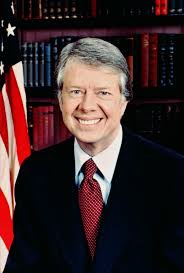
|
It seems unlikely a peanut farmer from Georgia would have much interest in Philadelphia, let alone the activities of its local Army Corps of Engineers. But it seems there is some sort of story, there. An acquaintance chairing a local meeting of Americans for Democratic Action at the time remembers an episode dating from the 1976 presidential nominating campaign. Morris Udall was the main opponent of Jimmy Carter for the Democrat nomination. You might suppose an out of town politician would have instincts tell him to be nice to the local mayor of his own party, but Jimmy Carter went out of his way to attack Frank Rizzo. Udall took the path of conventional wisdom and refrained from joining Carter in the attack. Since Pennsylvania votes were considered pivotal in that particular race, it was watched with considerable interest. But to the surprise of the insiders, Carter won the Pennsylvania votes, suggesting that hidden animosity to Rizzo was extensive. Furthermore, from that event, it would be possible to suppose either of two conclusions. Either Carter would be grateful to Pennsylvania for putting his nomination over the top, or else he had some sort of grievance against Rizzo.
Subsequent events suggest he had a grievance, but it would be very hard to imagine where the two would even have met each other in the past. More likely, he made some slighting remark to an aide, who took it on himself to curry favor when in fact Carter had forgotten all about it.

|
| U.S. Army Corps of Engineers |
In any event, the local division of the Army Corps of Engineers went into some sort of decline, dating from about that time, which might well have been over-reacting to the so-called Love Canal episode. The chief of the division was to have no higher rank than Lt. Colonel. The activities of the division had been centered on building dams and flood control projects but began to be mostly environmental protection, particularly repair of hurricane-damaged ocean beaches. The headquarters was moved from the Custom House to the Wanamaker Building because the personnel and budget had declined. There was the talk of merging the district with another district. The Delaware Division is the smallest district in the country, almost difficult to find on a map whereas some other districts enclose eight states. When you get more states you get more Senators, so you get more budget, and so on. It was sad that the Navy and Marines were founded here, the Revolution and the War of 1812 caused many fortifications to be centered here, the capital of the country. From that point to the present, there has been a long decline. It was particularly painful that West Point is primarily an engineering college, with a tradition that the top five percent of every class is offered a place in the Corps of Engineers. In Army politics, it is clear that a heavy proportion of the generals were West Point graduates, just as it is almost exclusively true that all admirals have Annapolis in their background. Jimmy Carter went to Annapolis, but so what?

|
| Love Canal |
Rather than follow a line of thought which leaves many uncomfortable, perhaps it is more relevant to notice that all of our rivers seem to be drying up. Colorado and the Rio Grande are mere trickles, the Mississippi now has wide banks of mud. Delaware has long been recognized as having a wide mouth and a short length, reflecting its origin as a small river emptying (at Trenton) into a wide bay which is really the back bay of the huge barrier peninsula of Southern New Jersey. What might have been its extensive watershed runs instead into the Susquehanna, about a hundred miles north of Philadelphia, probably because of volcanic shifts? But what was once a thriving port has dwindled as a result of labor troubles and some unfortunate legislation. That's where the number of Senators in your district makes a difference.

|
| Panama Canal |
Wilmington, Delaware has the largest port for bananas in the nation; Delaware points southward, toward all of Latin America. The Chinese are financing, and probably engineering, a widening of the Panama Canal to accommodate giant container ships that now can't get through. The first port on the Atlantic seaboard to deepen its harbor accordingly, will probably get first-mover advantage and hold it because it is expensive to play catch up. Philadelphia is about half-finished in the deepening of the channel to forty-five feet. But New York's deepening of the Hudson is almost complete. New Jersey politics involves both channels on its north and south borders, but New Jersey has long since thrown in its lot with New York. Now that it probably won't matter, the Pennsylvania dredging will probably be permitted to finish. If that happens, the only hope for Philadelphia in the race to be a big container port will depend on a recession in China slowing down their import traffic until we catch up. After all, Philadelphia is blessed with an almost world-unique combination of rail, highway, airport, and ocean shipping interchanges at a single point, on relatively undeveloped land close to a major city. Without wishing any evil on China, we do have to wish they would encounter some reason to slow down for us. Slow down, that is until our natural advantages can overcome the foibles of our politicians.
Wistar Institute, Spelled With an "A"
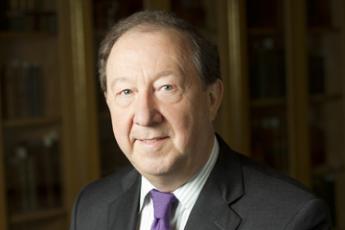
|
| Dr. Russel Kaufman |
The Right Angle Club was recently honored by hosting a speech by Dr. Russel Kaufman, the CEO of the Wistar Institute. Dr. Russel is a charming person, accustomed to talking on Public Broadcasting. But Russel with one "L"? How come? Well, sez Dr. Kaufman, that was my idea. "When I was a child, I asked my parents whether the word was pronounced any differently with one or two "Ls", and the answer was, No. So if I lived to a ripe old age, just think how much time and effort would be wasted by using that second "L". In eighty years, I might spend a whole week putting useless "Ls" on the end of Russel. I pestered my parents about it to the point where they just gave up and let me change my name". That's the kind of guy he is.

|
| The Wistar Institute |
The Wistar Institute is surrounded by the University of Pennsylvania, but officially has nothing to do with it. It owns its own land and buildings, has its own trustees and endowment, and goes its own academic way. That isn't the way you hear it from numerous Penn people, but since it was so stated publicly by its CEO, that has to be taken as the last word. It's going to be an important fact pretty soon since the Wistar Institute is soon going to embark on a major fund-raising campaign, designed to increase the number of laboratories from thirty to fifty. The Wistar performs basic research in the scientific underpinnings of medical advances, often making discoveries which lead to medical advances, but usually not engaging in direct clinical research itself. This is a very appealing approach for the many drug manufacturers in the Philadelphia region, since there can be many squabbles and changes about patents and copyrights when the commercial applications make an appearance. All of that can be minimized when fundamental research and applied research are undertaken sequentially. Philadelphia ought to remember better than it does, that it once lost the whole computer industry when the computer inventors and the institutions which supported them got into a hopeless tangle over who had the rights to what. The results in that historic case visibly annoyed the judge about the way the patent infringement industry seemingly interfered with the manufacture of the greatest invention of the Twentieth century.
Patents are a tricky issue, particularly since the medical profession has traditionally been violently opposed to allowing physicians to patent their discoveries, and for that matter, Dr. Benjamin Franklin never patented any of his many famous inventions. But the University of Wisconsin set things in a new direction with the patenting of Vitamin D, leading to a major funding stream for additional University of Wisconsin research. Ways can indeed be devised to serve the various ethical issues involved since "grub-staking" is an ancient and honorable American tradition, one which has rescued other far rougher industries from debilitating quarrels over intellectual property. You can easily see why the Wistar Institute badly needs a charming leader like Russel, to mediate the forward progress of our most important local activity. From these efforts in the past have emerged the Rabies and Measles vaccines, and the fundamental progress which made the polio vaccine possible.
It was a great relief to have it explained that there is essentially no difference at all between Wisters with an "E" and Wistars with an "A". There were two brothers who got tired of the constant confusion between them, see and agreed to spell their names differently. When the Wistar Institute gathered a couple of hundred members of the family for a dinner, the grand dame of the family declared in a menacing way that there is no difference in how they are pronounced, either. It's Wister, folks, no matter how it is spelled. Since not a soul at the dinner dared to challenge her, that's the way it's always going to be.
Musical Theatre at the 11th Hour

|
| Michael O'Brien |
Philadelphia is having a theatrical revival, very likely leading the cities of America in that regard. One of the central movers and shakers of that movement visited the Right Angle Club recently. Touting his own company, without a doubt, but nevertheless illuminating a movement which seems pretty central to Philadelphia's future. Michael O'Brien is the Producer and Artistic Director of the 11th Hour Theatre Company, which had its origin eight years ago in the Studio of the Walnut Street Theatre, and has since spread out to many venues within Philadelphia. Since Mike O'Brien got his start in theater at the Walnut, it is only fair to say the Walnut Street Theatre was a parent of the 11th Hour. The 11th Hour is a 501(c) (3) nonprofit corporation, so it sort of sounds as though the William Penn Foundation was somewhere in the background, at least at one time.
The 11th Hour Theatre Company is one of 1200 theater companies now active in Philadelphia but is the only company dedicated exclusively to musicals. More finely tuned than that, it specializes in small productions with five or six members of the orchestra, and about the same number of actor/singers on stage. It happens there aren't very many such productions to chose among, so someone must stimulate more composers to pay attention, or the 11th Hour could run out of musicals to produce. Some of this is economic. The kind of big-time musical comedy which makes a gazillion dollars with a huge cast, huge orchestra, huge scenery is very expensive to produce, and probably soon runs out of audience members who are willing to pay huge ticket prices for anything except a huge production success, produced at huge financial risk. For the most part, the national market will only profitably support one or two of those a year, with the consequence that lots of people lose a lot of money on the ones which fail, and most of the successes are rescued by movie and television revenue, which involve further financial risk-taking. Apparently, the successful composers either try to claw their way to the big brass ring or else look for other lines of work. Someone may eventually figure out a way to start with a small musical and then scale it up to the big-time, but what has happened seems to be that actors and musicians who shrug off the big time, cluster together and try to produce a career which prefers a normal sort of home life, to the neurotic struggling which seems inherent in those who consider themselves big-time theatrical material. Somehow, the dictionary definition of the 11th Hour -- the time when most creativity appears -- has instant appeal to the sort of person who prefers to live a normal life within a close circle of like-minded friends and finds that to be a possibility in Philadelphia. We'd like to remind him you can't fill the seats of a theater without an enthusiastic audience, but it's nice to hear our town is a congenial place to live and be an actor.

|
| 11th Hour Theater |
Michael O'Brien regards the theatrical revival of Philadelphia to be part of the restaurant revival of the 1980s. Just as the nightlife of Philadelphia was once centered around coming to town to go to the movies, Mr. O'Brien regards the theater as the centerpiece of an evening in town for a couple who want to come for exotic food, plus some entertainment. We have night clubs and celebrity concerts for the dating set, but a quiet dinner followed by the theater appeals to a different, somewhat older set. Once this movement gets started, performers arrive from out of town and discover they like the sort of life entertainers enjoy here, so they stay. And many graduates of local colleges and universities grow up close enough to the scene that they decide they never want to leave. Naturally, a producer and artistic director has the perspective of the performing community and tends to emphasize the attractiveness of Philadelphia to performers. In addition to that, of course, enough dumb old plain citizens have to be attracted to the theatrical product, in order to provide audiences for 1200 theatrical companies; and novelty alone is not enough to sustain that. Some such mutual need was once provided by the sudden Elizabethan flowering of the theater of London, and five hundred years later no one has completely explained it. But for comparison, in Shakspere's day, there were fifty-nine London theaters at the height of the Elizabethan boom, but only two in Paris.
Wizards of the Wissahickon
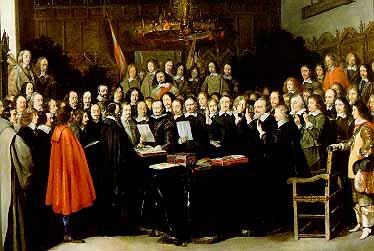
|
| Peace Treaty of Westphalia |
The Holy Roman Empire comprised about 120 little kingdoms along the Rhine River, mostly Germanic, stretching from Amsterdam to Switzerland, and loosely associated with the Papal States extending onward to Sicily. Napoleon and Bismark unified much of this territory into what we might now recognize as a map of Western Europe. Before that, it had been roughly the battleline between Catholic and Protestant populations, provoked by the influence of Martin Luther spreading through what had for centuries been an entirely Catholic region. After the Treaty of Westphalia in 1648, it became a rule of the Holy Roman Empire that the state religion of a country was whatever the local king said it was.
With this history and more, it is unsurprising that the region was filled with small stranded religious sects who were out of local secular favor. William Penn's mother was Dutch, so he could speak the local language and had lived in the region. When this immensely rich Englishman acquired the colony of Pennsylvania, it was natural for him to offer religious sanctuary to Germanic sects as well as to the dissident Quakers of England, in that free-religion colony he planned for his wilderness region, larger than the whole of England.

|
| Johannus Kelpius |
From this history it emerges that "Dominie Johann Jacob Zimmerman, a noted German mathematician, astronomer, and defrocked Lutheran minister", led a remarkably well-educated group of "Pietists, millennialists, Rosicrucians, and Separatists" to London and then to Rotterdam, picking up some Swiss, Transylvanians, Swedes and Finns. Among them was a young Transylvanian scholar originally named Kelp, which in scholarly tradition had changed to Johannus Kelpius. Responding to the astronomical calculations of Zimmerman, it was believed the millennium of peace and tranquility predicted by the Book of Revelations would begin more or less immediately. The group resolved to accept the offer of William Penn and go to Pennsylvania to enjoy that millennium. Unfortunately, Zimmerman died as the ship was departing and young Kelpius, who himself was later to die of tuberculosis at the age of 34, was appointed the new leader.

|
| Kelpius Cave |
Evidently, on arrival in Philadelphia in 1694, they encountered earlier inhabitants who had a tradition of a bonfire midway between the solstice and the equinox. Their fire was on top of "Fire Mount", and was taken as a sign that the millennium was now beginning. The group moved up to the top of the Wissahickon, next to where Rittenhousetown is now to be found, and just beyond it in Roxborough was a hollowed out formation resembling an amphitheater. It is now believed an astronomical observatory was created on the projecting rock next to the present foot of the Henry Avenue bridge; it was at that place that two celibate monasteries (for men and for women) lived together, slowly dying out as celibate communities necessarily do. Eventually, the death of Kelpius caused the final break-up of the little colony, but not before it had established itself as a center of music, poetry, and literature for the growing Germanic settlers of the surrounding states. One group of them went further west to the Cloister at Ephrata, and others scattered in different directions. It is notable that a great many names of settlers in the Kelpius colony are still to be found in Germantown, Philadelphia, and Harrisburg, although tracing the genealogy has been difficult. Some of the music has been found in scraps and reconstructed, and discovered to be quite sophisticated and beautiful, although precise authorship remains uncertain.
REFERENCES
| An Introduction to the Music of the Wissahickon Glen: Lucy E. Carroll, DMA, | Kelpius Society |
| The Hymn Writers of Early Pennsylvania: Lucy E. Carroll, ISBN: 978-1606475201 | Amazon |
John Marshall Decides Three Cases
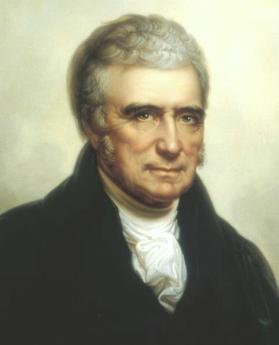
|
| Chief Justice John Marshall |
John Marshall, taking sixteen years to do it, transformed the Constitution internally into the cornerstone of the Rule of Law, making the legal profession its guardian. Nine respected justices now essentially hold lifetime appointments as bodyguards of the structure Marshall designed, with all lawyers acting as lesser officers. Nevertheless, four personal things are important to remember. Marshall had been a Revolutionary soldier, he wrote a five-volume biography of George Washington, he positively hated his first cousin Thomas Jefferson. And his thirty-five-year tenure as the third Chief Justice of the U.S. Supreme Court coincided with some of the dirtiest national politics the nation has ever seen. Marshall's enthronement of Chief Justice control of the federal courts was tolerated because it promoted them both to national power. And when this tough politician had earned the loyalty of both the court system and the legal profession to himself, he transformed the image of the Constitution from a contract between the states into an American Bible for the Rule of Law. Incidentally, he could beat anyone at horseshoes, a game requiring a winner to be both strong and precise. Much of his achievement grows out of three pivotal Supreme Court cases, which today might just as well be regarded as amendments to the Constitution.
 In all Cases affecting Ambassadors, other public Ministers and Consuls, and those in which a State shall be Party, the Supreme Court shall have original Jurisdiction. In all the other Cases before mentioned, the Supreme Court shall have appellate Jurisdiction 
|
| Article 3, Section 2.3 |
Marbury v Madison (1803). The first of Marshall's three cornerstone cases involved the Chief Justice himself. After being defeated for reelection to the Presidency in 1800 by Thomas Jefferson, President John Adams hastened to fill up remaining judicial vacancies before Jefferson his successor could be inaugurated, in a maneuver described as "appointing midnight judges". In a sense, Marshall's appointment as Chief Justice had also been in anticipation of the coming eviction of Federalist office holders, so he was himself more or less a midnight judge, destined to become by many years the last Federalist to survive in office. In any event, he was Adams' Secretary of State, soon to be replaced by James Madison, who would then assume the duty to deliver judicial appointment papers to new judges. Marshall was an impassioned Federalist, bitter about the defeat of his party, nursing personal hatred for Jefferson after years of family differences. To say he had a conflict of interest is not only to brush hurriedly by the issue but also to dramatize what loose judicial standards prevailed at the beginning of his three-decade tenure as Chief Justice.
Appointment papers for the midnight judges were completed and lying on the desk of the Secretary of State when the Presidency changed hands from Adams to Jefferson. Had he known what was coming, Secretary of State Marshall would surely have hastened to deliver the papers, but he had not done so. His successor as Secretary of State, James Madison, on the orders from Jefferson, refused to do it, so Marbury sued for a writ of mandamus, or order from a court to deliver the documents. By this time, Marshall was in a new role of presiding over the Supreme Court, fearful to attack Jefferson head on, but nevertheless eager to command the most humiliating obedience from him. Using the technicality (actually, the plain language of the Constitution) that the request was made to the wrong court, mandamus was rejected by Marshall. However, he went on to say in a judicial aside (obiter dictum) that if the right request had come to the U.S. Supreme Court properly , the Court would have approved it. Thus, in one dazzling maneuver at the beginning of his term, Marshall simultaneously asserted the Court's right to review Presidential and Legislative actions, reproved Jefferson for his ignorant conduct, and boxed him into submission by seemingly letting him win a minor case, but one he could be sure would soon have been followed by major ones if the President somehow evaded this decision. Furthermore, he dazzled the legal profession with this tap-dance, guaranteeing their applause by greatly enhancing the status of judges within the Republic, especially compared with the President. And, it should be mentioned, he suppressed public outcry by performing this set of actions in full public view, cloaked within incomprehensible legal garments. The public could see he had done something important, which only lawyers would completely understand. Marshall plainly began his term by demonstrating the full meaning of the rule of law, and his own position astride that law. The main point was that when ordinary judges include offhand commentary in a decision, it might be ignored. But when the Chief Justice of the United States speaking for the majority of his court, makes a legal observation, it would be a brave lawyer indeed who would bring an action in conflict with it. And as for the President and Legislature, Marbury v Madison had also just brushed them aside. It was all done properly, using civil language but deadly logic.
Martin v Hunter's Lessee (1816). This case might be a little more understandable if retitled as "The Heirs of Lord Fairfax v Fairfax County, Virginia". A Virginia law permitting the seizure of Tory property, written decades before the Constitution, asserted its precedence to Federal Law, and therefore its precedence over Federal Law. (To this day, Virginia never quite forgets it was once the largest, richest state, founded nearly two centuries before the Constitution.) Like Marbury v Madison, the case is clouded by Marshall's personal involvement since the Chief Justice had signed a contract with Martin to buy the land himself. This impairment to the case's claim to legal cornerstone status is not entirely annulled by Marshall recusing himself, turning authorship of the opinion over to his faithful disciple Justice Story. Furthermore, the judicial establishment of the principle that an international Treaty (in this case, the Jay Treaty) takes precedence over an Act of Congress is one the nation may still someday come to regret, if movements for "International human rights" and "universal international law" continue to gain popular traction. Such movements are numerous, including international law for the conduct of wars, and the universal Law of the Sea.
The United Nations might now be more of a force if they had not stumbled over the franchise of hundreds of nations, each given an equal vote. To expect the major nations of the Security Council to obey the single-vote mandates of dozens of small African nations is to agree in advance that the UN must be disregarded. Nevertheless, Martin v Hunter's Lessee did eliminate an escape route from Supreme Court domestic domination which might have proved troublesome in Civil War nullification disputes, or in legal cases for which national uniformity is important. On appeal, the Supreme Court finally declared its absolute supremacy over State courts as a general matter, clarifying a number of legal loose threads which had been keeping the precedence issue alive.
McCullough v Maryland 1819) The facts of this case seem considerably simpler than Marshall's long and thundering opinion of them. Indeed, the opinion sounds more like an oration on the meaning of the Constitution, or an enraged obiter dictum , than a terse opinion that the State of Maryland's legislature had passed an unconstitutional law. His remarks are indeed an exposition on the general thrust of the Constitution, foreshadowing many disputes leading up to the Civil War. In effect, it began to make it clear to the slave states that their states-rights viewpoints might conceivably be upheld on a battlefield, but never in a Courtroom. It is thus an opinion which every law student should read several times, and every citizen would profit from reading at least once. At Gettysburg Abraham Lincoln was to restate the principles in concise, even poetic, language. But long before that, Marshall had stood upon a legal mountain, declaiming them in thundering detail.
 The Congress shall have power---To make all Laws which shall be necessary and proper for carrying into Execution the foregoing Powers, and all other Powers vested by this Constitution in the Government of the United States, or in any Department or Officer thereof. 
|
| Article 1, Section 8, clause 18 |
The United States Congress had chartered the Second Bank of the United States in 1816, which then established a Baltimore branch in 1818. There was a national financial panic in 1818, which probably hastened local bank lobbyists to the Maryland Legislature, looking for relief from the unwanted federal competition. Maryland passed a law imposing a fairly high state tax on the operations of the new federal bank. McCullough, the cashier of the federal branch bank, refused to pay the tax. On appeal, McCullough maintained the tax was unconstitutional, and the U.S. Supreme Court upheld him, ordering the opinions of the Maryland courts to be reversed. John Marshall wrote the opinion and took the occasion to set forth his views on constitutionality. Point by point, my point.
What it meant, the old Federalist in a sense intoned, was the states had lost power at the Constitutional Convention and were not going to get it back. The founding fathers and George Washington, in particular, had been uneasy about accusations they had gone beyond their mandate in even calling the Philadelphia Convention. The Articles of Confederation had declared its own provisions to be "perpetual", and the states had previously bound themselves to that. True, the Confederation Congress had authorized a study of how to improve the Articles, but it had never gone so far as to suggest the Philadelphia Convention toss them out.
When the Philadelphia Convention was finishing up its work, Gouverneur Morris had written a preamble beginning with "We the People" in order to assert that its authorization came from the people and not from the governments directly confederated under the Articles, which was true. The ratification process was carefully steered into the language which asked for ratification by the people, acting by states, and from which elected state officers were excluded. The state ratification conventions heard considerable concern about legitimacy voiced by those who probably really disapproved of one feature or another. But overall it was more importantly true that the people at the ratification conventions gradually grew intrigued by the mechanics of self-rule and appreciative of the depth of thought they could see the founders had displayed. By the time the necessary number of states had ratified, public enthusiasm was genuine, while the opposition was squelched into silence or else indirection of speech. Legitimate opposition was acknowledged by specifying that ratification was conditional upon the adoption of a Bill of Rights. Finally, after the new government was subsequently tested by wars and near-wars, pratfalls and triumphs interspersed, the opposition was not only widely judged to have had its say, but its own chance to stumble. After nearly three decades of this, Marshall seems to have decided it was time to lay down the law. All of that is behind us, he said in effect state governments have knuckled under, and the Constitution is indeed triumphant. It was time to snuff out the grumbling and the scheming, and to declare invalid any future attempts at evasion.
The constitutional compromise had confined federal power to a few defined activities and whatever else was proper and necessary within those powers. It did not limit Congress to "absolutely" necessary and "absolutely" proper actions which might heedlessly confine such limited powers to awkward and inefficient behavior. Rather, the Constitution identified areas of power where the two types of government were best suited, expecting them to do their best without hampering each other with turf battles. If Congress decided that banks, or chartered corporations, were desirable means of promoting commerce which had been left unspecified in the Constitution, states could not for that reason alone interfere with federal use of them. States could charter any corporations and banks they pleased, and the federal government could do the same, but only if necessary and proper. There were many other features left unspecified, proper enough for the states to do, but which the federal government might also do -- when necessary and proper to implement its enumerated powers. It was, in short, improper for states to interfere with what was desirable for the national government to do unless the Constitution prohibited it. And the U.S. Supreme Court would be there to decide close cases.
In particular, the states were not to undermine the federal government in the legitimate pursuit of its enumerated powers. Of the strategies available, taxation was particularly vexing, since the difference between a fair tax and a burdensome one can be a matter of opinion. Ultimately, the power to tax is the power to destroy, and it would be better not to have the states taxing the national government in its operations, like issuing currency. The exception might be made for traditional state activities like taxing the bank's real estate. But if the states can tax currency operations, they can set any price, taxing anything if they set about to undermine legitimate Federal activities; such hampering was not contemplated at the Philadelphia Convention, and it will not be tolerated by the courts. Legislatures whose sovereignty ends at their state borders have no right to tax the entire nation which extends beyond those borders. And since state courts must follow state interests and state constitutions, their rulings are subordinate to those of the federal courts, as well.
With the one possible exception of international treaties, all government entities which might challenge the Supreme Court had by now had their noses rubbed in subordination to it. John Marshall went a step further. He even invented a new way to fashion laws which no one at all could challenge: as long as he spoke for the majority, the asides and comments of the Chief Justice in his obiter dicta had become a sort of supreme law.
"They Don't Make That, Anymore"
They Don't Make That, Anymore These words from the nice young lady in the drug store, left me astonished, baffled, bewildered, and angry.
Although I am retired from the practice of medicine, my limited license permits me to prescribe ethical drugs for myself. I had not realized, until that very moment, that to some extent it also isolated me from the experiences of my fellow patients. Let me explain.
The drug involved was tetracycline, which I had surely prescribed a thousand times, and to which I had a sort of loyalty growing out of the fact that I took it myself. In the days when I was a college student, I came down with a form of pneumonia that involved a lot of coughing, like whooping cough. It was then called virus pneumonia because it was somewhat different from ordinary pneumonia, even though it was called Primary Atypical Pneumonia in polite academic circles. Eventually, we learned that its cause was neither a virus nor a bacterium, but rather something in between in size, called Mycoplasma. All of this is important to know, because it tends to appear as a question on a certification examination, but the fact of the matter is, it was a disease for which there was no effective treatment. We could cheer up a little to know that of four hundred recruits at an Alabama training center who came down with it, only one died. On the other hand, Legionnaire's Disease is also caused by a Clamydia and lots of them died, probably because most of them were older. But no matter, in 1944 there was no treatment, and I can tell you it is very unpleasant for a very long time, no matter how young you are.
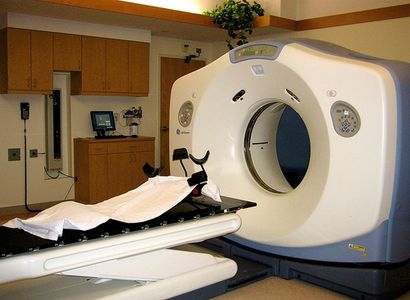
|
| CAT Scan |
In 1950 I got it again, but this time I was a doctor and knew there was a good treatment. It sounds strange to say so, but I was sort of happy to be able to try out the new medicine, which was then called Aureomycin because the powder was golden yellow. Aureomycin was a trading name, with a patent, and when the patent expired the generic form was called Tetracycline. It worked just fine, and in three or four days I was out of the hospital, perhaps a little weak and shaken, but cured. Incidentally, I discovered an interesting feature of the disease which I believe has not been previously reported. It had long been observed that the chest x-ray showed pneumonia while the stethoscope perceived very little abnormality, a feature which disconcerted those of us who were concerned with the cost of medical care, particularly members of a generation who felt sniffy about the dependence younger physicians displayed for x-rays, and nowadays for CAT scans and MRIs. Unfortunately, in this particular instance, x-rays are clearly superior to stethoscopes.
My third time around for "viral" pneumonia was a few years later; I was sitting on a park bench near the hospital when I recognized the old symptoms were coming back again, so I went straight to the x-ray department and had a chest x-ray less than an hour after the symptoms appeared. I planned to have an x-ray to prove it, go get some tetracycline and be all better over the weekend, with a rollicking anecdote to tell doctor friends about. Unfortunately, the x-ray was normal, so I was admitted into the hospital to see what was wrong. The next morning the x-ray showed a densely consolidated lung, so it had been viral pneumonia all along. And so my old prejudices were vindicated; it was possible to be too quick to order x-rays after all. Unfortunately, the extra twelve hours without treatment allowed me to get a lot sicker than I had to be. I think I know this because, doggone it, I developed the same disease several decades later, took no shortcuts to the drug store, and was fine in a couple of days after I immediately started taking tetracycline. You could say this strange recurrence of Mycoplasma pneumonia over one-lifetime sort of illustrates how medical care of the disease has become progressively cheaper. Instead of a month in the hospital with no treatment, it was now a matter of skipping the stethoscope, skipping the x-ray, skipping the hospital, and just swallowing some cheap tetracycline capsules. You have to have the nerve to do it, of course, and ethically you probably only have a right to do it to yourself, knowing the risks and being willing to accept them. There is, however, one flaw in this story.
When Aureomycin first emerged from the clutches of the FDA (and well before that accursed Kefauver Amendment), it seemed astonishingly expensive. Because I knew what it weighed (250 milligrams per capsule), and I knew what gold cost ($35 an ounce), it was easy for an idle mind to calculate that Aureomycin cost more than gold. Gold now sells for $1700 per troy ounce, so you could take this story in the direction of inflation. I rather prefer to take it in the direction of nominal dollar amounts, because Aureomycin retailed for $5 a capsule the third time I had the disease, and $1 per capsule when it lost its patent and became tetracycline. The fourth time I had the disease, I bought a container of fifty capsules for 76 cents. But as you have already heard, by the fifth time I couldn't buy it for any price, because everybody had stopped making it. Since my view of the economics of useful commodities is that low prices will only cause shortages if there is artificial market interference, the usual cause of shortages is rationing. Somebody who understands the 2500 pages of Obamacare better than I do will have to tease out the way rationing has caused shortages of tetracycline. And when they are done confusing the public, let them explain why you also can't buy KMnO4 crystals (potassium permanganate), which has cured more cases of athlete's foot for twenty cents, than all those cans of stuff in spray canisters.
Mexican Immigration and NAFTA
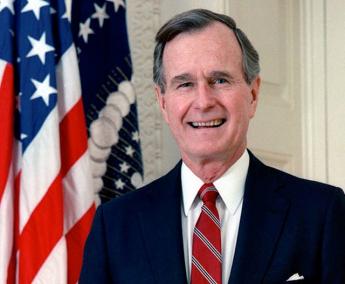
|
| George H.W. Bush |
The North American Free Trade Agreement (NAFTA) was signed on December 17, 1992, by President George H. W. Bush for the United States, Prime Minister Brian Mulroney for Canada, and President Carlos Salinas for Mexico. It was intended to eliminate tariffs from the North American continent, with long-run benefits for the three nations who made the agreement. Essentially, it was President Bush's idea, growing out of the long period of public service in which he prepared himself for the Presidency in most of the major components of the American government. After his election, he immediately started to implement the many ideas he had formulated, characteristically worked out in considerable detail, and assigned to government officials he had worked with and knew he could trust. The twin results were that he advanced sophisticated ideas much more quickly than is customary, but then experienced backlash from a public which was accustomed to understanding programs before they assented to them. NAFTA was a prime example of both the advantages and disadvantages of an expedited approach.
Tariffs are a tangled ancient political dispute between nations; George Bush got his two neighbors to sweep them away in a remarkably short time for diplomacy. However, plenty of people benefit from the pork barrel, the unfairness and the economic drag of tariffs, so Bush even got ahead of that opposition, essentially presenting it with a done deal. However, he failed to be re-elected because his fellow Texan Ross Perot campaigned as a third party candidate, thundering about a "giant sucking sound" which was predicted as American businesses would flood into Mexico. Whatever Bill Clinton may think, he won the election as a result of the third-party divisiveness of Ross Perot. And Clinton furthermore got to take credit for NAFTA largely because he claimed the credit. Poppy Bush followed Reagan's strategy of winning by letting others take the credit.
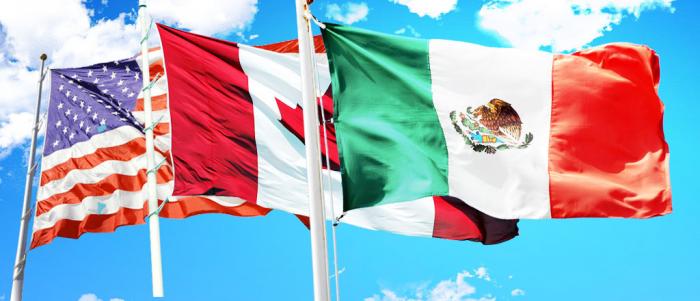
|
| NAFTA |
NAFTA had a lot of minor provisions, but the main feature was to help Mexico with manufactures, compensating for America hurting Mexican agriculture with cheaper United States agricultural imports. The usual suspects howled about the unfairness of such a dastardly deed, but they lost. Helping Mexican manufactures took the tangible form of the "maquiladoras", which were assembly plants from the United States re-located just south of the border, assembling parts made abroad into machinery and other final products, for sale in the United States. The general idea behind this was that Mexican immigration was mostly driven by a hunger for better jobs; give them jobs in Mexico, and they would stay home. That's a whole lot better than an endless border war. Even today, it would be hard to find anyone who would contend that fences, searchlights and police dogs were a superior way to control the borders.
For a while, the maquiladoras were a huge success. But then, China got into the act, paying wages so low that even Mexicans could not live on them. No doubt Ross Perot rejoices that the maquiladoras promptly collapsed, leaving abandoned hulks of factories just across the dried-up Rio Grande. And eventually, we even have tunnels bored under the border and more illegal Mexicans in America than we have people in prison who might take the same jobs. Not the least of the consequences came from the other parts of the same country. Mexico traded an injured agricultural economy for the promise of high-paid manufacturing jobs in maquiladoras. So, masses of impoverished Mexican farmers were made available for illegal immigration, up North.
It is now anybody's guess whether Chinese wages will rise enough, soon enough, to reverse the economics of their destruction of the Mexican economy. The election of a union-dominated Clinton/Obama presidency in the meantime does not bode well for actions which would reverse that result, which now would threaten American-Chinese relations of an entirely different sort. It is true that Chinese wages are relentlessly rising, and that transportation costs now favor assembly-factories closer to the American consumer. But maybe the moment for this approach is passing, or possibly has passed.
REFERENCES
| George H. W. Bush: The American Presidents Series: The 41st President, 1989-1993: Timothy Naftali, ISBN-10: 0805069666 | Amazon |
More, or Fewer, Raisins in the Pudding

|
| manuscripts |
Some book publishers do indeed regard history as handfuls of paper in a manuscript package, mostly requiring rearrangement in order to be called a book. Librarians are more likely to see historical literature dividing into three layers of fact mingled with varying degrees of interpretation: starting with primary sources, which are documents allegedly describing pure facts. Scholars come into the library to pore over such documents and comment on them, usually to write scholarly books with commentary, called secondary sources . Unfortunately, many publishers reject anything which cannot be copyrighted or is otherwise unlikely to sell very well, however important historians say it may be. Authors of history who make a living on it tend to focus on the general reading public, generating tertiary sources, sometimes textbooks, sometimes "popularized" history in rising levels of distinction. Sometimes these authors go back to original sources, but much of their product is based on secondary sources, which are now much more reliable because of the influence of a German professor named Leopold von Ranke. Taken together, you have what it is traditional to say are the three levels of historical writings.
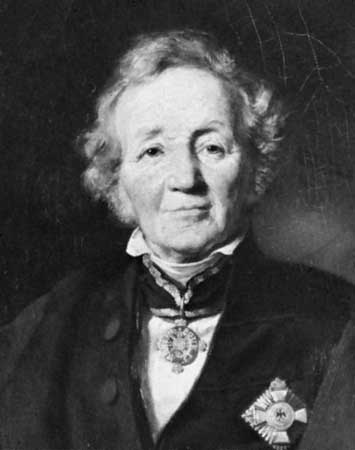
|
| Leopold von Ranke |
Leopold von Ranke formalized the system of documented (and footnoted) history about 1870, vastly improving the quality of history in circulation by insisting that nothing could be accepted as true unless based on primary documents. Von Ranke did in fact transform Nineteenth-century history from opinionated propaganda in which it had largely declined, into a renewed science. At its best, it aspired to return to Thucydides, with footnotes. That is, clear powerful writing, ultimately based on the observations of those who were actually present at the time. Unfortunately, Ranke also encased historians in a priesthood, worshipping piles of documents largely inaccessible to the public, often discouraging anyone without a PhD. from hazarding an opinion. The extra cost of printing twenty or thirty pages of bibliography per book is now a cost which modern publishing can ill afford, making modern scholarship a heavier task for the average graduate student because the depth of scholarship tends to be measured by the number of citations, but incidentally "turning off" the public about history. All that seems quite unnecessary since primary source links could be provided independently (and to everyone) on the Internet at negligible cost. And supplied not merely to the scholar, but to any interested reader, no need to labor through citations to get at documents in a locked archive.

|
| E-Books |
The general history reader remains content with tertiary overviews, and a few brilliant secondary ones because document fragility bars public access to primary papers, but many might enjoy reading primary sources if they were physically more available. The general reader also needs impartial lists of "suggested reading", instead of the "garlands of bids", as one wit describes the bibliographies employed by scholars. If you glance through the annual reports of the Right Angle Club, you will see I have increasingly included separate internet links to both secondary as well as primary sources, because the bibliographies within the secondaries lead back to the primaries. Unfortunately, you must fire up a computer to access these treasures. The day soon approaches when scholars can carry a portable computer with two screens, one displaying the historian's commentary while the second screen displays related source documents. It seems likely history on paper will persist while that remains cheaper, but also because e-books make it hard to jump around. Newspapers and magazines particularly encounter this obstacle, because publication deadlines give them less time for artful re-arrangement. E-books are sweeping the field in books of fiction because fiction is linear. Non-fiction wanders around, even though this subtlety is often unappreciated by computer designers.
Museum of the American Revolution
The Right Angle Club of Philadelphia was recently pleased to be visited by Michael C. Quinn, the President, and CEO of the forthcoming Museum of the American Revolution, which will be built at Third and Chestnut Streets, on the site of the former Visitors Center. Mr. Quinn comes to us from the Mt. Vernon and James Madison Museums in Virginia and expects to spend another three years getting the new Museum built and established. It's also expected to cost about $150 million, so look for something really special. The great majority of the required money is expected to come from Philadelphia and surrounding territory, led by a challenge grant from Gerry Lendfest of $40 million.
The collection of Valley Forge and related Revolutionary artifacts was begun by Herbert Burk, an Episcopal rector in Norristown, Pennsylvania, and the son of another Episcopal rector of Clarksboro, New Jersey, and who graduated from the University of Pennsylvania toward the end of the Nineteenth century. The Valley Forge area was pretty well deserted at that time, and the local bishop expressed doubt that it could support both an Episcopal and a Baptist church, particularly since an earlier rector named Guthrie had attempted it and finally disappeared. Reverend Burk, however, was fired with the vision of Washington kneeling in the snow, and highly scornful of doubters who insisted on seeing his footprints in the snow before they would accept it. These were the days just after the German historian Leopold von Ranke had started a movement of great enthusiasm among historians for documents to prove almost anything calling itself history, so there was more than the usual amount of harumphing among academics about authenticity, which Burk dismissed with scorn. Since his second wife was a Stroud, there may have been social issues as well. About all, we really know of George Washington's religious beliefs was that he regularly went to Christ Church and sat in Martha Washington's pew; but he resolutely refused to take Communion. It sounds to some of us as though he was more of a politician than a theologian. But the Museum now has picked up successor enthusiasts, determined to make the Museum a success; so let's let that religion matter drop.

|
| Museum of the American Revolution |
The old visitors center was given a bell by Queen Elizabeth II, who brought it over on the royal yacht and gave a memorable speech at its installation. The deed to the property does not include the bell, and its future is presently uncertain. However, the building will be torn down and replaced by a much larger structure, intended to house many rooms and a tour lasting hours, to show off Washington's military tent and similar artifacts of the low point of the Revolution, when it rested with the personal character of a few founding fathers, to preserve the drive and idealism of the freezing, starving troops. It's a tall challenge for Mike Quinn to carry it off with the right mixture of showmanship and concern for accuracy. After all, no good story is improved by exaggeration.
Peggy Shippen and Benedict Arnold: Fallen Idols

|
| General Burgoyne |
After defeating Washington's troops at the battle of Germantown, the British then occupied Philadelphia for the better part of a year. The town was a mess, with food shortages typical of the squalor of any occupying army equalling the existing population. Washington was forced to fall back to the natural fortress of Valley Forge. The city of Philadelphia was not exactly under siege, but it was as difficult a place for British troops to live as a besieged city. For his part, Washington was forced to shiver and starve in the nearby mountain valley, at least consoled by distant news of American achievements. General Burgoyne and his army were soon captured at Saratoga by General Gates under humiliating circumstances. Clearly, the dashing hero of this event had been Benedict Arnold on a white horse leading the charge, getting wounded in the leg in the process.
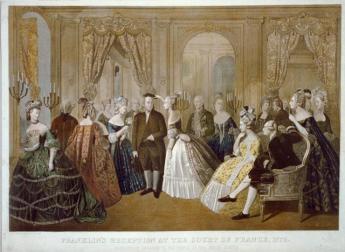
|
| Benjamin Franklin in Paris |
Benjamin Franklin in Paris trumpeted the news of this victory, reminding the French of Washington's earlier victory at Trenton, and maneuvering it all into a treaty of alliance. With the French fleet in the nearby Caribbean, Philadelphia was no longer a safe place for the British to stay a hundred miles upriver, and the idea of abandoning occupied Philadelphia began to grow. Having gambled on British victory in defiance of London's orders, the Howe brothers were not in a position to argue with new orders. The British soldiers inside the city were more comfortably housed than the American troops outside it, but nobody was exactly comfortable. The American Congress had, of course, fled to the hinterlands. All in all, it suddenly became uncertain who was going to win this war.
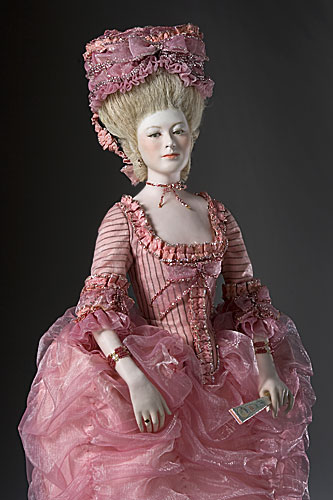
|
| Peggy Shippen |
The American population at this time has been described as a one-third rebel, one-third Tory, and one-third trying to hunker down to see who would win. Many of the seriously committed Tories had fled from Philadelphia when the rebels took charge, while pacifist Quakers were a little hard to classify. Generally speaking, the prosperous merchant class had never been persuaded King George was all that bad, while the less prosperous artisans were the fervent patriots. Under such conditions, many people who privately leaned in either direction found it was best to seem non-committal. The British were billeted in private homes; the Officers in the best houses of the merchant class, the common soldiers generally housed in the homes of the artisans. Although the soldiers and the artisans did not mix very well, circumstances permitted the aristocratic officers getting on pretty well with the merchants whose houses they occupied. The girls in the colonial families seemed immediately attractive to the British officers, who were far from home, while the officers also seemed pretty glamorous to the girls. So, it is not exactly surprising that the most beautiful colonial belles like Peggy Shippen and Peggy Chew found themselves frequently in company with dashing officers like Major John Andre. Andre would likely have been a heartthrob in any circumstance since he had risen to the rank of adjutant-general at a young age, wrote poetry and plays, reputedly was rich, and was regularly the life of any party. Nor is it surprising that generations of Peggy's descendants have treasured a lock of his hair.
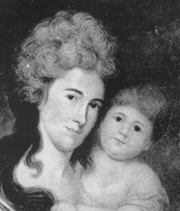
|
| Margaret Oswald Chew Howard |
When the decision was finally made to abandon Philadelphia, six of the British officers personally contributed twenty-five thousand dollars to throwing Philadelphia's most famous, most splendiferous party, called The Machianza. It went on for days, had real jousting matches between officers dressed like knights in armor, banquets and all that sort of thing. It was Andre's idea, and he was enthusiastically in charge. Surviving records of the event do not show that Peggy Shippen was present, but in view of what happened later, much of her correspondence has been destroyed. It's pretty hard to imagine she wasn't there.

|
| Major General Benedict Arnold |
The British then marched away, and Washington's troops cautiously followed, assuming control of the city. Major General Benedict Arnold had been sent from Saratoga to Valley Forge to recover from his leg wound, and probably also to raise morale among the troops celebrating the now-famous hero. Washington more or less immediately decided to pursue the British across New Jersey, thus leading to the battle of Monmouth as the two armies raced for the Naval vessels in lower New York harbor. Since General Arnold had not fully recovered from his wounds, he was installed as the military governor of a somewhat bedraggled Philadelphia. Naturally, he was the center of the social scene, and soon was pursuing Peggy Shippen in every way he knew, which included some pretty gloppy letters in Romantic style. Peggy's father was uneasy about his intentions but was eventually mollified by Arnold's purchase of the house called Mount Pleasant, now a tourist attraction in Fairmount Park. With this evidence that his prospective son in law was at least likely to stay in Philadelphia, Edward Shippen finally repented of his opposition to the marriage of his daughter. But the new couple were soon off to West Point, where Arnold had kept up a persuasion campaign with George Washington, to get himself appointed the commandant of the main northern defense of the Hudson River. A point for Philadelphian tour guides to remember is that Peggy and Benedict never got a chance to live in Mount Pleasant.
Arnold originally lived in New Haven, Connecticut, where he had established quite a sea-faring reputation as a merchant, some would say privateer, others would say buccaneer. There is no doubt he was aggressive, and combative, and considered himself a little bit above the law. These qualities made him outstanding at Fort Ticonderoga and Saratoga, and are always more highly valued in young men in a war. Unfortunately, he made a bitter enemy of Joseph Read who was briefly his neighbor, and later was President of the Continental Congress. Read accused Arnold of smuggling and trading with the enemy, and was so determined about it that Arnold was scheduled for court-martial, but postponed. Arnold was loudly defensive about the whole matter, and public sympathy was on his side. In view of what soon happened, he might well have been cleared by the court, but likely there was some truth to the accusations. Using Peggy as a go-between, he entered into a correspondence with Andre (then the adjutant-general in New York) offering to deliver the surrender of West Point, three thousand prisoners, and possibly George Washington himself in return for what might today be half a million dollars. As a note of realism, he was willing to accept half that in the event of failure. The British were particularly anxious to acquire American prisoners to exchange for their own troops captured at Saratoga. Unless Arnold was a total sociopath, he must have thought he had quite a grievance.
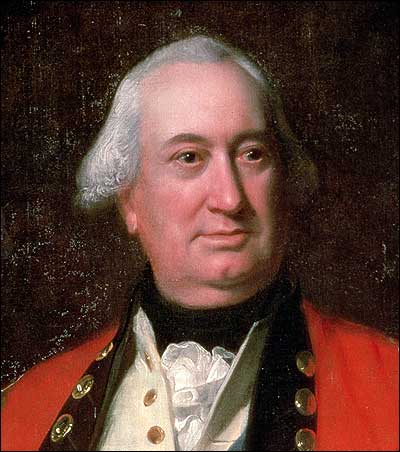
|
| Lord Cornwallis |
Things went along surprisingly well at first, with negotiations for price back and forth, plans for attacking West Point moving along with the Navy, and Andre disguising himself for a visit to Arnold in his house to the south of the Fort on West Point. Much of the success was due to the movie-star reputation of Benedict Arnold; few could imagine such a hero doing such an unheard-of thing. However, the plot was discovered while Washington was away visiting the Fort, and Arnold hastily abandoned his family and fled to a waiting British warship. Andre decided to make his way south to the ship through rebel territory, but local soldiers and farmers were much more suspicious than others had been, and after penetrating his disguise, found incriminating papers concealed in his boots. Since he was out of uniform behind enemy lines, Andre was by definition a spy, which required hanging. He made a plea to be shot like a gentleman, but Washington with tears allegedly in his eyes refused. With much bravado, Andre jumped atop his own casket and placed the noose around his own neck, a behavior much admired by his compatriots when they heard of it
Meanwhile, Peggy had put on a crazy-woman act which apparently convinced Washington to be lenient, and allow her to rejoin her husband. The couple stayed in New York for a few months, toying with commands of loyalist troops in the south, but eventually taking ship for England. Lord Cornwallis was on the same ship and they became pals as shipmates, pleasing Arnold quite a lot. Unfortunately, British society was only stiffly polite to them, and many did not trouble to conceal their disdain for traitors to any cause, and thus life in England was not smooth. By that time, it is possible that many had begun to suspect the whole idea of treason was Peggy's idea from the start, as is today the conventional view of it. As an American aristocrat, she was uncomfortable with the rebels in Philadelphia, and as the impetuous wife of an accused smuggler, it was difficult to fit in with either the Quakers or the merchants with loyalist leanings. No doubt she heard some catty whisperings among her friends and relatives about her other romantic associations. The British paid them their promised pensions, but a career in the British Army was out of the question for her husband. But the real shock would come, from discovering the British as a whole didn't much care for their behavior, either.
Implicit Powers of the Federal Government
<The two highest achievements of James Madison, had been and still remain, the writing of the Bill of Rights, and acting as a close collaborator with George Washington in fleshing out the role of the President in the new government. The Ninth and Tenth Amendments made it clear that the federal government was to be constrained to a limited and enumerated set of powers, while all other activities belonged to the states. This was already clear enough in the main text of the Constitution, which Madison also dominated after close consultation with Washington before the Constitutional Convention. So he had battled and successfully negotiated one matter twice, before the most powerful and distinguished assemblies in the nation. As to the second matter, circumstances had promoted a shy young bookworm into the role of preceptor to the most famous man in America. In the earliest days of the new republic, certainly during the first year of it, Washington and Madison worked closely together in defining the role of the Presidency.
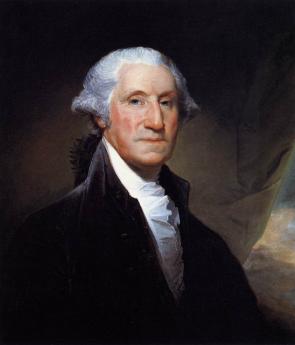
|
| George Washington |
During the first weeks of that exploratory period, Washington induced Congress to create a cabinet and the first four cabinet positions, even though the Constitution did not mention cabinets. It all was explained as an "implicit power", inherently necessary for the functioning of the Executive branch. Soon afterward, Alexander Hamilton as Secretary of the Treasury proposed the creation of a national bank. Madison and his lifelong friend Thomas Jefferson were bitterly opposed, using the argument that creating banks was not one of the enumerated powers granted by the Constitution. Hamilton's reply was that creating a bank was an "implicit power" since it was necessary for running the federal government. Of course, Hamilton and Jefferson both had other unspoken motives for their position: for and against promoting urban vs. rural power, for and against the industrialization of the national economy, and dominating the states in matters of currency and financial leadership. It empowered a national rather than a confederated economy.
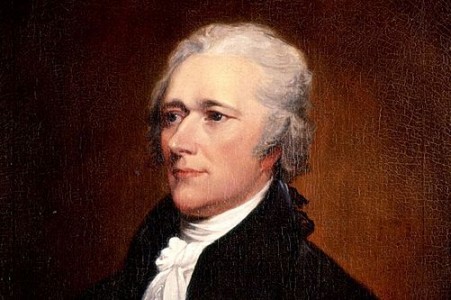
|
| Alexander Hamilton |
For Madison, the legalism probably carried considerably more weight than it did for Jefferson and Hamilton because it demonstrated the enduring consequences of being vague about the boundaries of any constitutional restriction. If this loophole got firmly established, it might reduce the whole federal system to a laughingstock. In order to promote the "general welfare", anything at all could be called an implicit power, and both separation of powers and enumerating federal powers would soon become quaint flourishes. The whole Constitution might fall apart in endless debates. On a personal level, Madison's highest achievements would have to be supplanted by something more practical. Besides which, Madison was a Virginian, a rich slave-holding farmer, and a young politician, seemingly on the verge of a promising career which might easily lead to the presidency for himself. Hamilton his most visible opponent, was already proposing a tax on whiskey which would almost surely antagonize farmers to the west, and assuming the Revolutionary debts of the states was equally divisive.
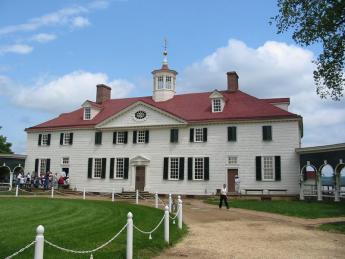
|
| Mt. Vernon |
As matters eventually worked out, the main disputants made ostensible constitutional arguments, while the real political dispute would be settled by a political deal struck at a dinner. It traded relocation of the national capital to Virginia, for the assumption of the debts of all states (when Virginia had already paid off its debt.) Location of the capitol opposite George Washington's home at Mt. Vernon also took care of difficulties coming from that direction. By the time the uproar about this arrangement subsided, the precedent for settling the inherent conflict between enforcing Constitutional limitations versus enlarging their boundaries had been set. The most opportune time for stricter interpretation was fading while the most likely advocates of it were restrained by their own example. The negotiation was a little unseemly, and probably encouraged similar decisions to migrate to a less conflicted body, which eventually John Marshall would define as the U.S. Supreme Court.
National Debt, Presidential Hat Tricks, Shale Gas and Argentina
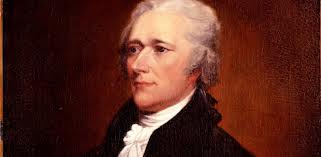
|
| Alexander Hamilton |
This-here speaker at the Right Angle Club began a discussion of the "Fiscal Cliff" razzle-dazzle of 2012, by changing his mind about the causes of the financial crash of 2007. Originally, it seemed as though globalizing 500 million Chinese out of poverty had destabilized the exuberant American mortgage market by flooding it with cheap credit. Supplanting that idea, or perhaps only supplementing it, must now be added the overextension of national debt itself to a point of bringing national borrowing to a halt.
Early in the Eighteenth century the Dutch and English had monetized national assets through a system of national borrowing formalized by Necker in Europe, and Robert Morris and Alexander Hamilton in America. Aside from a handful, no one could understand what they were talking about. Try reading that sentence a second time.
It amounted to guaranteeing all the private credit in the banking, investment, and commerce systems, with a national debt (in the form of Treasury bonds) which monetized all the assets of the whole nation. That action more or less doubled their value, just as any bank loan is seemingly owned by two people at the same time. Carried to an extreme, it might imply that America could turn Guam and Hawaii over to China if we defaulted on our debt. That was never actually intended to happen, and it never has, because all nations now fear the deflation which could result from triggering a massive exchange of national assets. The nebulous issue of "National Sovereignty" interferes with territorial transfers by any means other than war. If one nation defaults against a second nation which is afraid to go to war, it is just the stronger nation's hard luck about the debts it has chosen to support unless a transfer of assets actually happens. The Treaty of Versailles did transfer assets to the victors, and set off World War II, although it is considered bad manners to mention it. That's a simplified view of our international financial system, which admittedly skirts uncertainty about how much national debt is too much.
In fact, no one knows how much is too much until everyone runs for the exits. Now that politicians have control of computers and "big data", a modern description places the blame on Alan Greenspan the former Chairman of the Federal Reserve. For eighteen years Greenspan produced delicious world prosperity by steadily increasing American national debt faster than the American economy was growing. Sooner or later this approach was going to uncover how much was currently too much Federal debt. With silver and gold removed from the equation, one could see that default would certainly loom whenever the size of the debt became so large it could never be serviced by the Gross Domestic Product (GDP), and possibly sooner than that, if enough people could guess what was coming. This reality might be obscured temporarily by reducing interest rates, modifying international trade balances, and inflation. When the stars were in alignment however, the system just had to collapse and start over. Because it happened gradually, perhaps it would unwind gradually. In 2007 what happened was that everybody tried to get out the door at the same time. Essentially, our two political parties made opposite assessments: the party of Hamilton -- Republicans -- announced this system was doomed, while Democrats --the party of Andrew Jackson -- announced they could stave off disaster by making the rich Republicans pay for it. Both parties were partly right but essentially wrong, and the Democrats hired a better magician.
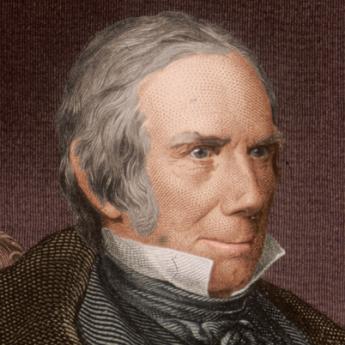
|
| Henry Clay |
It will take months or even years to be certain just what strategy was pursued. It would appear the Democrats chose to repeat the performance of the Obamacare legislation, eliminating national debate by eliminating the Congressional committee system of examining details in advance of a vote. Given one day to digest two thousand pages prepared by the Executive branch, no time was allowed for public opinion to form about Obamacare. In the case of the fiscal cliff episode, Congress was given less than one day to consider 150 pages allegedly prepared the day prior to the vote. Some will admire the skill of the executive branch in orchestrating this secret maneuver, but eventually, it must become apparent that policy decisions have been transferred from the legislative to the executive branch of government. Perhaps the Congressional Republicans are as stupid as the Democrats portray them to be, but it is also possible that a decision has been made to tempt the Democratic leaders into repeating this performance several times until eventually, the public is ready to consider impeachment for it. No matter what the strategy, we are now threatened with imagining some moment when gun barrels come level and live rounds slide home. We may pass up the opportunity to criticize Henry Clay for concentrating undue power in the Speaker of the House, or to uncover the way Harry Reid was persuaded to surrender Senate power to the Executive; both miscalculations are fast becoming irrelevant in the flurry of events. We came close to borrowing too much, exceeding our means to pay it back, that's all. A New York Times editorial economist feels we can "grow" our way out of this flirtation with danger, and we all certainly hope so.
Seemingly, there are only two ways to cope with over-borrowing, once we step over the invisible line. A nation may cheat its citizens with inflation, or it may cheat foreign citizens by defaulting on their currency. We are indebted to Rogoff and Reinhart for pointing out there is no difference between inflation and default except the identity of the cheated creditor; so most politicians prefer to cheat foreigners. Either way, cheating makes deadly enemies. Two centuries ago, Alexander Hamilton suggested a third way out of the problem, which we would today call "growth". But here, cheating is pretty easy: If the limit is some ratio of debt to GDP, find a way to increase nominal GDP.
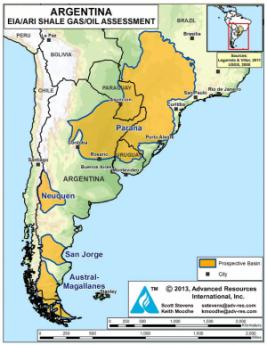
|
| Shale Gas and Argentina |
The most astonishing current example of the power of "growth", is shale gas. It may not be totally clean, but it is cleaner than oil or coal, and far cheaper. We suddenly have so much of it the price of energy is artificially lowered, and we talk, not merely of energy independence, but of restoring the balance of international payments by exporting it. Germany is constructing steel mills to utilize iron ingots made in America with gas instead of coal. Pittsburgh was once the center of steel production because that's where the coal was, the most expensive ingredient to transport. Suddenly it is now apparently cheaper to transport the energy source to wherever you find limestone and iron ore. JP Morgan got rich the other way, transporting limestone and iron ore to Pittsburgh, where the coal was. Russia now finds it has lost its leverage over Eastern Europe's energy supply, and the Arabs (?Iranians?) will no longer have a monopoly to provide the wealth supporting Middle-Eastern mischief. China may lose interest in Africa. And in America we may develop the courage to rid ourselves of the corn subsidies for gasoline; cutting the wind and sunlight fumbles also emerge as obvious ways to cut the deficit. That's what we mean by growth. It's so powerful it makes action by any American President seem trivial by comparison.
Presumably, President Obama does not welcome being upstaged by an economic force he doggedly resisted. He may seek ways to imply it was his idea all along. When that happens, rest assured that everyone else is then a fracker. But there is another alternative Presidential path, which in extreme form is emerging in Argentina without much media attention. In short, Argentina discovered signs of oil deposits but was unable to exploit them. A European oil company was enticed to develop the oil reserves at its own expense, and effectively did so in expectation of reward from the resulting oil sales. Suddenly, the Kirchner government expropriated the oil company, paying for it with Argentine bonds. The ink was scarcely dry before the Argentine government abruptly turned around and offered to buy back the bonds for 24 cents on the dollar. And unless someone is willing to send gunboats, the previous owners of the oil company are just out of luck. Appeals to the UN are futile; because on the one-nation, one-vote principle, there are more expropriator votes in the UN than potential victims. The only thing visible which could save capitalism in South America from the revolution in shale gas competition. Presumably, Argentina has lots of shale gas, but who will lend them the money to frack it?
Sources of Revolutionary Populism
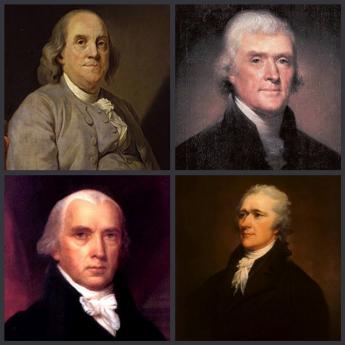
|
| Founding Fathers |
Those who now look back at the Founding Fathers often fail to account for the aging process during the eleven years between the Declaration of Independence in 1776 to the Constitutional Convention of 1787. The two events took place in the same building, Independence Hall, and many participants of the Convention were fellow Revolutionary War veterans. But there was originally a great social difference between a colonial leader and a teen-aged soldier at the beginning of this period, which tended to seem blurred by the experiences of the war. Someone who fought and was wounded as a common soldier might later grow into the dignity of a former war hero, but underneath this veneer was a very different experience from an early leader of the colonial rebellion, or after the onset of serious hostilities, an older man who seemed eligible to be a Revolutionary officer. The original generation of rebels conspired to restore proper British rights for individual colonies, while the teenager who fought in the Continental Army under his idol George Washington saw himself as fighting for the freedoms of individuals, living in a new nation.
What emerged were two generations of Founding Fathers, one of which was generally an officer fighting for the right of his state to be fairly represented, the other a young common soldier, fighting for the individual right of free speech. One wanted to protect his colonial region's religion, the other wanted the freedom to choose his own religion. Both of them felt entitled to say how things were to be run, but young men eventually become older men. No better example of aging's transformation of attitudes could be found than the life of John Marshall. This teenaged wounded veteran of the Battle of Trenton evolved into Chief Justice of the Supreme Court, the author of a multi-volume biography of George Washington, and almost the last man standing who could be called a Federalist. Other teenaged soldiers took different paths in life.
History belongs to the victor, so it is also important to recollect that almost a third of the colonists had been Tories. In general, the upper crust of society tended to be more loyalist. Thousands of Loyalists fled to Canada, and thousands more fought on the British side. When General Clinton abandoned the occupation of Philadelphia, three thousand Loyalists accompanied him. The loss of these more educated and wealthier citizens and the lowered public profiles of those who remained in America skimmed off a considerable portion of the natural leadership of the colonies. Those young men who were left behind were victors, often exhilarated to discover that if they did not lead, no one would lead.
The embodiment of these population shifts was to be found in state governments with unicameral legislatures, popular election of judges, and weak executives -- all of which have since been repudiated by experience, but all of which reflect a distrust of leaders. Partly this might be attributed to lack of experience, greater reliance on collective government by the herd instinct, the recklessness of youth, and fear that power will eventually return to the hands of those who are educated to handle it. The hostility of the lower classes to those who are better off has many causes, but in this situation, it was promoted by unexpected elevation to leadership, combined with a subsequent determination not to lose power again -- balanced against the rather strong possibility that they would. Add to this the continued influx of immigrants fleeing from foreign oppression, and it is not surprising that the result is an enduring strain of populism stirring up a latent tendency to class warfare. You, too, can be President; but you must fight if you expect to succeed. The former aristocratic attitude was that you are born to rule, as long as you don't do something stupid.
REFERENCES
| The Great Courses: History of the United States, 2nd Edition Course #8500: Lecture 14 Creating the Constitution: Aurthor: Allen C. Guelzo: ISBN: 156585763-1 | The Great Courses |
Stretching Out Your Retirement Savings
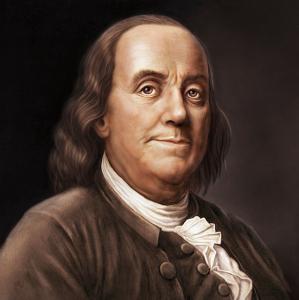
|
| Benjamin Franklin |
Benjamin Franklin was able to retire from the printing business at the age of 42. His partners bought him out in eighteen yearly installments. In the Eighteenth century, it was unusual to live past the age of 60, so Ben felt pretty well fixed. Unfortunately for this planning, he lived to be 82, so when he did reach the age of 60 he was forced to look around for postmasterships and other ways to survive, for what proved to be 22 more years.
This is the other side of a coin; on one side is written, "Protect your family in case you die young". On the opposite side is written, "Be careful not to outlive your savings", relying on the old Quaker maxim that the best way to have enough--is to have a little too much. For centuries, life insurance was sold to people who mainly feared the first, commonest, possibility, but never completely addressed the opposite contingency, which was growing steadily commoner. Annuity insurance ordinarily is sold for a fixed number of years, so insurance commissioners ordinarily require what is most probable. Unfortunately, this response shifts the risk of guessing wrong onto the subscribers' shoulders. Since science has unexpectedly lengthened average life expectancy (by thirty years since 1900, or by five years in the last ten), experience rather like Ben Franklin's has become a commonplace, but rather poor business judgment. The business remains solvent only as long as the decision to drop the policy is later than the life expectancy.
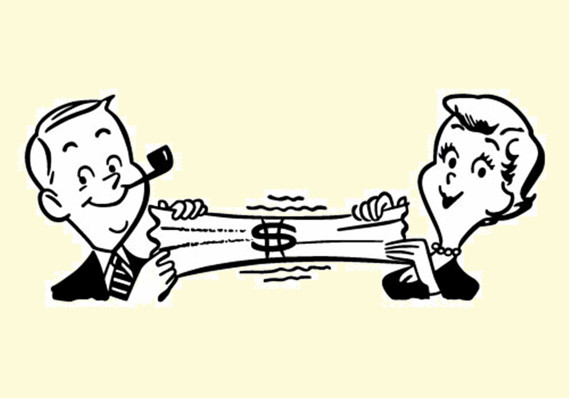
|
| Retirement Saving Debt |
There may exist insurance policies to address this issue, but few companies offer it. We will briefly describe this sort of policy, in case it becomes more widely available, but it is primarily described here to illustrate the issues to consider. If you can get it for a reasonable price, or if you can get it at all, the outline of the policy would be to set a premium and promise to pay 6% for the rest of your life. Underneath the promise is the reality of paying 6% for eighteen years as a non-taxable return of principal. Following that, you don't need to get a postmastership, you are paid a taxable 6% until you die. Presumably, the insurance company has actuaries to help with the math, so the company makes money if you live less than your life expectancy, and loses money if you live longer. If life expectancy suddenly extends much longer (let's imagine a cure for cancer appears), the insurance company is going to go broke. That's why insurance commissioners are uncomfortable with the concept, even though it is obvious how desirable it might be. So that's why annuity insurance typically states a fixed number of guaranteed years and expects the subscriber to shoulder outlier risk.
Any insurance has an administrative cost, so everyone must consider some non-insurance solution to the whole problem. Therefore, we propose you re-examine the old saw about "never dip into principal". If you don't have enough money, you can't do very much except depending on the government, your family, or your fairy godmother to help you out, although it must be obvious that all Americans would be wise to consider retiring five or ten years later than they hoped. Very likely, the government is going to have a difficult time sustaining even the present tax exemption of retirement funds, medical insurance, and social security. Those are called entitlements, but if the government eventually can't afford them, it won't matter what you call them. If entitlements keep getting extended, we can expect our nation to resemble the ancient Chinese and Indian nations -- able to build palaces in their golden era, but eventually crumbling into a gigantic slum in centuries afterward. So please, if you are able to do it, try to keep gainfully employed for a few extra years. If you do it (and some people can't) you may be able to realize the American Dream.

|
| Inheritance Tax |
The traditional American dream was to accumulate enough money to live off the income from it indefinitely, never touching principal, and then exposing the principal to destructive estate taxes after you finally die. Unless you are unusually wealthy, there isn't much left for the next generation after estate and inheritance taxes and expenses. It's a little inefficient to accumulate more than you actually need, but the government gravitates toward the least painful methods of collecting taxes. By confiscating this safety surplus, however, it declares that "Every ship (generation) must sail on its own bottom." And therefore it must acknowledge responsibility for what inheritances ordinarily pay for, like charity and good works. But there remains a quirk to this.
If Ben Franklin's partners had arranged to invest the money until he needed it, they could at least have afforded to finance two or three extra years. After inflation and expenses have eaten away at your retirement income, your principal may not generate enough income to last forever, but it is still big enough to pay for several years of retirement, which may in fact be longer than you are destined to live. Remember two things: 1) a principal sum, big enough to support you indefinitely, must be roughly eighteen times your yearly expenses. If it is only big enough to support you for fifteen years, it will seem too small until you realize you are probably actually going to live, say, five years. And 2) as far as leaving an inheritance to your children is concerned, there is a realistic probability that the government will consume most of the estate before it ever gets to the kids. These fundamental truths are presently obscured by the Federal Reserve artificially forcing interest rates to less than 1%. But if you can just hold out for a few years, it seems entirely likely that interest rates will return to 6% (meaning your principal will once again produce eighteen equal installments). But such a return of interest rates to normal levels will force the government to pay a comparable amount as interest on its bond debts (meaning it will get hungrier to escalate your estate taxes.) This isn't nearly as satisfactory a solution to the life expectancy quandary as retiring five years later than you once expected to, but you can't say we didn't warn you.
And as for what happened to Ben Franklin, you can read his will. He died a very rich man as a result of shrewd investments, later in his life. Ben left eight or nine houses, several thousand acres in several states, a gold-handled cane, and a portrait of the King of France surrounded by hundreds of diamonds. But it would not seem wise for the rest of us to count on accumulating that much new wealth, after attaining the age of sixty. The way things are going, once you attain your life expectancy, everyone should have some non-insurance plan for supporting himself for two or three extra years.
Why Jefferson Hated Banks and Hamilton Loved Them

|
| First Bank of Philadelphia |
Some things are easier to understand when they start before they get complicated. That's true of banking, where it can now be puzzling to hear there was a strong inclination to forbid banks by law. While we were still a colony, the British discouraged bank formation, fearing strong concentrations of wealth at a great distance could lead to ideas of independence. Anti-bank sentiment was thus a Tory characteristic, although as the Industrial Revolution progressed, Karl Marx and Fredrick Engels stamped it permanently with a proletarian flavor. Large owners of farmland were displeased to see their power weakened by urban concentrations of wealth, while poor recent settlers of America wanted to buy and sell land cheaply, so they favored a currency that steadily declined in value. People with wealth have an incentive to keep money stable, but people with debts have an incentive to pay them off with cheap money. After these battle lines clarified and hardened, the debate has transformed from an original dispute about banks, into catfights about a strong currency. As Rogoff and Reinhart have pointed out, inflation is a way for governments to cheat their citizens, devaluation is a way of cheating foreigners. Naturally, politicians prefer to cheat foreigners, but national tradition curiously seems to favor one style more than another. Essentially, they are the same thing with the same motive, although outcomes may be different. One is restrained by fear of revolution, the other by fear of an international currency war.
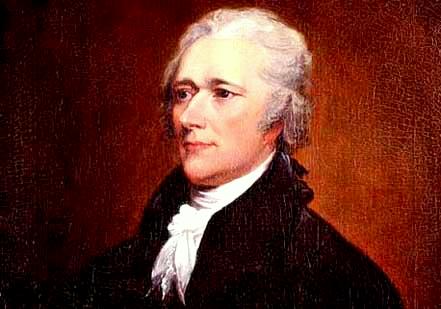
|
| Alexander Hamilton |
While George Washington was America's first president, Alexander Hamilton was Secretary of the Treasury and Thomas Jefferson was Vice President; the cabinet contained only four members. Although Hamilton was born poor, the bastard brat of a Scottish peddler in the view of John Adams, he had learned about practical finance in a counting-house, and later gained Washington's confidence on the headquarters staff; Washington eventually made him a general. Jefferson was part of the slaveholding Virginia planter elite, elegant in writing style and knowledge of art and architecture, sympathetic to the French Revolution; eventually, he died bankrupt. Early in the Washington presidency, Hamilton produced three long and sophisticated white papers, advocating banks and manufacture. Jefferson was opposed to both, one facilitating the other, which we would today describe as taking a green, or leftish position. Banks were described as instruments for accepting deposits in hard currency, or specie, and lending it out as paper money. The effect of this was a degrading of gold into paper money, or if not, an inflationary doubling of currency. Banks would be able to create money at will, a capriciousness Jefferson felt should be confined to the sovereign government. Just keep this up, and one day some former banker from Goldman Sachs would be able to tell the President of the United States, "The bond market won't let you do that." In this sense, the bank argument became a dispute about public and private power.
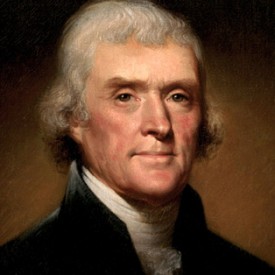
|
| Thomas Jefferson |
Hamilton, a former clerk of a maritime counting house, could observe that sending paper money on a leaky wooden boat kept the real gold in the counting-house even after the boat was lost at sea. To him, prudent banking transactions enhanced the safety of wealth, reducing risk rather than enlarging it. Later on, he learned from Robert Morris that a bank floating currency values on the private market disciplined the seemingly inevitable tendency of governments to water the currency. Once more, banks should enhance overall safety in spite of being vilified for creating risk. To both Hamilton and Jefferson, all arguments in an opposing direction seemed specious, designed to conceal ulterior motives.
Banks came and went for a century. By the time they almost were a feature of every street corner, banks were taking paper money (instead of gold and silver) as deposits and issuing loans as paper money, too; the gold was kept somewhere else, ultimately in Fort Knox, Kentucky. With experience, deposits could stay with the bank long enough that only a rare run on the bank would require more than 20% of the loans to be supported by physical ownership of gold. By establishing pooling and insurance of various sorts, banks persuaded authorities it was safe enough for them to hold no more than 20% of their loan portfolio in reserves. By this magic, loans at 6% to the customer could now return 30% to the bank. A few loans will default, a reserve for defaults was prudent, so the bank with a 2% default rate could settle for a 20% return rate. A bank which was deemed "too big to permit it to default" was invisibly and costlessly able to trim its reserves, and thus receive a 25% return by relying on the government to bail it out of an occasional bank crisis. With this sort of simple arithmetic, it is easy to see why multi-billion dollar banks were soon arguing that 5:1 leveraging was too small, a reserve of gold and silver was unnecessary, and the efficiencies of large banks were needed to compete with big foreign banks. By the time of the 2007 crash, many banks were leveraged fifty-to-one, which even the man on the street could see was over-reaching. The ideal ratio was uncertain, but 50:1 was certain to collapse, probably starting with the weakest link in the chain.
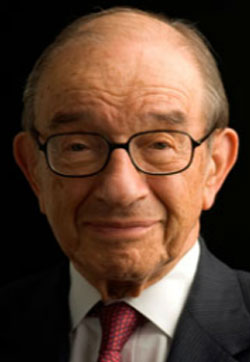
|
| Alan Greenspan |
This brings banking arguments more or less up to date. Except in 1913, an "independent" Federal Reserve Bank was created. It was a private reserve pool balanced by a public partner, the government. In time, the need for gold and silver was eliminated entirely, by the wartime Breton Woods Agreement, and the Nixon termination of it. The predictable inflation which could be expected to result from a world currency without physical backing was prevented by allowing the Federal Reserve to issue, or fail to issue as necessary, the currency in circulation. This substitution was deemed possible by having the Fed monitor inflation, and adjust the flow of currency to maintain a 2% inflation rate. Although 100% paper money was an historic change, it has endured; it has withstood efforts by the politicians to re-define inflation, undermine the indices of its measurement, and brow-beat the vestal virgins appointed to defend the value of the dollar. The old definition of money has changed: it is no longer a store of value, it is only a medium of exchange. The store of value is a nation's total assets. Jubilant politicians have added an additional burden of preventing unemployment, to the original one of defending price stability. In practical terms, the goal is defined as maintaining a 2% inflation rate, while achieving a 6.5% unemployment rate. It remains to be seen whether the two goals can exist at the same time, particularly if the definitions of inflation and unemployment become unrecognizably undermined.
And it even remains to be seen whether the black-box system can be undermined from within. The Federal Reserve is so poorly understood by the public that his enemies now accuse Alan Greenspan of causing the present recession. It is argued that the eighteen years of banking quiet which his chairmanship enjoyed, was only gradual inflation, deeply concealed. It is contended that the unprecedented steady rise of the stock market during those eighteen years was financed by a small but steady loosening of credit by the Federal Reserve. Perhaps what this means is: the definition of inflation must be tightened so its target can be made and adjusted, not to 2%, but to some number slightly less than that, measured to three decimal places. Or that the 6.5% unemployment target must be jettisoned in order to preserve the dollar. With that prospect including international currency wars as its corollary, it will be an interesting debate, and immigration policy is related to it. Because one alternative could become the abandonment of the fight against inflation, in order to sustain the new objective of reducing unemployment, Jefferson would have won the argument.
REFERENCES
| The History of the United States: Course 8500, 15 Hamilton's Republic: ISBN: 156585763-1 | The Great Courses |
| This Time Is Different: Eight Centuries of Financial Folly: Kenneth Rogoff, Carmen M. Reinhart: ISBN-13: 978-0691152646 | Amazon |
Bretton Woods
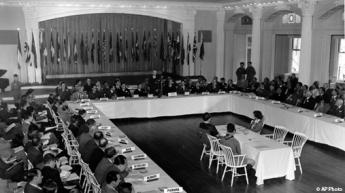
|
| The Bretton Woods conference in 1944 |
Stripped of its mystery and irrelevant details, the Bretton Woods conference agreed that all nations would make their currency convertible into U.S. dollars, and the U.S. would make its currency convertible into gold. Since World War II had left the United States with the only major working economy, it sold goods to the rest of the world and the rest of the world sent us their money to be converted into dollars; we had a "favorable balance of trade." Somewhere in the 1960s the rest of the world got on its feet, and we began to have an unfavorable balance of trade. After a while, foreigners started converting their dollars (the "reserve" currency) into gold. By 1971, the depletion of gold from Fort Knox became alarming, and the United States stopped converting its currency into gold. From that point onward, all currencies became effectively computer notations, whose value as a medium of exchange was what their government said it was.
Paradoxically, it is hard to see how this system would work without a government in charge of it, although private substitutes would probably soon appear if governments relaxed their monopoly on currency. Since a great many people dislike their governments for one reason or another, they chafe at a system which forces them to keep their governments in order to prevent commercial chaos. For those who do not adequately understand this, governments all stand ready to maintain themselves with force, and many other people dislike that feature even more. Since it took place at the same time, the Vietnam protest movement may have had some relation to this major change in the nation, misunderstood perhaps, but viscerally perceived. In view of President Nixon's central role in all of this, one is even tempted to speculate that his electoral promise of a secret means to end the Vietnam conflict, coupled with the subsequent peaceful surge of China and the financial recycling of Chinese money through Treasury bond purchases, may all have been subjects discussed during his historic trip to China.
However that may be, it is a fact that the Vietnam War ended, the Chinese economy flourished with American help, and the deposit of Chinese money in our economy helped fuel a massive economic bubble, and the weakest links in the chain -- mortgage-backed securities -- were the place the bubble burst. Not much of this could have occurred with a gold standard, and in many circles, this was regarded as proof that gold was a barbarous relic. In retrospect, few would deny we had been leveraging our economy to dangerous heights, for nearly fifty years. In 1996, Alan Greenspan denounced our "irrational exuberance", and yet the bubble did not burst for another twelve years. If we succeed in deleveraging our economy until it reaches 1996 levels, it will be regarded as a remarkable success. But the Chairman of the Federal Reserve at that time described it as a dangerous level. And looking back over the centuries, an indescribable number of kings were dethroned or beheaded because they evaded the rather irrational restraints of a scarce, hence precious, barbarous relic. Balanced against that, a billion Asiatics have been raised out of poverty, and the economy of the world overall would seem opulent to our grandfathers. Somehow, we must find the wit and the self-restraint to solve this problem.
REFERENCES
| The Battle of Bretton Woods: John Maynard Keynes, Harry Dexter White, and the Making of a New World Order:z Benn Steil: ISBN-13: 978-0691149097 | Amazon |
Bernanke's QE3: A New Titanic, or A New Bretton Woods?
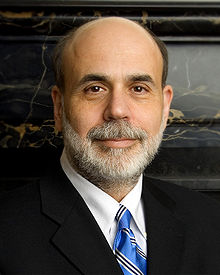
|
| Ben Bernanke |
Nobody likes to execute a guilty prisoner, but in finance, it is surely true that allowing bad debts to remain unresolved harms the whole economy. It makes little difference whether a bank fails to mark its debts to market, whether debts are "extended", or insolvent institutions are subsidized. Andrew Mellon once advised Herbert Hoover that he should "wring the rottenness out of the system", but that is such poor politics that even Hoover rejected it. In time, the process of "good bank, bad bank" was devised to isolate bad debts into a single institution so the rest of the economy could begin to recover. QE3 is a version of a good bank, bad bank. Unfortunately, the public is easily misled in these matters, so although all three Q's involve the Federal Reserve buying long bonds, QE1 unfroze a frozen financial marketplace (successfully), QE2 meant to stimulate the economy (unsuccessfully), but QE3 seems to have much grander ambitions. So it is unfortunate that three different activities share the same name, and still more unfortunate that name is made so mysterious. Let's forget about the first two, and concentrate on QE3.
The Federal Reserve is well along in a program of buying huge quantities of questionable long bonds and has announced it is going to keep buying huge quantities until either inflation exceeds 2.5% or unemployment falls below 6.5%. That's not exactly the same as buying every bad bond in existence, but it could come to that. Instead of letting the holders of those bonds go bankrupt, the Fed is buying the bonds out of circulation, which could rescue a great many investors. Small businesses do not ordinarily issue bonds, so there is some bias in favor of large businesses and banks, but surely not an intentional bias. The effect is to make the Federal Reserve both a good bank and a bad bank at the same time. The main difference between this and wringing the rottenness out is that bankrupt institutions cannot come back to haunt you, while in the more benign purchase of bonds, you have assumed an obligation to pay them back. When you sell them back you drive the price down and the money disappears. Furthermore, when the price of bonds declines, interest rates will rise and the national debt will increase more rapidly. If the economy cannot withstand higher interest rates, a recession will deepen. You have to get the timing right, and the world is in such a delicate state that it is impossible to get the timing entirely right for everybody. Because interest rates are now essentially zero, they cannot go lower, so investment advisors are increasingly advising clients to sell some bonds while they still can. If that gets out of hand, it could start a panic.
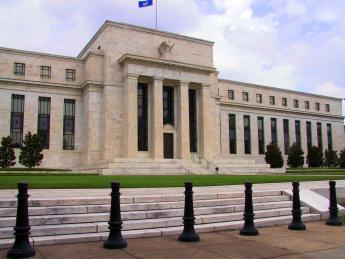
|
| United States Federal Reserve |
However, the United States Federal Reserve is not an investor, it controls the currency and can print unlimited amounts of it. There is nothing which can force it to sell its bond holdings, ever. Without going into the details of the Bretton Woods Treaty, the tie to gold was eliminated nearly fifty years ago. Meanwhile, its bonds are paying interest, which at the moment it is returning to the U.S. Treasury to reduce the national debt. It can reduce this outflow more or less at will, and it can increase it by raising interest rates (ie by selling bonds, as described). With a few extra steps, this enormous pot of debt could become the basis for an international currency reserve. At the least, it could bring a halt to an international currency war. If it chooses, it can decide to wait as long as fifteen or twenty years for economic demand to recover from a century of overleveraging, and then pay it back by letting the bonds reach maturity. But there is at least one big flaw in this dream.
At some point, the bond market may decide to take the bull by the horns and raise rates before the Federal Reserve wishes to. Political appointees come and go, and the bond market could easily decide that a misjudgment has been made by somebody. It could easily happen that public apprehension could grow that something doesn't smell right. In that climate, a few heavy sales could trigger a panic. And then everyone will try to get out the door at the same time.
Federal Reserve Power Play
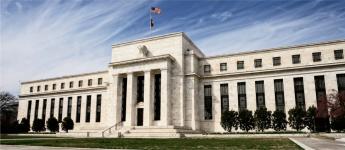
|
| Power Play |
Traditionally, the biggest financial problem for governments -- whether kings or democracies -- have been paying for wars. The Revolutionary War (Robert Morris and the King of France), the War of 1812 (Stephen Girard), and the Spanish American War (J.P. Morgan) were essentially financed by a single institution allied with the government. However, the Civil War, World Wars I and II, were so big that ways of spreading the debt had to be found. In all wars, monarchs seek to maintain control of the nation in spite of their own uneasy dependence on funding sources. The Federal Reserve founded in 1913 was thus founded as a private institution with a Federal partner; it was a public-private partnership.
The enormous sums involved created temptations to extend the Fed's power beyond wars into other cataclysmic financial events. The nature of war changed, both as a cause and a consequence. However, in a sense, politics never change. We hear congressional chairmen ask why the private sector has so much to say, and we hear bankers announce the government has no place in private finance. The Federal Reserve itself maneuvers within boundaries of its "independence". Most central banks have a mission statement limiting them to maintaining price stability (against both inflation and deflation), but the United States Federal Reserve has the additional mission of reducing unemployment. Recently, the targets are stated to be 2% inflation and 6.5% unemployment. The Fed Chairman, Ben Bernanke, now seems to feel the traditional tool of manipulating interest rates is inadequate for severe economic shocks, and perhaps inadequate to maintain both goals indefinitely. He has therefore introduced a novel approach, mysteriously called Quantitative Easing.
Acting as the lender of last resort, central banks have used their regulatory power over banks and currency to manipulate short-term interest rates. Because commercial banks make a profit in the spread between low short-term borrowing and higher long-term lending, the "yield curve" controlling short term rates is ordinarily an adequate lever for Fed purposes to control long rates indirectly. This is possible because so many short-term loans are rolled over repeatedly; the extra interest for a similar long-term bond represents public attitudes about the risks of the future. However, in major financial upheavals adjusting short term rates may become inadequate, and Bernanke sought a way to control long term rates directly throughout the private economic sector.
By controlling both ends of the spread, Bernanke gained more control, but with lessened market guidance, he acquired a greater risk of misjudgment. In any event, the Federal Reserve began to accumulate huge amounts of dubious or "distressed" debt. Andrew Mellon once advised Herbert Hoover to "wring the rottenness out of the system". Mellon meant that any bank foolish enough to offer loans to weak counterparties, deserved to go bankrupt, while those foolish enough to accept such loans deserved to be punished. Although such utterances by a very rich man were politically unacceptable during a depression, Mellon was surely correct in observing that extreme financial panics were basically a psychiatric problem. Irrational exuberance occasionally drives markets too high, panic then drives them too low. The modern twist is, at the turn, when everyone tries to get out the door at the same time, markets can freeze up. Mr. Bernanke civilized Mr. Mellon's approach somewhat, but the underlying idea was the same: get the bad loans out of circulation, so bankruptcies and foreclosures stop feeding public overreaction. Underneath this approach runs the assumption most people are not hopelessly overextended; the economy is basically sound. However, bankruptcy has one advantage here, over gentler kinder ways of isolating bad from further injuring the good. When an institution disappears, its problems are permanently removed from the economy. To a large degree, "sterilizing" operations are only useful if market crises are really artificial ones, which fail to notice how sound the economy really is. As our measuring systems get more precise, of course, market crises might someday actually represent the facts of the matter.
Three signal events extended Mr. Bernanke's latitude to act. His personal credibility had been enhanced by successful QE1 management of the 2008 freeze-up of financial markets. He had loaned when others were reluctant, unfroze the markets, and returned a profit for the government. Secondly, the two-decade Japanese recession showed how "zombie banks" resulted from paralyzed inaction on bad loans. And third, the Scandinavian countries had a glamorous recovery from a brief depression, apparently as a result of adopting Calvinistic punishment of economic exuberance. It was a fearsome "good bank, bad bank" approach. The general public may not have this view of events, but they meant a great deal to the Federal Reserve Board of Directors. His credibility allowed Bernanke to survive his unsuccessful attempt through QE2 to stimulate the economy with trillions of dollars in make-work employment financed by the public sector. In essence, QE3 consisted of buying every bond the market refused to buy, even including billions of dollars of mortgage-backed bonds where politicians were excoriating into accepting prices lower than their probably worth. The Federal Reserve accumulated trillions in bonds but did not pay for them by printing money, but rather by increasing the reserves of commercial banks. This allowed them to pay essentially zero interest rates, but maintain a steep interest curve (between short and long term) as an inducement to the banks to loan. So far at least, banks have refused to loan, partly because banks are trying to de-leverage thirty years of excessive lending, and partly because chastened borrowers refuse to borrow. Meanwhile, the "hard goods" the public had accumulated, autos and refrigerators, mergers and infrastructure, were gradually wearing out; someday they would need to be replaced and constitute "growth". In the meantime, the Fed seems to plan to retain the bad debts in its vaults, safely immune to "marking them to market", which is to say holding them until the bond markets assign them higher values while proclaiming their current market value is temporarily under-appreciated. Nevertheless, these bonds will eventually reach their expiration date, and the market price at that moment will reveal the true cost of replacing them with new loans. With charming modesty, Mr. Bernanke admits there are many outcomes he is unable to predict.
Although Ben Bernanke has not announced it, he seems presently willing to hold these bad debts indefinitely. Interest rates are low, so not only is it cheap to hold them, but their value is artificially overstated. Presumably, however, he is unwilling to run a Zombie Federal Reserve indefinitely. Interest rates will, therefore, return to normal, sending the interest cost to the government soaring. Somehow, the public repeatedly fails to appreciate that lowering interest rates increases the market value of bonds by making money appear like magic, whereas raising interest rates depresses bond values by making money vanish. It requires a vibrant economy to withstand such a shock, so raising interest rates can easily precipitate a deep recession. At the first sign of interest rates rising, the prices of all bonds could plummet. Almost every investment advisor in the nation is already advising clients to "lighten up" on bonds. Meanwhile, the elderly small savers holding their savings in banks, are suffering from lack of income; it is remarkable there has been so little complaint, but when it comes, it will persist and have political force. Somewhere the spring is coiling. One real danger is the economy will still be unready for normal interest rates when politics force them to go up. It is frequently estimated to require ten years to be sure that (unlike 1937) a major second depression will not emerge when short-term government debts come due. The big problem with all borrowing that never changes is that someone expects you to pay it back.
Another bleak possibility is that a currency war will break out during the vulnerable interval. The U.S. dollar recently declined sharply, and other countries responded immediately with devaluations of their own. That may have been a test, but if it was, we failed. Just as industries will move to a U.S. state with low taxes, they will move to nations with undervalued currencies. The new multinational corporation permits rapid internal transfers within companies that they need not move their headquarters. Immigrants do move, and if forcibly restrained, will start riots or even revolutions. Currency wars are also very bad news, powerfully inhibiting government action. Consequently, there is a tendency to substitute international debt default, which is the same thing as devaluation in being sudden and done with, unlike inflation which can be insidious. Since it cheats foreigners more than local citizens, politicians prefer devaluation of the currency. But otherwise, there is no great difference between devaluation and inflation.
To repeat, there is little difference between Country A inflating, and Country B defaulting. Mr. Bernanke has temporarily sterilized the inflation alternative by funding his QE3 by expanding bank reserves rather than printing currency. Unfortunately, this has so far hardly stimulated bank lending at all, which itself is beginning to tempt private investors to get directly into the banking business because it offers them a chance for high yield. However, if any significant number of university endowments or pension funds try their hand at being bankers, they are apt to learn there is more to banking than they imagine.
If Quantitative Easing becomes widespread in a world-wide recession, some nation is going to prove to be insolvent. That is, when the central bank has sold off the profitable or break-even securities in the portfolio, the probability exists that some country will find it cannot service its debt. That debt anyway has been shown to be worthless because no one will buy it. Its credit may then be worthless, its currency without value, its markets in an uproar, and its people in revolt. Other countries will be urged to support the failing one, and who knows how panic will spread. Somewhere along the line, the bond markets may take "the bull by the horns" and -- and what? If foreign governments try to intervene, their own currency could plummet. There is, indeed, quite a lot we don't understand.
So it all boils down to two disastrous alternatives for the Federal Reserve to start liquidating QE3 bonds before the economy recovers. Either the bond markets intervene, or the Federal Reserve just continues to hold those trillions of bonds indefinitely, as a Zombie central bank. We could have a second recession, or another rush to get out the door. The prospects are so horrifying that we all have to hope Mr. Bernanke keeps his cool, and gets lucky. As a fallback, whether all that sequestered debt could be transformed into the international reserves for a new Bretton Woods agreement, is now too distant a prospect for outsiders to have a reasoned opinion about. Nevertheless, the interest earnings of debt that large might be able to moderate considerable deflation. Further, the seemingly unlimited ability to create or destroy money through interest rate manipulation should be able to modulate considerable volatility of currencies, perhaps of economies. Ever since the gold window was closed in 1971, it has been asked whether currencies without the backing of some commodity can survive, and the present economic travail may be the test of it. But since an international currency exchange probably cannot be created except in a crisis, let's hope we never have to learn the answer.
Deficits Don't Matter When Your Party Is In Power
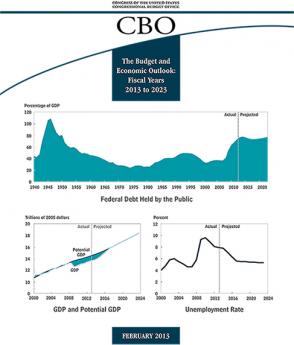
|
| CBO February 2013 cover |
The cacophony that is the economic debate: Paul Krugman reports today (March 11, 2013 in the New York Times Op Ed) that the February 2013 CBO report shows that America's deficits don't matter.
One of his points is that automatic stabilizers did their job: people lost their jobs -> unemployment payments went up -> the pain of the recession was lessened ... and as things improve, government expenditures will go down (are currently going down, in fact).
This is the basic macroeconomics one learns in college, but looking at the CBO's summary I have a hard time thinking our deficit situation is not a continuing problem. The bottom two graphs are hopeful, but the top graph does not inspire confidence. I didn't read the entire report and maybe Krugman did, but the graphs presumably are what the CBO thought summarized their findings.
Funny that Krugman and Cheney have both told us that deficits don't matter. I think maybe deficits don't matter when your party is in power.
The Wissahickon
Recently, Sarah West came to the Right Angle Club and told us about the history of the Wissahickon Creek. Sarah taught at Germantown Friends School for twenty-five years, and in the course of it became the acknowledged expert on the Wissahickon. The mouth of the creek empties into the Schuylkill in Fairmount Park, but the mouth of it is so covered over with a tangle of clover-leaf overpasses, most people zip past without noticing. After that, the drivers of cars up to Chestnut Hill are so busy negotiating the sharp curves, they don't see much of the rest of the creek, either. There's a stop light opposite Rittenhousetown, so perhaps the little village is noticed on the other side of the rivulet, but the entrance is off to the left on Wissahickon Avenue, approachable only from the other direction, so even this cute little village is seldom visited. Pity.
First, notice that the mouth of the creek is just opposite City Line Avenue, so it is an important geographical landmark. The creek is 23 miles long, going right past Roxborough and ending up well beyond Philadelphia's city limits. To a passing motorist, the creek seems to disappear at Rittenhousetown, and the commuter goes on his way through miles of the city before reaching Chestnut Hill. In fact, the creek curves abruptly north at Rittenhousetown and travel twenty miles through woods and wilderness, accompanied by fifty miles of hiking trails. This Wissahickon Park contains about 1200 acres of the 9600-acre Fairmount Park; at one time it was lined with mills seeking water power for one industrial activity or another. From Rittenhousetown to Chestnut Hill College the creek is accompanied by Forbidden Drive, forbidden (in 1922) to automobiles, that is. It crosses Germantown Avenue at that point and circles around Chestnut Hill College, only a branch disappears back into the woods surrounding the edges of the College and Morris Arboretum. On its right that branch of it, starting at Chestnut Hill College, passes (and supplied water for) Washington's encampment at Fort Washington. As a sidelight, Forbidden Drive parts company with the creek at Chestnut Hill College and the main branch of the creek goes on for miles past the Whitemarsh Country Club, then the Germantown Cricket Club, and the Wissahickon Valley Park, eventually reaching its origin in the water runoff from a parking lot off in the country near Ambler, well past Fort Washington, out in Montgomery County.
Only a short part of the Wissahickon is visible from the paved road, which veers to its right near the top of the steepest dropdown of the cliff on the west side of Germantown. That's one of two ridges. Roxborough is on one side of the valley, Germantown and Chestnut Hill on the east. The longest part of the creek veers to the left up to the wooded valley, along miles of Forbidden Drive before it re-emerges to the sight of motorists as it crosses Bethlehem Pike. This was one of several routes followed by sections of Washington's army in their attack on the Chew Mansion in the Revolutionary War. Washington lost, partly because of the stout stone walls of the Chew House, and partly because two sections of his troops got lost in the fog along the creek and started shooting at each other. Even today, the geography around here is so confusing it is really pretty hard to criticize Washington for getting mixed up.
The edge of the Wissahickon Creek was first settled by an early group of Germans led by Johannus Kelpius in the Seventeenth Century; the Kelpius Society feels that colony was located around the Henry Avenue Bridge footings standing athwart the gorge, comparatively near the mouth of the creek into the Schuylkill. Swift waters running downward provided water power for mills, originally paper mills. Paper plus education leads to printing, and at this point was located the heart of German culture, running north and south through all the thirteen colonies; eventually, this settlement of Baptists, Dunkards, and Church of the Brethren moved westward toward Ephrata and other more scattered locations. Sarah tells us that a good workman could produce about three hundred sheets of paper in a day, so it had to be of good quality. Many of the historical documents of the Revolutionary period were written or printed on this paper. Bear in mind, however, that nothing smells so bad as a paper mill.
It takes wood to make paper, so paper mills tend to denude the surrounding hills and start a process of washing away the topsoil. The creeks started to flood in the spring, and dry up in the summer. The final blow of this type was caused by Hurricane Floyd in 1985, which washed away many of the landmark buildings, leaving miles of the woods to the pleasure of hikers and joggers and environmentalists. Sarah West reports that you don't have to walk very far into the woods to find the remnants of mills and mansions, many of which had fruit cellars dug into the side of the basements. Some of these fruit cellars were then extended into tunnels, allowing the Underground Railroad to flourish here before the Civil War. And possibly earlier than that, because this area close to Philadelphia was a favorite place for spies to hide, attracting British raiding parties during the Revolution.
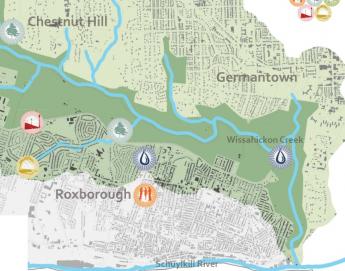
|
| Wissahickon Valley |
But water power was water power in Colonial days, and mills of all kinds flourished up and down the length of the creek until steam power ultimately posed too much competition. For a while, the dwindling water-powered mills supplemented their power with the steam generation, and tall smokestacks, but eventually, water power was driven away by steam power. Whether it was a flour mill or a nuts and bolts factory, grist mills or blanket factories, the product was usually shipped in white oak barrels, which hastened the destruction of the woods and made the flooding worse. Around each mill was usually found a cluster of houses for the workers, so the whole Wissahickon Valley eventually filled with settlements, usually with the owner's mansion dominating the scene, surrounded by little workers' houses. Eventually, the stream became polluted, and the pollution was unfairly blamed for Yellow Fever epidemics. The Schuylkill Water Works and the migration of the factories elsewhere did a whole lot of good for typhoid fever, which definitely is caused by water pollution. So pollution control is sometimes useful even if there is no pollution of the kind you had in mind. The area became Fairmount park, dotted with mansions which used to belong to rich Quaker families with names like Evans and Livezy. There were once five covered bridges scattered along the creek, but mostly they were replaced by bridges, or just got washed away.
So, over the course of two centuries, the pioneers settled the woods, the civilization created a factory town in the middle of a peaceful city, and then the environment took it all back. Now we have a forest in the middle of a city, and rather more unemployment than we want. It isn't fair to say the environmentalists won, it just seems to be cyclic. So enjoy it while you can.
Main Line: Overbrook to Paoli

|
| Alexander Cassatt |
Greg Pritchard, who has made scholarship of the Main Line a central part of his life, recently addressed a meeting of the Right Angle Club. To Greg, the Main Line is the set of commuter rail stops from Overbrook to Paoli, representing what was once the heart of the Pennsylvania RR. It changed into a spur of the real main line, running from New York to Chicago, the central monument left by Alexander Cassatt, its president. Times really do change a lot. There is now only one dingy daily passenger train from New York to Harrisburg, which Amtrak would dearly like to eliminate entirely. The Pennsylvania Turnpike was just too much competition, and air travel has eliminated all railroad passenger interest in further points like Pittsburgh, Chicago, and points west. The real main line of long-distance rail on the East Coast now runs north-south, called the Northeast Corridor, essentially beginning in Boston and ending at Washington DC. Philadelphia is central to all of these versions of main lines, although a thirteen-year lawsuit was required to break combined Pennsylvania and New York Central railroads into SEPTA, Amtrak, and Conrail. At the moment, Conrail the freight line is making tons of money, Amtrak the passenger long-haul line would soon die without government subsidy, and all commuter railroads are subsidized by their local communities. There is a lot of talk about billion dollar investments in high-speed trains like they have in Japan and France, but anyone familiar with the economics of rail transportation just shudders at the thought. Railroads are profitable ways to haul long-range bulk cargo. Passenger lines, long and short, can only be justified if they cost less than expanding highway and airline transportation, which the public obviously prefers. Philadelphia is in the peculiar position that the real estate investment has already been made in passenger rail; is it cheaper to build on what already exists, or is that a doomed relic of the past?
But back to Greg's favorite topic, the revered and treasured 19th Century stations on The Main Line. They were mostly built from 1860 to 1890, along the path of what was then the main line to Chicago, but destined to become a spur leading to the real center of east-west traffic, which went from New York to Chicago further north from Philadelphia, intersecting with what became the Philadelphia spur at Paoli. In the days when Philadelphia was one of the richest cities in the world, the spur was a glamorous suburban real estate development. The stations were built, the mansions scattered along at some distance, and servants houses clustered around the stations. The towns were renamed with Welsh names like Bryn Mawr (instead of Humphryville). A culture was built up, probably unique in the world for being centered on railroad executives, and novels like Kitty Foyle and movies like The Philadelphia Story celebrated the glamor of it all. It's probably true that you can find more fifty-room mansions there than just about anywhere else, but the automobile and good public schools mainly drove the prosperity of the 20th Century, as the railroads dwindled away.
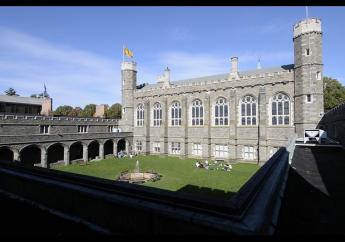
|
| Bryn Mawr College |
The stops on the Main Line begin with Overbrook and continue on through Merion, Narberth, Wynnewood, Ardmore, Haverford, Bryn Mawr, Rosemont, Villanova, Radnor, St. David's, Wayne, Strafford, Devon, Berwin, Daylesford, and Paoli. The main line starts where Philadelphia taxes end and gets progressively newer in harness with the gradual construction of fashionable homes as you get further from the city. At first, Paoli was a place where the out of service trains was stored, but gradually became a fashionable area, which is beginning to leapfrog over the King of Prussia shopping center into the farmlands to the north. The center of gravity of suburban aspirations moves steadily further into the surrounding countryside but is outgrowing the old commuter rail system, and there is something of a movement back to the city. That is to say, urban sprawl is running into the discovery that it's just too traffic-jammed to commute that far, except by train. Most folks are familiar with the jingle that "Old Maids Never Wed And Have Babies" which is supposed to help commuters remember what stop they are approaching. However, the topic mentioned by the jingle and the fact that it ends with Babies (Bryn Mawr) instead of Paoli, strongly implies it was written by a student at Bryn Mawr College for Women.

|
| Centennial Exhibition in Fairmount Park |
The old brick stations have been adopted by affectionate commuters, turned into historical preservation societies. They have a varied history, but quite often the station master lived upstairs, and the first floor housed a branch of the post office. When the railroad straightens out its right of way, the stations have to be moved, often at great expense. As they progressed further into the countryside, sometimes grand resort hotels were built for those who wanted to escape the summer heat in the city, or in 1876, to house attendees to the Centennial Exhibition in Fairmount Park. As these hotels lost popularity, they became excellent bargain real estate for a new college, to begin with, a lessened expense, and the upscale neighborhood which soon clustered about the area insisted, that these colleges move up-scale and get good ratings in U.S. News and World Report. Alexander Cassatt insisted that all transcontinental trains must make a stop in Paoli near his home, and there are even a few stations like Upton which were for the sole use of a single estate. So, at one time when ignorant non-Philadelphians on the transcontinental trains would sniff, "Why would the trains all stop out here in the country?", the Philadelphians in the know would just bury themselves in their newspapers.
Footnote: This interesting talk stimulated me to go read some of the history posted in the Main Line station houses, and in particular the one in Narberth. Narberth was a village long before the railroad came along, and it still holds itself a little aloof from the rest. These and similar places relate that Narberth used to be Libertyville, Bryn Mawr used to be Humphrysville, Cynwyd was once Academyville, Marionville became Merion, and Narberth was purchased from William Penn in 1682 by Edward Reese Price. It is also noted that William Thomas donated his property to the PRR in 1851, and the PRR purchased the struggling "Old Columbia" railroad, formerly the "MainLine of Railroads and Canals", from the state in 1857. Narberth quickly became the center of fashionable summer hotels.
Army War College in Carlisle
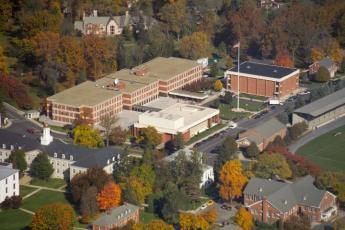
|
| U.S. Army War College |
Our program chairman, Carter Broach, once attended the Army War College, so he was in a position to invite Colonel Tom O'Steen to the Right Angle Club to tell us what the College was all about. Although there may have been times in the past when the Army welcomed secrecy surrounding its College, in recent years it has become concerned that the military may be isolating itself too much from the people it serves and defends. So Col. O'Steen was told he was welcome to talk to us. In fact, giving one speech to the public is a requirement for graduation. The history goes back to 1757, includes Ben Franklin, and also includes some interesting anecdotes which might not have been expected of a War College.
Like all land in Pennsylvania, this plot within what is now the town of Carlisle, PA, once belonged to William Penn. Nobody else owned it until 1757 when Ben Franklin was sent to negotiate its transfer from the Indians. William Penn had been careful to buy land from the Indians, even though he also formally owned it as part of a deed from Charles II of England. Other land proprietors had not been so scrupulous, often complaining of the Indian massacres which resulted, although seldom adopting Penn's rather inexpensive method of avoidance.
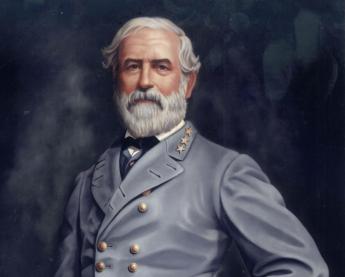
|
| Robert E. Lee |
During the Revolutionary War, Carlisle was a comfortable distance from the British Navy, and served as a backwoods artillery arsenal along the Appalachian Mountains, much as the Ho Chi Minh Trail served our enemy in the Vietnam conflict, along with an Asian mountain range. From 1790 to 1860, Carlisle served as a cavalry post, and then General Robert E. Lee invaded Pennsylvania up one side of a mountain ridge, with General Meade bringing up the Union forces from Washington DC on the other side of the ridge. The two valleys come together at Carlisle, so that spot had long been recognized as commanding both. Lee only got as far as Gettysburg before Meade caught up with him, but General Ewell's Corps took Carlisle as an advance guard. Confederate cavalry General JEB Stuart took Carlisle without sustaining a fight. Meanwhile, General Lee was fretting that Stuart was supposed to be his eyes and ears, keeping him informed of Union opposition, and it is possible that Stuart's Carlisle diversion thus had some influence on the outcome of the Battle of Gettysburg.
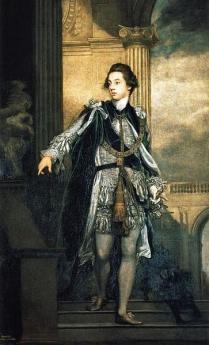
|
| Earl of Carlisle |
By 1879 there remained little purpose in a Carlisle military post, so it was turned into an Indian Industrial School, a couple of miles East of Dickinson College. After the Civil War, the nation lost its taste for exterminating Indians and turned to the idea of removing Indian boys from their families in order to assimilate them to white customs. Unfortunately, this did not work very well, and in fact, nothing worked very well. There are over 340 Indian languages from Eskimo to Aztec, but there is no record of any tribe allowing itself to be assimilated. The Spanish tried slavery, the French tried intermarriage, and the Americans tried persuasion and reasonableness. Eventually, we gave up and isolated them on reservations, but not before a wide-spread attempt was made to isolate Indian boys in boarding schools, hoping to remove them from tribal influences. That didn't work, either, but it was being attempted at Carlisle in the late 19th century. Interestingly, Carlisle is named after the family of the Earl of Carlisle, who was sent by Lord North after the disastrous British defeat at Saratoga, in order to see if the colonists might still be interested in Taxation with Representation. We weren't, so the Revolutionary War dragged on for another six years. Somehow, when war fever captures countries, small victories seems to close minds to what they had been originally fighting over. If the War College has time for another lesson, I suggest they add that one to their curriculum.
Before going back to the origins of the Army War College, we should salute the momentous football game of 1912, between the West Point cadets who included Dwight Eisenhower, and the Carlisle Indian School team which included Jim Thorpe. Thorpe was a member of an Oklahoma Indian tribe, but in many ways has been regarded as the best all-around American athlete in history. Eisenhower was pretty good, too, but Carlisle won the game.
 To raise and support Armies, but no Appropriation of Money to that Use shall be for a longer Term than two Years; To provide and maintain a Navy; 
|
| Constitution, Article 1, section 8 |
Several members of the Right Angle audience expressed the view that the Armed Services have more to fear from know-it-all university professors who feel they monopolize the field of strategic thinking than from Congress, which tends to have a goodly number of combat veterans in its ranks. It's all very well to repeat the mantra that the armed forces must respect civilian control, and then it's also just as well to remember that most coups are military coups in other countries. But whatever the future brings, these young Lt. Colonels will be the ones we must count on when the going gets really tough.
Adoption

|
| Peter Conn |
Peter Conn, a member of the Franklin Inn of Philadelphia, is recently retired from the University of Pennsylvania. Since he has adoption in his family, he became curious about the matter, found that almost nothing has been written about the history of this topic, and decided to write a book about it himself. At a recent monthly meeting of the club, he described his findings, which are pretty surprising.
In a vague sort of way, everyone's general readings do confirm his findings that adoption was frequent among the American Indians, and also among the ancient Romans. In early 6th century Europe, however, it seems to have died out, only to return as a common experience in the 16th century. The first American law that Dr. Conn could find establishing the rules and legal conditions of adoption was passed in Massachusetts in the 19th century, at roughly the time American states were passing laws forbidding abortion. Whether there is a connection between the two movements or not is speculative. However, it does seem pretty likely that our current perceptions about adoption are surprisingly recent, reflecting a strong likelihood that Roman and Indian traditions have nothing to do with it, but fairly recent history might well have a lot to do with it.
Just a little reflection about all the stories we read, alluding to orphanages, foundlings, wards, primogeniture, romantic love, choices of marriage partners, and the like, quickly confirm a realization that conditions and attitudes about reproduction must have changed a very great deal, and fairly recently. It was not very long ago that children were apparently so numerous they could be treated as expendable. Considering how dangerous childbirth has been until recently, current attitudes about "valuable babies" , motherhood, and even the role of women in society must be evolving quickly without our realizing it, and in directions so recent they may well require further revision. Just whose views are old fashioned and whose views reflect modern insights are both judgments we probably should classify as tentative for at least a few more decades.
For example, the dates of major changes in attitudes about foundlings inevitably generate reflections about the attitudes of the Catholic Church. That ancient organization probably has enough troubles with bedroom issues, without adding this one. But the coincidence of the dates with the rise of the Church in Europe, and the subsequent rise of Protestantism, inevitably generate questions about Church attitudes as the cause, or possibly some sociological changes in society which transform both church and reproductive attitudes at the same time. What were the roles of the Crusades, and the Arab invasion of Europe, or the Ottoman invasion? Or the black plague and the white plague, or the Industrial Revolution? We have to know more about these cataclysmic events in order to have even a small idea of whether they might have influenced each other.

|
| Milton Hershey founded the Hershey Industrial School |
It makes a lot of difference whether a culture needs agrarian workers or not, to understand why "the best interests of the child" should only recently have been established as a legal basis for oversight of contested adoptions. Or why inheritance by adoptive children has only been such a recent phenomenon, endorsed by law. What happened to cause the abandonment of all the orphanages we used to have? Why have we chosen to split the issue between adoption and foster care, and treat the two so different? Where do the Girard College and the Hershey School fit into this transition? Why do the Russians feel they are injuring America by forbidding American adoption of Russian orphans?
And get this: during the 19th century in America, when there was a surplus of women on the East Coast resulting from a massive migration of males to the West, about 250,000 American orphans were packed on various trains and sent West. We are told they stopped at a station and let the local settlers select a few, and then the train continued going West, letting off more and more adoptees until they were all gone. Transcontinental railroads were only built after the Civil War, so this sort of child disposal was not more than a century before the political battles of Roe v Wade. We have a lot to learn, and probably a lot to be humble about. So let's not bury the truth under a mountain of political correctness, but let's not have any witch-hunts, either.
REFERENCES
| Adoption: A Brief Social and Cultural History: Peter Conn: ISBN:ISBN-13: 978-1137332202 | Amazon |
Cyprus Tests the Limits of Paper Money

|
| Cyprus Map |
Tourists like to banter about their favorite place in the whole world; until recently, mine was Cyprus. It's an eastern Mediterranean island, where it was possible to swim from beaches in the morning, ski in the afternoon, and luxuriate in an inexpensive but posh hotel in the evening. The locals had their ethnic rivalries, but what would tourist care. Since I was last there, apparently Russian and other billionaires discovered the place, and now three local banks are bigger than the GNP of the nation. Like Ireland, Hungary, Iceland, and several other small European nations, this dystrophic growth made it impossible for the government to guarantee the assets of the banks, as the familiar "lender of last resort" because the banks were bigger than the government. Accordingly, the local government was forced to declare a protracted bank holiday, to forestall what was certainly going to turn into a run on the banks as depositors all tried to get out the door at the same time. International stock markets immediately dropped a noticeable number of points, as the whole world suddenly discovered Cyprus wasn't such a nice place to put your money after all. The Russians might possibly be nasty people, but in this matter of bank deposits, people all link arms internationally like brothers.
There have been lots of other bank panics in small nations without much agitation, so what seems to have bothered the markets was the decision of the Central European Bank to tax the depositors 10% to support the system. Christine Lagarde, the head of the International Monetary Fund, said she thought it was a good idea to tax depositors, and that really upset a lot more people. Ms. Lagarde is French, but the IMF which she heads is located a few blocks from the U.S. White House, so the suspicion grew that Mr. Obama might approve of placing a tax on bank deposits, too. As things started to get out of hand, everyone hastily dropped the whole idea, and even the Cypriote Parliament voted against it. There was no time for even the large organizations devoted to managing the news to manage this one. World opinion was instantaneously mobilized, and thunderous in voicing its low opinion of taxing bank deposits, by anyone, anywhere. What was accidentally aroused was the realization that since the World went off the gold standard in 1971, the world's money is backed by nothing at all except a computer notation? Irrevocably taxing it in bank accounts could be done in an hour.
In 1944 the international conference held at Bretton Woods, New Hampshire, agreed that other nations could exchange their currency for American dollars, but only the U.S. dollar could be converted into gold. As long as the U.S. ran a trade surplus, the gold remained undisturbed in Fort Knox. But when other nations began to export their goods in the 1960s, their dollars began to be changed into gold. Gresham's Law took over quickly since when two currencies of unequal value circulate together, the more valuable one will quickly disappear; the shifting balance of trade had made gold more valuable than dollar bills. When President Nixon began to see that Fort Knox was soon going to be emptied, he put a stop to the exchange. He "closed the gold window". At that point, we were all off the gold standard, but nothing much happened. It remained possible to continue to speak of gold as a "barbarous relic", and by implication, any standard like silver or oil or land was also a barbarous relic. But the experience of Cyprus taught the world that everyone did want the value of a currency to be independent of the whims of government, and like the Emperor's suit of clothes, was just waiting for someone to point it out. A system of monetary exchanges, or exchanges of goods and services, really can be run without backing by anything except the word of government. But inflation targeting does need a government to run it, and thus governments have acquired a power over currencies which centuries of experience had taught people not to trust for a moment. North and South American hemispheric trade had been comfortably run without governments for centuries, as long as there were Spanish pieces of eight in actual circulation. But the modern Cyprus government could not run for a week without the trust of depositors, and neither can any other government. Conversely, it is impossible to run an economy without a government to guarantee the international value of money. People don't like that situation, and the threat of chaos in the streets is not much different in any place in the world which does not run a brutal military system. When you reach a point where even the soldiers refuse to be paid with paper money, you are about at the point General George Washington found himself after the Revolution. Robert Morris convinced him it would be possible to base a currency on the credit of the nation, and General Alexander Hamilton had been taught how to run such a thing. The rest of the country didn't understand what that meant, but they did understand that it seemed to work. But it would only work if the people trusted their Constitution, and the government is designed. But then, our government never tried to put a tax on bank deposits. In fact, it took another hundred years before the American public was completely certain you could trust banks even to exist. The good ol' mattress, that's where to keep your money. If it's in gold coins, that is. Paper money might just as well be in a bank because its value is only symbolic of a government promise.
REFERENCES
| The Battle of Bretton Woods: John Maynard Keynes, Harry Dexter White, and the Making of a New World Order: Benn Steil: ISBN-13: 978-0691149097 | Amazon |
| Robert Morris: Financier of the American Revolution: Charles Rappleye: ISBN-10: 1416570926 | Amazon |
| Bitter Lemons: Lawrence Durrell: ISBN-13: 978-1604190045 | Amazon |
Ruminations About the Cyprus Crash

|
| Map of Cyprus |
The Cyprus banking crisis of 2013 affected thousands of people, some of them very severely, and reached billions of dollars in consequences. But in the scheme of world banking, it was a pretty small event. Its truly serious consequences may lie in the precedents it sets, or the contagion it ignites. It is too soon to know what the full consequences may be, but some pretty serious possibilities are quite evident. The crash was partly the fault of Cypriotes themselves, and partly the result of Russian flight capital overturning a small banking system which could not handle it. The Cypriotes' fault? Sure, it must have been a temptation for a Paradise Island to imagine it could become another Luxembourg or Switzerland. Or Monaco or the State of Delaware for that matter, all seeking to profit from weak spots in the planning of larger neighbors. In any event, it was inevitable that Cyprus will blame the Russians, and the Russians will blame the Cypriotes; in the early reports, it was hard to tell which was the main villain. After that gets clarified, surely the real blame will be transferred to flaws in the design of the Eurozone. On every side, short-term expedients kicked the can down the road, sacrificing sound banking principles to politics. Perhaps it will turn out it had been a good thing to have the smallest participants in European union turn out to be its weakest link, breaking down while repair was still able to contain it.
The European central bank and the International Monetary Fund demanded certain conditions before lending their own money for a bailout. Without much doubt, they canvassed the views of the larger nations in the European Union before doing so. Since Russia is not a member of the EU, to some degree its point of view was probably "neglected". The bailout would not be forthcoming unless the stockholders were wiped out and the major depositors assessed. The stockholders were, in theory, able to elect directors, who were, in theory, able to appoint the bank managers, who were responsible for the banks' contribution to the mess. In addition, it was demanded that the depositors in the banks contribute to the losses. Without much doubt, the mindset of the bailout was that the rich (Russian) depositors were evading local laws by moving to foreign banks, which in this case were supported by the wealth of the whole common market, not just the nation of Cyprus. Therefore, punishing the depositors had the effect of discouraging any future money-laundering which might hope for the financial support of large EU economies, who at present tolerate loopholes created by small EU members. Only depositors of more than $100,000 would be taxed, which would mostly capture non-voting, non-Cypriote depositors, but a 40% assessment is closer to a confiscation than a tax. Since by eurozone rules depositors of less than $100,000 are fully insured, the threshold is completely meaningless, but among populists can be reassuringly termed a tax on depositors who are rich enough to be uninsured. Its confiscatory nature is acknowledged by exchanging the assessment for common stock in the bank since taxes do not normally receive considerations in return. Since the other stockholders were wiped out, the mostly Russian large depositors now appear to own the bank. That surely cannot be the intention, so further modification must be expected.
So there's the first problem to be adjusted: how can the European Union avoid turning the entire banking system of one of its members over to citizens of a non-member nation? Ignoring for the moment the fairly recent Russian disregard for private property, the problems of coordinating the rules of euro banking with the rules of a non-member owner of the whole banking system of a euro member, are fairly daunting. They probably rise to the level of coaxing Germany and Finland into swallowing their pride and bailing out Cyprus, after all. Or persuading France and other advocates of European Union to eject Cyprus from the arrangement, which accords with the opinion of a large number of Cypriotes as well. The problem seems to be this: either a full European bailout or a total ejection of Cyprus seems feasible, but any intermediate compromise triggers consequences which are impossible to assess.
Many other problems are imaginable, as well. For instance, how can a price be assigned to the stock of the banks? Set too high, the former owners will protest they have been fleeced by illegal application of bankruptcy powers. Set too low, the "compensation" would become a windfall for the Russian depositors it was intended to punish. Set too high, the drop in price at the time of future market sales would trigger endless lawsuits in the courts of several nations. This difficulty might be circumvented by making the stock non-transferrable, or salable only to the Cypriote government, both of which would be precedents quite difficult to integrate into a uniform euro zone set of policies, and present a permanent set of future headaches for the evolution of the system. Since the overall plan is to achieve eventual political union by first creating a financial brotherhood, little Cyprus would acquire a permanent voice to which it would not ordinarily be entitled.
REFERENCES
| Bitter Lemons: Lawrence Durrell: ISBN-13: 978-1604190045 | Amazon |
Stress Tests for the European Union
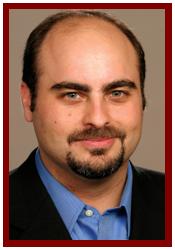
|
| Dr. Ronald J. Granieri |
Dr. Ronald J. Granieri of the office of Secretary of Defense recently spoke to the Right Angle Club about recent threats to the unification of Western Europe. One of his more striking points was that the 1989 collapse of the Soviet Union ending the Cold War, may have unintentionally thwarted the plans for a European Union. The Iron Curtain running from the Baltic to the Black Sea had served as an Eastern boundary for European dreams. When the curtain suddenly disappeared, the European Union was flooded with applications for membership from the recently liberated, formerly Communist-dominated, Eastern Bloc. It was understandable why these countries would wish to get away from Russia, and equally understandable that Russia would be annoyed. But bedazzling expansion was quite unexpected by the European Founding Fathers, who were having enough trouble without doubling their number with weak economies. If Napoleon or Bismarck or some other empire-builder had been in charge at that time, Europe would either have been expanded by brute force, or its borders slammed shut with brute force. But in the clutch, no one was thinking big. Acquiring twenty new nations was an undreamed-for opportunity, but a technical headache for academic theorists. It called for bold action at a time when bold actors were not in charge.
Although it hurts European pride to admit they were following the American model, most of the problems they were encountering were the same problems our own Founding Fathers encountered in 1789. There were two main differences, however, one of which had been written into our Constitution. The other went largely unnoticed. The written difference was we had a bicameral legislative branch, designed to address the issue of voting rights straddling three big states and nine little ones. Pennsylvania had already gone through a dispute over the unicameral Pennsylvania Legislature, which proved to have so much power it unbalanced the three-branch system of government. Consequently, the Philadelphia Constitutional Convention, held in that same building, was already uneasy about unicameral legislatures. It was John Dickinson the delegate from little Delaware, who went to James Madison (of Virginia, then the largest state) and told him bluntly that if Virginia persisted in demanding a unicameral Congress with representatives elected by population size, well, there just wasn't going to be any Union. The three big states refused to participate in any one-state, one-vote, system, while the nine small states wouldn't submit to large-state domination by population size. Either voting by state or voting by population would inevitably result in one side winning every hotly contested vote in a unicameral legislature. So, we had solved our problem by having two legislative houses, one of each kind, and agreeing that legislation would only proceed if both houses were in agreement. What made any legislation possible under these terms, was the informal system of "logrolling", in which informal agreements on seemingly unrelated matters would compensate the loser branch of government, and the states they represented. Since in modern Europe, any group of ten or twenty states in a union would surely have memberships of unequal size, bicameral legislatures seem to Americans to be a perfectly sensible arrangement, so get on with it. The insistence by the League of Nations and the United Nations for one-vote, one-nation arrangements, is a major reason the United States never permitted these supranational forums to have much power.

|
| Iron Curtain |
It's an unspoken truth however, that other nations do not see it our way. That's partly because the German and other parliaments going all the way back to the Roman Senate had established a unicameral tradition in Europe. The other main but unwritten cause of Constitutional differences between the two continents is that we had been surrounded by thousands of miles of ocean, and never had to consider the danger that external and internal enemies would join forces to frustrate our decisions. It is true that many attempts were made to do just this, but they were immediately recognized and easily quashed in the past. As long as the Iron Curtain was operational, Europe thought it might have such ocean-like protection as well, but events in 1989 swept that idea away. With a large addition of formerly hostile states, some members were occasionally bound to join forces with Russia or China, even though they were nominally loyal citizens of the EU. Traitorous behavior had long been an underlying cause of splinter parties and brutal suppression, but that was when Communists were thought by everyone to be agents of a hostile foreign power. With the end of the Cold War, they might become misguided local citizens exercising freedom of speech, claiming a right to argue for behavior which would have formerly been denounced as traitorous. Nations harboring few such inclinations soon became cautious about joining a government with nations who had a great many of them. Citizens of recently enslaved nations were particularly resistant to soothing arguments about unity. It must be confessed that the example of our own Civil War lends force to this feeling of what might happen.
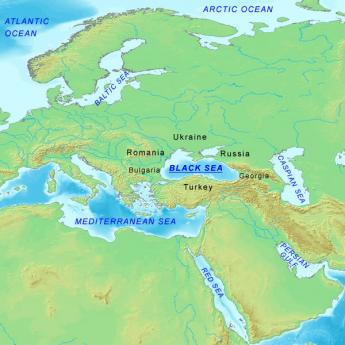
|
| Baltic and Black Seas |
It may be claiming too much to describe the fall of the Iron Curtain, as the major reason for the decline of interest in forming a political union in Europe. That decline did occur and was replaced by the rather weak stratagem of leaving unified government to another time. In its place appeared a strategy of economic unification, hoping the benefits to everyone would become so apparent that unified nationhood would follow. A substrate emerged, narrowing it to a unified currency, the Euro. Bankers and other financial experts argued that such unification would be fairly simple and effective. And so it proved until the same difficulty appeared in a different form. The design of the Euro Currency Zone had apparently underestimated the problems of a foreign currency operating together with the Euro, and variants of Gresham's Law surfaced. Small nation members like Iceland and Cyprus found their small banking systems could not cope with huge inflows of flight money, escaping to tax havens within the Eurozone. As well, underdeveloped member nations actually romanced non-member capital to relocate to their shores. Since local currency is ultimately supported by the full faith and credit of the nation, local banks and economies cannot easily deny equal protections to foreign capital, except temporarily while exchange controls are applied. But when a sufficiently small nation is thus forced to guarantee a sufficiently large amount of foreign money, local banks and markets will be destined to crash. If, in addition, the member nations are deprived of the ability to devalue their currency as the Eurozone could, some type of informal arrangement for a two-value currency had to be devised unless more prosperous members like Germany were willing to subsidize the money flows. When two currencies of unequal value circulate together, said John Gresham to Queen Elizabeth I, the more valuable one will quickly disappear.
Gold Standard Substitutes

|
| Bretton Woods conference in 1944 |
Make-shift proposals to address international monetary crises after 2007, particularly confiscation of bank deposits suggested briefly in 2013 for the Mediterranean island of Cyprus, stimulated a search for a better monetary system. A gold standard sufficed for thousands of years, but the Industrial Revolution increased world economies faster than gold metal was discovered, constantly driving prices downward. It became increasingly difficult to manage the rapid growth of debt, as happens in wartime. The crisis which led to the 1944 Bretton Woods Conference was the inability to accommodate the massive national debt rearrangements of the Second World War. With the United States owning two-thirds of the world gold supply, international trade was seriously impaired.
Bretton Woods created the International Monetary Fund and the World Bank, which can be ignored for present purposes. It established the United States dollar as a "reserve currency", alone able to be exchanged for gold. Other nations were allowed to exchange their money for United States dollars. Supplemented at the Bretton Woods conference in 1944 by this gold-standard-once-removed (the U.S. dollar as a "reserve currency"), this expedient only prospered as long as the United States could maintain a positive trade balance. After 1960, the outflow of gold from Fort Knox was relentless, and in 1971 the United States was forced to abandon its buffering between gold and the world's banking systems. After 1971 the world's currencies would supposedly trust their central banks to be "lenders of last resort", but in the financial crises after 2007 many could not sustain that obligation. What they could do was devalue their currency, and even that expedient was blocked by the rules of the eurozone. Put to the test, the European Central Bank became uncertain it wanted the role of lender of last resort. At one time, the gold standard had provided the one backing for a currency which was independent of all governments' temptation to inflate away their debts. The U.S. reserve-currency buffer extended the system for several more decades, but after President Nixon cut the link to gold, the post-1971 system only provided a promise of a government rescue, without the universal ability of governments to live up to the promise. In a sense, governments backed their currency with a mortgage on the nation, and many mortgages were already overextended. For those nations, variants of the gold standard had been replaced by no standard at all. Since governments which had historically been the cause of inflation were now expected to be the source of its restraint, the private sector urgently needed to devise a new system to force the public sector to accept a new and unwelcome role.
Money on a gold standard was formerly both a storehouse of value and a means of exchange. The world supply of gold was unable to keep pace with the world's increasing wealth for more than a century, so prices were driven down, disrupting long term debts. Rising prices were just as bad; what commerce needed was price stability. What was devised for the 1971 disruption was inflation targeting. The Federal Reserve and to some extent the other major central banks, issued or withdrew currency to achieve a 2% inflation rate, thus hoping to maintain stable prices with a 2% growth rate. Skipping over the details of central banking, the Federal Reserve could safely count on the government to promote inflation at almost all times; the need was to restrain it to 2%. Unfortunately, contraction at 2% takes about as long as expansion at 2%, frustrating the hope of the public to have booms last as long as possible and depressions to be over as soon as possible. Periodic episodes of deflation are a problem. From time to time the economy expands its production capacity faster than consumption can grow, and the inevitable resulting panic not only impairs the ability of banks to lend but frightens the public away from borrowing. Without a gold standard, prices then fall even farther and faster than with gold support because money no longer has any intrinsic value. Our problem thus reduces itself to two requirements.
Without a gold or other monetary standard, and seeking to preserve the inflation-targeting system, how can we induce prices not to fall in a depression? And, how can we induce a booming economy not to increase its production capacity beyond what it can consume or sell, so that every boom period stops being followed by an uncontrollable crash? That is, much of the problem of keeping production from falling, is to prevent it from going so high it has to fall. That's not so easy in a democracy; if you stand in the way of making money when making money is easy, you will very likely be voted out of office. Price controls, by the way, have been tried many times; they always fail. The practical problem is thus pressed into the mode of forcing savings into some sort of escrow fund, during boom times. Meanwhile, the practical politician must persuade a suffering public that, once you overbuild capacity, it will probably only wear out at the same 2% rate that it took to grow so big. These are not new sentiments; the public must learn self-restraint during booms, something it has repeatedly resisted.
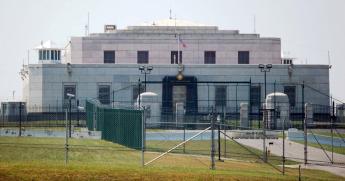
|
| Fort Knox, KY |
Features particularly irritating to the private sector about the Cyprus proposal had several sources, all of them heightened by annoyance that the bureaucracy would immediately try to force the private sector to pay for administrative design blunders. A gold standard permits international trade in defiance of government wishes; a currency without a physical store of value cannot exist without workable rules for international trade. If satisfactory rules cannot be made, voices will demand a return to the gold standard. No one said the Greeks and the Turks should love each other; no one said the Russians must respect private property. What is stated is if workable rules are not forthcoming, private alternatives will arise.
Ben Bernanke is not only the chairman of the U.S. Federal Reserve, but he is also one of the recognized academic experts on managing depression. He has spent his life studying this particular problem and occupies the most powerful position among the group charged with doing something about it. His innovation in the management of a financial crash is QE, quantitative easing. Essentially, this amounts to the creation of a fund managed by the Federal Reserve, generated by purchasing bonds with money created by the Fed. The content, size, and purpose of the fund have varied in the past few years, to the point where it amounts to a gigantic fund at his disposal, as needed, Initially, it injected funds into markets frozen with fear, and successfully unfroze them, making a profit for the Treasury along the way. He next used the fund to manage a gigantic Keynesian effort to stimulate the private economy with a federal fund. While it is possible this stimulus averted some worse disasters, the net effect was not outstanding and is generally regarded as a failure. His current effort, titled QE3, amounts to an enormous effort at what is termed "good bank, bad bank" in financial jargon. Because so many good bonds are undervalued in a recession, it is believed they will return to true market value if the truly bad bonds are removed from the market place. In Victorian days, this was accomplished by bankruptcy, but it is thought to be more humane to buy up and remove them temporarily from the marketplace. The humane approach, of course, has the disadvantage that the bad bonds may reappear later, and some critics say it is only a variant of "kicking the can down the road." It seems to have worked well for the Scandinavians however, and the final verdict cannot yet be issued. For the purposes of the present discussion, the essential point is that a three-trillion dollar discretionary fund has been put in the hands of the most powerful and most knowledgable person involved in international finance. At the moment, the fund contains most of the dubious bonds in circulation, but there are signs that Bernanke plans to replace them with U.S. Treasury bonds, thought to be the safest investment available. He can essentially do anything he pleases with this fund, subject only to the approval of the rest of the Board.
It must have occurred to Bernanke, that this multi-trillion dollar fund of the safest investments on earth would make a highly suitable substitute for gold, if it ever becomes clear that the world needs to return to some tangible commodity to back its currency, or become the new lender of last resort, if we choose to put it that way. Mr. Bernanke essentially needs no one's permission to create this fund, but to use it in some novel way would require the permission of politicians, acting in some way identifiable as the will of the American public. If it should come to that, a few suggested limitations immediately come to mind.
In the first place, one of the main purposes of imposing a gold standard on spendthrift Kings was to keep the King from spending it and substituting his own worthless paper money. Three variants of this threat, inflation, devaluation and confiscation, all amount to the same thing, which would get us back to our present predicament quite quickly, indeed. Mr. Bernanke must realize that our Constitution was written by Founding Fathers who were intensely fearful of entrusting as much power to one person as Mr. Bernanke would likely possess if this idea moved to implementation. To put it bluntly, the first action after it is done should be to surrender the ability to do it. To take another lesson from Constitutional history, it might be remembered that the functions of the Legislative Branch were established in six months, those of the Presidency evolved in the first five years of George Washington's office, and those of the Supreme Court required forty years to evolve. During all of that time, the ability to destroy the Constitution's main purposes had to be shielded from unbelievers, and an apparently unnecessary Bill of Rights had to be appended to reassure the remaining doubters. The main risk to this technical monetary reconfiguration is not monetary, but political.
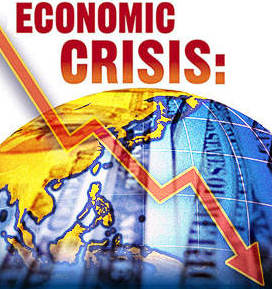
|
| Financial Crisis |
But there are technical issues, as well. Because they are technical, it is more difficult to depend on wise public opinion, and thus it enhances feasibility when technical issues can be translated into political speech. Because events have demonstrated it is much more difficult to reverse a depression than a bubble, thought should be given to devising ways to use this new vehicle to reverse depression. Obviously, it should be used to unfreeze a frozen market; that's an important lesson from the success of 2009. Furthermore, the revenue from three trillion dollars of bonds is appreciable and should be used to finance tax reductions in a recession. More importantly, it should be withheld from government treasuries to restrain a developing bubble, more or less forcing governments to raise taxes during a bubble. Perhaps standards are necessary for expansion and contraction of the fund itself to supplement the use of the fund's income in those extreme situations. Indeed, to forbid the use of principal for those end-purposes might leverage the effectiveness of changing the fund balance, because it would force larger swings of principal to be adjusted. Most of these considerations come into play when a bubble is being restrained because it is easier to restrain a growing bubble than to repair the damage once it bursts. Restraining a growing bubble is not easy, and picking the right time is still less easy. Better to make most of it automatic, and related to defined market benchmarks. Benchmarks may be inaccurately chosen, but at least something is learned for the next time.
Mr. Bernanke's QE fund is not the only one which could take the place of gold in a new monetary standard. Commodities of various sorts would not be much different from gold and might soften the volatility of the mining supply. Land could be used, or fresh water, or petroleum; perhaps we could divide up the ocean in some way. Among the more attractive candidates would be world index funds of stocks or bonds; bonds seem perhaps more suitable, perhaps not. But at the moment, no one seems to be exploring any substitute monetary standard other than gold or the QE fund. Perhaps the disadvantages of each would cancel out in a basket of all the suggested standards. Perhaps inflation targeting can be improved, and no other benchmark is needed; perhaps international branch banking could cover the requirements. And perhaps it is all an academic exercise, but it would still seem helpful if academia would explore a little further, just in case we need them.
Proposal for the Parkway
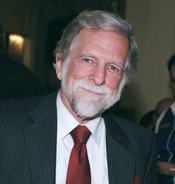
|
| Alvin Holm |
Architect Alvin Holm spoke recently about an idea he had dreamed up in 1986, for an amphitheater in the Eakins Oval, right in the middle of the Benjamin Franklin Parkway. At that time he envisioned it as a memorial to Grace Kelly, but Monaco wasn't interested, and the City was broke. But times change, neighborhoods change, and maybe the idea needs to be re-examined.
A bit of history needs to be refreshed. Around 1900 when the Parkway was dreamed up, Philadelphia was said by some local boosters to be the richest city in the world. That may have been a little overoptimistic, but it was nearly true enough that no one laughed loudly when it was enunciated. The Parkway was envisioned as a new departure to transform the whole city from square blocks of red-brick buildings of Georgian style, into a classical French version of grand elegance. To emphasize the new departure, it cut a diagonal from City Hall to the Art Museum, uniting these two French architectural monuments into a transformational classic boulevard. It wasn't just an imitation of Champs Elysees, it was a design by the very same architects, intended to lead the centers of many great cities of the world into modernized versions of the Roman Forum. Paris somehow managed to get away with it in time, but the 1929 crash stopped Philadelphia's dreams dead in their tracks, and the city just didn't recover.
Consequently, vast stretches of North and West Philadelphia were abandoned, then transformed into slums as poor people sought cheap housing. If you just look at Baltimore and Newark, you can easily see how sudden reversals can destroy a city completely. Philadelphia retreated into Center City, surrounded by an inner ring of slums, which were in turn surrounded by a ring of newer suburbs. The automobile hastened the flight to the suburbs, while the business district retreated to the inner core of Center City. In order to protect the Shining City on a Hill from being completely disrupted, informal barriers were sought, and the Parkway became one of them. They weren't walled moats, but they served the same purpose. Therefore, during the long decades of limping along, occasional cries of, "Why don't we make the Parkway into a grand boulevard?" had a silent, sullen answer. We weren't really sure it was a good idea. It didn't fit within our revised circumstances.
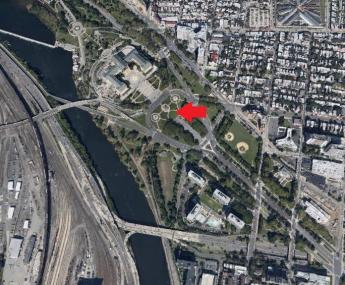
|
| The Amphitheatre on the Parkway |
But the City is now getting back on its feet, as anyone who has noticed the astonishing restaurant revival of Fairmount Avenue, or of Old Towne, or Society Hill, and the rebuilt "Chinese Wall" leading to and from the old Broad Street Pennsylvania Railroad station, can easily see. The Independence Mall and the University of Pennsylvania areas were largely built with Federal Money, but no matter, the transformation is still evident, the tide has turned. So Alvin Holm got out his drawings about premature dreams we couldn't afford, and asked, "Is it time?"
The unfinished Ben Franklin Parkway has cut its path, willy-nilly, through the neighborhoods, the trees have had time to grow, the museums time to migrate. The childless couples of the metropolitan area were coming back in town to enjoy the restaurant revolution and the theater revolution. Alvin Holm was getting a little older but not less energetic. He remembered that at the foot of the Art Museum was a statue of George Washington on a horse, and behind our First President was a big expanse of empty land. To build an amphitheater only took bulldozers, and could seat a thousand people. If you were as lucky as the ancient Greeks, and possibly if you built in precisely the same way, a speaker in the center could be heard -- without artificial amplification -- if he whispered, by everyone in the amphitheater audience. If you do use electronics, there's plenty of space in back of General Washington for a dignitary to give a speech on a raised platform, and there's enough empty audience space in a wider sweep, for fifty thousand people to congregate and listen. To him, or to a rock band, or whatnot. There aren't very many places left on earth in the center of a big city, where a single person can stand against a magnificent classical background, and be heard by fifty thousand chanting, hollering true believers. All of this could be accomplished by essentially digging a hole in the ground and closing off the area to traffic. But oh, yes, it takes one more thing. You have to want to do it. So let's consider for a moment who else covers the neighborhood, waiting for the right time to make a move.

|
| Amphitheater Sketch |
Instead of regarding Fairmount Hill as just a big obstacle to automobiles trying to get home, let's just see what some others are thinking. For example, the people who run Drexel University are seriously talking about buying the air rights above the railroad marshaling yards on the west bank of the Schuylkill, and putting up a major business district and residential complex. They are thinking mainly of reviving West Philadelphia, and that's fine, but another bridge at that spot is badly needed to divert traffic around the present choke point on the Schuylkill Expressway, and that's also fine. Put some paths down to the river from the Art Museum to meet a new pathway to the Drexel development, as well as the recreational area along the river, and you could really have something pretty nice for the commuters who would otherwise begrudge the cost of digging an amphitheater hole in back of G. Washington.
Looking to the north of the Art Museum, there's a second small mountain with Kelly Drive between the two. At one time, both hills had reservoirs on top. The Art Museum demolished one reservoir, but the other reservoir is still there. It's a fifty-acre lake surrounded by dense forest; but from the inside look back over the top of the trees and you can see skyscrapers, almost right next to you. It's been adopted by migratory birds as part of the Atlantic flyway, and you would just be amazed at the hawks and ducks and all manner of other little black jobs that fly around and get recorded by bird watchers. The lake is full of fish, probably originally dropped by passing birds. The Audubon Society has a fundraising project going on, right now, to build a visitors' center in the forest, in conjunction with Outward Bound, the rock climbers group. Go to the left and you are overlooking the races at Boathouse Row, turn in the other direction to see Girard College, the hospital complex, and the further north you get to Temple University.
And one more thing. The old B&O Railroad once snaked along the Schuylkill and turned right around the (now) Art Museum, through tunnels over to Spring Garden Street, and down to Reading Terminal. Just what to do with this ditch running through the center of town unnoticed, is beyond my scope. Let someone else have a chance at being a visionary, but it must be remembered that New York City recently had a similar relic on its hands, and made something pretty nice out of the West Side of their town.
All of this potential even has the danger that projects will collide with each other, so it would sound like a nice idea for some Foundation to put together a planning board, to fit it all together without getting mixed up in politics, or squabbling over who will run things. But even that fuss would be a novelty, a nice thing to have for a while.
Glen Foerd, Torresdale, and the Feudal Industrial Style
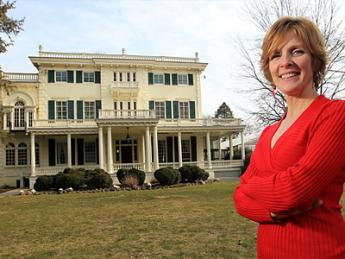
|
| Meg Sharp Walton |
Recently, the director of Glen Foerd on the Delaware, Meg Sharp Walton, told the Right Angle Club all about the mansion, the industrial titans who owned it, and the surrounding community which keeps it going. Glen Foerd Mansion sits on the small bluff where the Poquessing Creek enters Delaware. It's on the south bank of the creek, so it is just inside the Philadelphia boundary. Charles Macalester, who built the original mansion was a financier who sat on the board of the Second National Bank. So it is not surprising that he built a summer place just downriver from Nicholas Biddle's "Andalusia", which is on the north side of the creek. The Philadelphia consolidation of city and county government left one mansion in Philadelphia, and the other one in Bucks County. The region is perhaps better known for the little company town of Torresdale, and even better known for the Torresdale water inlet, where much of Philadelphia's water comes from Delaware. The Torresdale stop on SEPTA makes it an easy commute from Philadelphia, as does I-95, some of the time. The creek's inlet into Delaware is swampy, as most such confluences are, and is a favorite place for bird watchers and nature lovers. The tidal nature of Delaware at that point is quite apparent; at some times of the day, much of the bank of the inlet is bare ground.
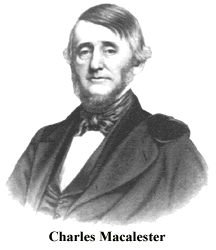
|
Charles Macalester may well have been the right sort, but he sold the property and left his estate to Macalester College in Minnesota, so Philadelphia doesn't find much to remember him by. After all, the early Quakers wouldn't even consent to put their names on tombstones, let alone name colleges after themselves. Robert Foerderer bought the property around 1850 and embarked on an elaborate renovation project. He had made his pile of money by purchasing the French patent for making kid leather and eventually had 5000 employees in Frankford making the material for kid gloves. The mansion on the river could be said to be the apex of an industrial empire, quite typical of how Philadelphia, particularly Northeast Philadelphia, did things. He was said to have been quite a benevolent emperor of this kid glove empire, including the little company town of Torresdale, until there was an industrial uproar of the 19th Century variety. Whereupon, he abruptly shut the whole business down, just as John Roebling did when his company town across the river wanted to run its own town. There's a sort of European flavor to this sort of story, sort of an opera about a principality on the Rhine River. This area of northeast Philadelphia and Bucks County has a number of principalities with this sort of town cohesiveness, where families who work there are clustered around their factory center, and children, and grandchildren, and great-grandchildren tend to stay in one place to live a life which ignores the rest of the world. Someone has to be the boss of such communities, tends to regard the position as hereditary, and definitely resents the idea that anyone else has much to say. Central to the concept is the Horatio Alger story of the hard-working youngster who gets to the top by merit, leading to the conviction that if someone else wants to be at the top of a heap, let him first build his own heap. Somehow, the Foerderer story seems to add realistic color to what was true about this social system.
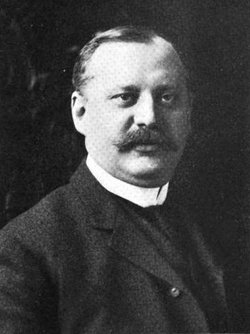
|
| Robert H. Foerderer |
Robert Foerderer died fairly young, having married Caroline Fischer, and producing a daughter, Florence Foerderer Tonner who married a New York hosiery tycoon named Tonner. The ornate decorations of Glen Foerd, the idiosyncratic taste in art, the parties and the ostentatious social circle, all add up to the sniffy description of "new" money, the so-called nouveau riche. The hundred older families of the Philadelphia establishment were very cautious about mixing socially with such newcomers and their often unexpected behavior, although there were notable exceptions. In all this uproar you can see the origins of the two present political parties, with the "old money" rich people displaying a quite surprising preference for redistributionist economics and environmental protectionism. It's easy to exaggerate, but a good part of this enduring split is due to social resistance of the older settler families to new ways of doing things, particularly when new ways have not demonstrated unequivocal value.
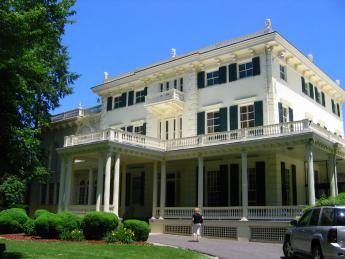
|
| Glen Foerd Mansion |
But returning to Glen Foerd, the name is a composite of the original Glengarry and the newer Foerderer. Florence Tonner got one of the first television sets to be produced and put it in the middle of her gallery of fine art. She sat there watching her favorite TV shows, why not. In her will, she left the estate to the Lutheran Church, but during the Depression, the church had trouble keeping it up. Someone discovered a clause in her will which provided, that in the event the Church could not support the estate, it was to be given to the residents of Torresdale. Since Torresdale only consisted of two streets, not including East Torresdale, West Torresdale, and any other splinter communities, the ownership of the estate was pretty closely held. This small group of true believers took up the burden and tried to make the estate survive. The house was opened to visitors, and available for weddings and events. Adult education courses, small-scale Chautauquas, bird-watching and nature walks were established. Slowly, the residents have been succeeding in making a go of it, but the original residents are getting older and dying off. It's going to be a hard struggle to make the place self-sustaining on every necessary level. But we wish them well, and certainly, admire their spirit.
Gas House, the Real Thing
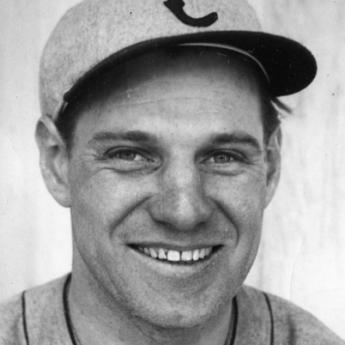
|
| Lou Durocher |
Gas House Gang is what Leo Durocher called the St. Louis Cardinals because of their scruffy appearance. One suspects he was really bragging about his once playing for the New York Yankees, a distinctly upscale background, in his view.

|
| Gas House Gang |
But there really once were gas houses, and a somewhat used one still exists on the Foerderer estate, Glen Ford, open to the public (on request) in the tiny village of Torresdale. We have this information from Meg Sharp Walton, the director of the Glen Foerd Museum. Waltons have lived in the area since 1675, about a decade before William Penn arrived, so they ought to know about these things. According to her, the gas house supplied gas for the surrounding houses before the days of household electricity. Every Monday, the gas house burned something she knows not what, to produce gas.
What else would you call such a place, except a gas house?
Societies and Clubs
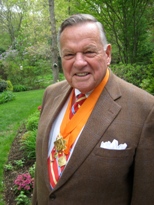
|
| President Zabriskie |
A former president of the Holland Society of America recently explained the difference between a Society and a Club. Most of us supposed there was no difference, but it seems that a Society is permitted to be discriminating in its membership, while a club is not. In this quarrelsome age, that probably makes an important difference, but you will have to get a lawyer to explain exactly what it is.

|
| The Holland Society |
As best it can be made out, a Society is permitted to be an organization with a certain composition, which would be quite illegal if done by a club. The fine points of the distinction have to do with what is in its Constitution, as distinguished from what is in its By-Laws, another distinction which would puzzle most non-lawyers. And it would appear it is helpful to state a reason for the discrimination in the Constitution as well. In the case of the Holland Society, the constitution limits membership to descendants of Dutch Americans of the male line who immigrated before 1675. And the reason for this discrimination is to preserve the family names. Women are allowed to be associate members, however. Have you got that straight, ladies?
And now, we are all left floundering for an explanation of what an Association is, and why it isn't the same as a Society or a Club.
George Mason and Triumvirates
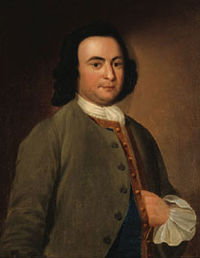
|
| George Mason |
George Mason was George Washington's neighbor in Virginia, a good friend, and an important contributor to the Constitutional Convention, once he got there. There was every reason to think he would be an enthusiastic supporter of the document, but at the end of the Convention, he refused to sign it. Various explanations for his behavior have been offered, but one that might be considered is that he offered a proposal to have the President be replaced by three people, one from the North, one from the South, and one to be drawn from the middle colonies. He was pretty passionate about his idea for a triumvirate, so passionate it rises to the level of a possible explanation for his refusing to sign.
We have not yet been able to define the Power of the Executive; and however moderately some Gentlemen may talk or think upon the subject, I believe there is a general Tendency to a strong Executive and I am inclined to think a strong Executive necessary. If Strong and extensive Power is vested in the Executive, and that Executive consists only of the one Person, the Government will of course degenerate, (for I will call it degeneracy) into a Monarchy-- A Government sop contrary to the Genius of the People, that they will reject even the Appearance of it. I consider the Federal Government as in some Measure dissolved by the Meeting of this Convention. Are there no Dangers to be apprehended from procrastinating the time between the breaking up of this Assembly and the adoption of a new System of Government. I dread the Interval. If it should not be brought to an issue in the Course of the first Year, the Consequences may be fatal. Has not the different Parts of this extensive Government, the several States of which it is composed a Right to expect an equal Participation in the Executive, as the best Means of securing an equal Attention to their Interests. Should an Insurrection, a Rebellion or Invasion happen in New Hampshire naturally ascribe any Delay in defending them to such a Circumstance and so vice versa. If the Executive is vested in three Persons, one chosen from the Northern, one from the middle, and one from the Southern States, will it not contribute to quiet the Minds of the People, and convince them that there will be proper attention paid to their respective Concerns? Will, not three Men so chosen bring with them, into Office, a more perfect and extensive Knowledge of the real Interests of this great Union? Will not such a Model of Appointment be the most effectual means of preventing Cabals and Intrigues between the Legislature and the Candidates for this Office, especially with those Candidates who from their local Situation, near the seat of the Federal Government, will have the greatest Temptations and the greatest Opportunities. Will it not be the most effectual Means of checking and counteracting the aspiring Views of dangerous and ambitious Men, and consequently the best Security for the Stability and Duration of our Government upon the invaluable Principles of Liberty? These Sir, are some of my Motives for preferring an Executive Consisting of three Persons rather than one
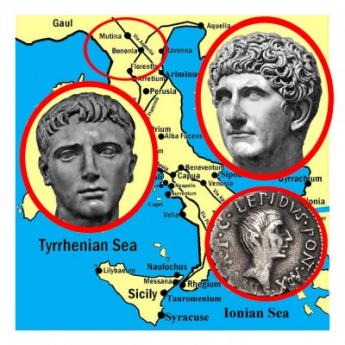
|
| Marc Antony, Lepidus, and Octavius Caesar |
The Constitutional Convention has been described as being strongly influenced by the Senate of ancient Rome, and Shakespeare's depiction of it was very popular in the colonies. It, therefore, seems strange that Mason would be so strongly attracted to a form of government which attended the dissolution of the Roman Senate, and the long reign of Emperors which followed it. The first triumvirate lasted only five years and consisted of Julius Caesar, Pompey, and Crassus. With Caesar's move toward the throne, this particular triumvirate did not come out to what would have been the American colonist wishes. The second triumvirate also only lasted five years, consisting of Marc Antony, Lepidus, and Octavius Caesar. Shakespeare tells us in no uncertain terms that did not work out. In both cases, two of the three went to war with each other but first disposed jointly of the third. Mason does not mention the Roman examples, perhaps because they posed inconvenient outcomes. Perhaps this tobacco farmer was not sufficiently learned about Rome, but it is also possible that he was thinking of the three centuries of Roman history where there was a succession of Emperors, mostly bad ones. During that period, Rome was really ruled by many triumvirates with subordinate absolute powers, specifically denominated. Essentially this was an organized aristocracy and it supposedly worked pretty well. And perhaps George Mason just secretly disliked Washington or feared tendencies he was close enough to know about. Or maybe six other things. We certainly can be sure the rest of the convention knew some Roman history, and definitely did not want to see either a King or an Aristocracy. No matter how gentle and persuasive, one of their esteemed colleagues might be about it.
Philadelphia to Savannah: A New View
Bob Reinecke and I recently took a trip by boat down the inland waterway to Savannah. There isn't time to recite all the details, but four or five real surprises popped up, and maybe there is time to talk about them.
The first discovery was an accident of my visiting my daughter in Northern Virginia, and discovering there is no direct train service to Williamsburg. It's only once a day, each way, but it is direct from 30th Street Station to the train station about a hundred yards from the hotel in Williamsburg. Actually, it starts in Boston and goes to the Portsmouth Naval Base, branching off at Richmond toward the banking centers of Charlotte, North Carolina. But Williamsburg is about the only tourist destination in Virginia if you haven't been paying attention, while 30th Street is about the only place to take a train, right? We had a lot to learn.
A travel brochure announced there was a cruise boat of about a hundred passengers, which leaves Richmond, goes down the James River, and then heads south on the Inland Waterway, making stops along the way until it ends up in Savannah, Georgia. On this particular trip, there was a busload taking tours of Revolutionary history, and a second one taking Civil War excursions at every stop, take your pick. Most people took the Civil War choices, but the lecturers were both excellent, and it pretty much turned into two tours on a single boat. We learned the hard way that the only train to Richmond gets there after the boat has already departed, so it was necessary to arrive a day early and stay in a hotel. We were certainly glad we did because Richmond is having a revival since the devastation of the Civil War. A dozen hotels and restaurants cluster around the train station, which is a few blocks from the renovated Capitol, sitting on top of a hill. The hill has been extensively undermined and turned into a pretty elaborate museum, well worth a two-hour visit if you get there at the right hours. Not far away is a perfectly spectacular art museum, apparently donated by Paul Mellon, and well worth a four-hour visit. Paul Mellon has also donated his huge collection of British Art to the Yale Museum, and of course, the Mellon Gallery in Washington was largely given by his father. The Mellons of Pittsburgh may well have been pretty tough bankers, but in the art world, they certainly knew their stuff. Even if the Virginia museum didn't contain a single painting, the building itself would be worth a trip to visit.
Richmond also has a secret treasure in the James River. A century ago, every major river on the East Coast would have a major run of spawning shad fish, about the middle of April. One by one, the rivers were dammed up at the "fall line" and industrial pollution put an end to the shad run. That was probably also getting to be true at Richmond until General Grant and his army put an end to industrialization. For whatever reason, Richmond is the only major city on a river that still has a spring shad run. Since the river runs through the center of town, the big problem for fishermen is to find a boat to rent, and this spring event is largely forgotten. Four or five big restaurants were pointed out as specializing in seafood, but although I called them all, none of them knew what a shad is.
When you go down to where the tourist boat docks, however, you soon find the local teen-aged boys know all about shad, and a hundred or more of them line the banks with their fishing gear. As you might expect, fishing is best toward dusk in the evening, and around dawn in the morning. Unfortunately, we were late. The boys were all pulling in strings of six or eight fish on a line, but they were uniformly small ones. The big fish spend all winter in the Bay of Fundy, and return to the river where they were born, to spawn again. So the big fellows, the fish that were supposed to have rescued George Washington at Valley Forge, had already gone upstream to spawn, and all that was available to the teenagers were young fry, trying to return down the river toward the Bay of Fundy. Incidentally, although the Hudson River has also pretty much lost its industrialization, there is no shad run on the Hudson. The explanation seems to be that the striped bass congregates along the abandoned piers on the New York waterfront, and devour the shad fingerlings on their way out to sea. In Philadelphia, it seems to be the refineries at Marcus Hook that give the shad their fatal problem.
So off we sail from Richmond, making the first stop at the mansions along the James River. Of particular interest is the splendid mansion of William Henry Harrison, of Tippecanoe and Tyler, Too. You know, the fellow who won election to the Presidency by advertising he had been born in a log cabin. Off down the James River, where two more surprises await the callow Philadelphia visitor. We knew about Williamsburg, but it was a surprise to find that both Jamestown and Yorktown have been restored within an inch of their lives, each one just as interesting as Williamsburg. The woods surrounding these three colonial villages are manicured and painted, filled with an incredible number of retired military. As you tour the area in buses, it becomes clear that almost the entire peninsula between the James and York Rivers is filled with military reservations of various sorts, Air Force, Naval, Marine, and at least two hush-hush CIA establishments. This is what Generals Grant and McClellan fought over as the "wilderness", attempting to take Richmond from the rear. If you add to this military complex the huge establishment of government contractors neighboring Washington, it is easy to see why the demographics and politics of the Old Dominion are rapidly changing.
One of the military retirement villages in the area is Fort Monroe, on an island in the mouth of the Chesapeake. Like Pea Patch Island in the Delaware, and Fort Sumpter to the south, this fort was constructed after the War of 1812 as one of a chain of defenses for the Atlantic Coast. It once housed President Jefferson Davis as a prisoner after the Civil War, and the house where Lincoln stayed is proudly on display. It looks like a really nice place for a retired Colonel to live if he enjoys sailing and fishing. Nearby, both the Merrimac and the Monitor are under reconstruction as museums, together with the museums which display how naval warfare was completely transformed by two iron boats in a single afternoon.
So off down the Inland Waterway on a ship that scraped bottom a couple of times on the previous journey. Because of our maritime unions, only a ship that has been constructed in America is allowed to sail between two American ports, and only American employees are allowed. That makes for scarcity, and although it is pleasant to be surrounded by a thoroughly American crew, it makes this sort of cruising expensive. But the sense of American history is heightened, as you go past towns that were burned by the British, and gardens that were planted by members of the Continental Congress. Particularly Beaufort, which General Sherman decided was too beautiful to burn. You can walk the side streets of Charleston, where "Porgy and Bess" was portrayed, and imagine you see the bombardment of Fort Sumpter. Savannah, the fictional home of Rhett Butler the blockade runner in "Gone with the Wind", the home port of Revolutionary blockade runners, the site of smugglers for prohibition days -- affects an atmosphere of decay and decadence which air conditioning has rendered obsolete, but still attracts tourists looking for a thrill.
And so we ended the trip as we began it, by telling the local guides a thing or two. It was thirty miles north of Savannah on the Savannah River, that our famous Philadelphia river expert, Ruth Patrick, advised the President of DuPont to place the manufacturing center for the hydrogen bomb. She lived to be one hundred five years old, and the building which bears her name can still make bombs as needed. And not one guide or employee of that ship, or resident of that town, had ever heard of her.
Barnes Foundation -- Drawing a New Moral
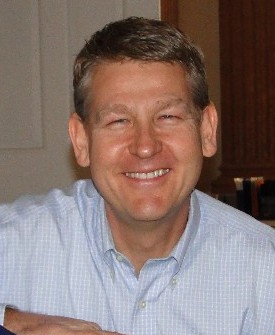
|
| Andrew Stewart |
Andrew Stewart, the Public Relations Director of the Barnes Foundation, and for thirteen years a member of its Board of Directors, recently addressed the Right Angle Club. He gave a new slant to the quarrelsome saga of Dr. Barnes' will, offering the point of view in favor of moving the paintings to the Parkway. It's useful to hear the legal and historical background because about all we hear are criticisms, balanced by joy at having the famous paintings where we can see them.
Essentially, the will declared a wish for the School and Museum to follow the original indenture. After the passage of time, the old board members died off, and the new board members found the Indenture to be out of date, like specifying the purchase of railroad bonds. Delivered in a charming Scottish brogue, the argument was fairly convincing. But it stimulated in me an entirely different moral from the eternal dispute between the right of a man to have respect paid to his expressed wishes for his own property, versus the self-defeating quality of the same restrictions with the passage of time.

|
| Barnes Foundation |
Barnes was born in Kensington, and had a hard life as the son of a Civil War veteran who lost an arm in the war, and had a dismal time making a living as a butcher. Barnes was his fighting-spirit son, who worked his way through medical school. It was Jefferson Medical College, where I was on the faculty for decades. While it is true his patent medicine gave a permanently sickening color to the children who were treated for sinusitis, it is also true that in the form of eyedrops it prevented the transmission of syphilis to millions of newborn children. In that view, it was a real scientific contribution, although the medical profession continues to take a dim view of doctors advertising their wares. Although he was himself a failed artist, Barnes was a highly successful collector of (then) modern art and started a school with John Dewey to teach art appreciation to poor people. One by one, the local universities snubbed his wishes for an art appreciation school, and the local Philadelphia museums were pretty sniffy about his favorite artists.
In fairness to them, Barnes was probably pretty pushy in his demands. Unfavorable local reception to an exhibition which had received rave applause in Paris, convinced Barnes he was right and they were wrong. After this, Barnes developed a lasting hatred of Philadelphia and all its stuffy ways; he definitely didn't want his own impressionist art to be in Philadelphia, which would never appreciate it. While Philadelphia finally woke up to the value of Impressionist painting, Barnes never relented while he was alive. I hope I give a fair portrayal of the argument except for the politics and the legalities, that I know very little about.
But hearing the arguments, I see an entirely different moral to the saga. Ever since the inflation of the 1930s, fine art has appreciated in value, faster than the endowments to maintain the art. (That's probably a useful tip to investors, too.) It's fairly standard for a wealthy person to donate his art collection, plus a sum of money to endow the maintenance of the art. Most of the time, the size of the endowment is carefully calculated to grow at least as fast as the value of the paintings, because you have to ensure them, and pay for increased security, and increasing attendance. With the new trend toward inflation of at least 2% a year, the old premises don't work anymore, and the endowment eventually runs out. At that point, it runs into restrictions which -- to be perfectly blunt -- were created to prevent the trustees from pilfering the museum. A museum may not sell its art to pay for administrative expenses.
Consequently, The Barnes ran into a situation where it had billions of dollars worth of paintings in the basement, which it could not sell, and could not even hang in the museum because of Barnes' specifications for what went on the walls. This situation isn't going to change, because a dollar in 1913, when the Federal Reserve was created, is now scarcely worth more than a penny. And the present Fed is committed to 2% inflation, forever.
So, how about this: let the lawyers who write wills, and the Orphan's Court which administers them, insist that the art collection be divided into two parts. One would be the permanent collection, just as at present, and the other would be eligible for sale in the judgment of the Orphan's Court.
Taming the Creeks of Olde Philadelphia
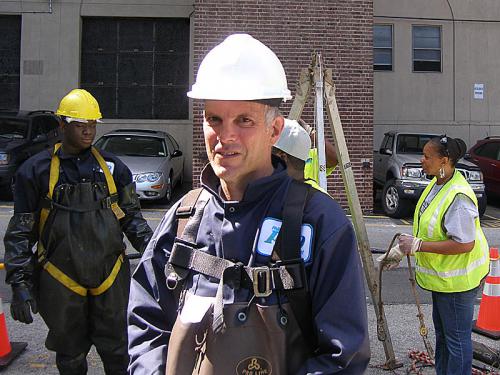
For the past ten years, the Morris Arboretum has sponsored a mini-bus tour of the sewers of Philadelphia conducted by Adam Levine. In spite of its name, it attracts a pretty high-brow audience, who have a perfectly wonderful experience. Adam has been a consultant to the Water Department for decades, and he gives a pretty polished tour, which anyone interested in the City really ought to join some year. He's planning to write a book about it, someday, and instead of giving away all the best stories, I bet it will swell attendance at the tours considerably. Some of us know that writing books can be pretty hard work, however, while giving tours seems like a lot of fun.

When William Penn picked out this area for his new city, there were herds of swans swimming in the Delaware River around the mouth of the Schuylkill, and there were wide mud flats thrown up around what we call the airport, by the slowed waters making a big turn there. Although Mr. Penn originally planned to settle at what we now call Chester, apparently he thought the protected river above the mud flats would be a safer harbor. In the area of Philadelphia County in Penn's time, there were about three hundred miles of creeks, now reduced to about one hundred by the Water Department and the Department of Streets. Dock Creek was the main seaport at first, and it eventually became Dock Street by putting the creek into a culvert. In a sense, that is what has been happening for three hundred years, all over town. At first, the creeks supplied drinking water, and then they became sewers, and then they became streets on top of sewers.
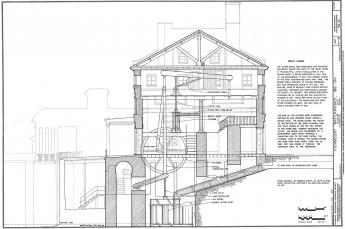
As a matter of fact, there were further steps in the process. The railroads were laid on the banks of creeks, to reduce the amount of excavation and fill-in required. And as factories were built along the creeks to take advantage of the transportation and water power, the run-off of sewage was mixed with ground-water runoff, in what is delicately spoken of as a "combined sewer". The water department spends most of its time and money nowadays, separating rainwater sewage from the real thing, and diverting the rainwater into ponds and other catchment hollows, where the relatively clean water percolates through the soil and cleans itself up. The real sewage is diverted into massive pipe systems leading to the sewage disposal plants. Where, would you believe it, it gets cleaned and chlorinated and returns as drinking water -- purer than the river water that flows past, by a good bit.
But that gets ahead of the story somewhat. As the factory areas become liveable, the sewers encased in the pipe are at the bottom, the rail lines are somewhat higher. Where there were no railways, the electrical and water pipes are high above it all and often get encased in concrete. However, we can expect combined sewers to last a long time, since it is estimated that the project of uncombining two-thirds of the sewer system will cost several billion dollars, and require twenty-five years to complete. The infrastructure money from the "Stimulus package" will be a forgotten episode of the past when this project is finished. Philadelphia likes straight streets aligned in grids, so you can almost be certain you are over a creek bed when the road gets crooked in Philadelphia.

Now, look at the grid of streets from the point of view of a Water Department engineer. Somebody gave the process the name of a waffle, and it is very apt. As the straight streets go as straight as they can, they cut through hills and fill up the gullies. The fill from the hills is used for the valleys, so the straight grid streets are generally somewhat higher than the residential areas, giving the waffle effect, but leaving half of the houses with a sharp embankment in their lawns going down to street level, and the other half of the houses with water in their basements. It's up to the house builder to fill up the depression between the streets, with the streets nevertheless somewhat higher than the depressions. Sometimes the streams cut through, and are encased in pipes as they go under the streets. Sometimes it's just too much to handle, and we get green parks scattered around the city, breaking up the monotony of row houses, for a generally pleasing effect not seen in flat areas, like New Jersey.
The city has two watersheds, one draining into the Delaware River, and the other draining into the Schuylkill. And the trail between the two watersheds, the continental divide if you please, is Germantown Avenue.
Psychiatry: Last Cow in Philadelphia
The present problem with PSYCHIATRY can be summarized as follows: At the suggestion of the American Hospital Association, Congress introduced the DRG system of paying for inpatients by diagnosis, rather than itemized services. It worked well except for psychiatry, where the diagnosis usually implies little relation to the later costs it generates, so an exception was made. The dual system of payment created loopholes which unfortunately overpaid psychiatric hospitals and were described as exploitation. Congress over-reacted in a way that was unsustainable, and essentially all of the psychiatric hospitals of the nation were forced to close. This is not a history for anyone to be proud of, and the lack of outcry is also a disappointment. However, after twenty years without reform, evidently, nothing is going to be done without an outcry.CONVENE BLUE RIBBON COMMISSION TO REPAIR PSYCHIATRIC INPATIENT CARE. The 1983 BRA switched hospital inpatient reimbursement to payment by diagnosis (DRG). Abuse of the psychiatric exclusion then led to "corrective" legislation which has essentially reduced American's psychiatric inpatient care to an underfunded national disappointment. The problem is not an easy one, so a commission should devise a workable methodology for psychiatric hospitals, relying neither on present approaches nor on DRG. But overpayment is a better outcome than no care at all. Homeless people sleeping in cardboard boxes on downtown steam grates are the consequence any visitor to the area can observe at night after the commuters go home. Psychiatric social workers readily recognize their daytime patients in the boxes.
* * * * *
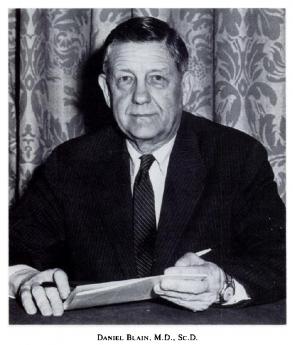
|
| Daniel Blain, M.D. |
Daniel Blain, M.D. (1898-1981) was just about the most important psychiatrist in America. He was the Physician in Chief of the Institute of the Pennsylvania Hospital at 49th and Market, the first and in many ways the most prestigious psychiatric hospital before it was closed. Before that, he was the first Medical Director of the American Psychiatric Association, itself the first (1844) medical society in America. His fame rested on organizing the disorganized psychiatry of the Veteran's Administration into a chain of advanced "Dean's Hospitals", a huge and very important achievement. Before that, he had achieved considerable fame as the man who took the dilapidated State Psychiatric Hospitals with a reputation as "snake pits" and made them a respectable part of the medical community. And before that, he had been born in China as the son of missionaries. As a matter of fact, even before that, he was a descendant of General Mercer of Revolutionary War fame.
Dan was an outstanding example of the peculiar fact that Psychiatry was dominated by social upper crust psychiatrists in Philadelphia for a very long time. In fact, Benjamin Rush of the 8th Street branch of the Pennsylvania Hospital is known in some circles as the "Father of Psychiatry", while in other circles he is known for signing the Declaration of Independence. That isn't true in other cities, and it definitely isn't true in New York City, where the psychoanalytic school of Sigmund Freud took that city by storm, and essentially drove every other school of psychiatric thought out of town, out of medical schools, out of psychiatric hospitals. The famous sixteen-year psychoanalysis of Woody Allen is an example of the extremes of that fad. Every profession has petty civil wars of that sort, best left undiscussed in public. But in the case of psychiatry, it was indirectly a material contributor to the present disappearance of inpatient psychiatry, and the related appearance of lots of homeless people on steam grates. Let me give a biased view of what is a massive human tragedy, which someone else can "rectify" if he chooses.
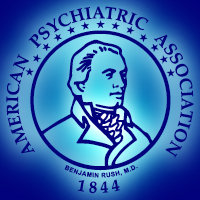
|
| APA |
It starts with a Budget Reconciliation Act of the 1980s, which brought us the DRG (Diagnosis-related) system of paying for hospitalized patients. The idea was that appendicitis resulted in essentially 7 days in the hospital, give or take a couple of days, and the bills for admission for appendectomy were for more or less the same amount. If you had fifty or a hundred cases a year in your hospital, the high bills balanced the low bills, and the overall hospital reimbursement was essentially the same without itemizing the bandages and whatnot. Congress bought this package, and after it got going, just about all hospital bills were reimbursed at one of three hundred prices, the cost to the government was the same, and there was a whole lot less bookkeeping and accounting cost. It was a success, except for a few cases where the costs did not closely line up with the diagnosis, and psychiatric hospitals were where they concentrated. So, psychiatric hospitals were excluded, and psychiatric bills skyrocketed. This experience has been carelessly cited as an example of the evils of payment by service ("fee for service"), when in fact the duration of psychiatric hospitalization is related to features of the condition, like danger of suicide, rather than the diagnosis itself. Psychiatric leadership at the time contained many in a subset of physicians who did not think much of inpatient psychiatry in the first place and even less of lobbying, and they underestimated the severity of the assault on the specialty. Apparently, no workable formula for pricing inpatient psychiatry has since been brought forward to be approved by a Congress which is more accustomed to getting its lobbying in the form of one-liners. And would you believe it, psychiatric inpatient care soon disappeared.
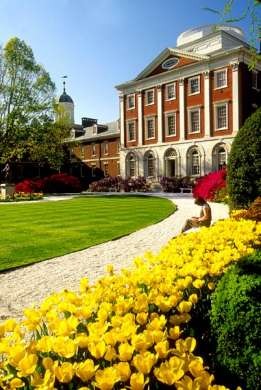
|
| Pennsylvania Hospital |
That's right, if someone in your family needs psychiatric hospitalization, I wouldn't know where to tell them to get it -- at any price. From considerably overpaying for psychiatry inpatients to paying scarcely anything for them, this little change of the regulations caused every psychiatric hospital I know of by name, to close. It helped balance some state budgets, but it also was a considerable factor in filling the steam grates of American cities with people who sleep on cardboard boxes. And what it illustrates is that this is what political society always seemed to do, before Dan Blain and a small group of upper-crust psychiatrists were temporarily able to shame them into something better. In fact, if there is any tattered remnant of good inpatient psychiatric care left in America today, it is in the Veterans Hospitals that Dan was able to straighten out.
Dan Blain will probably eventually be bypassed as a curiosity, like his wife. She was a Wister Logan Blain, descended from families who ruled Philadelphia a hundred years before even General Mercer came along. So the Blain couple lived on an enormous farm plot, centered at 20th and Olney right next to LaSalle University, which is built on their property. It also contains the Peale House, where Charles Willson Peale lived as the elected president of the rebel faction of the American Revolution. Peale didn't know what he was supposed to do, so he resigned and painted portraits of people. The Blains enjoyed keeping a cow on their land, the last cow in Philadelphia, and the LaSalle students enjoyed stealing the cow and leaving it on the top floor of a dormitory, for laughs. Meanwhile, the Blain couple had cocktail parties on their front porch for visiting dignitaries. They usually wore blue jeans, and Mrs. Blain, the absolute Queen of Philadelphia society, was occasionally observed to pour vodka into her glass of beer. That sort of background may well have been useful when psychiatry needed to be built up and humanized, but it became a liability when the rest of inpatient psychiatry failed to appreciate what was knocking on its door.
Dept. Defense vs. Dept. State
My youngest son is scheduled to be sent to Kabul in December, and his family is pretty worried about it. I start off by saying this, just to show I understand both sides of the following problem.

|
| Colonel Frank Gunter |
Colonel Frank Gunter, formerly of the U.S. Marines was at the Right Angle Club, telling us about the complexities of Iraq, where he spent 25 months. It was very interesting and somewhat hair-raising. The Colonel joined the Marines as a private and worked his way up, accumulating a couple of Bronze Stars, so you know he is no sissy. Right now, he is teaching economics at Lehigh, so you know he is pretty smart, too. As would easily be imagined, he sees the consequences of shale gas in Pennsylvania through the funnel of having a major impact on a nation which is heavily dependent on oil exports. He has seen the effects of the "Dutch disease" up front and friendly. I would have said the Dutch Disease was a phenomenon of discovering oil (or diamonds, or whatever) and finding everybody drops tools to be part of the oil rush, with the result that a one-industry country is easily taken over by a dictator who gets control of the oil. Our Lehigh professor makes it a little more complicated, saying the oil discovery pushes the value of the local currency sky-high so that all other export industries are unable to survive the higher prices they have to charge. But it amounts to the same thing: a gold rush can be a bad thing for a small country, even though you might not think so at first. So, similar effects can be expected to play out in Central Pennsylvania, except for the existence of a large national currency and the buffering effect of many other diversified industries nearby.
In some ways, the most interesting discussion took place after the Colonel left. One of our members who had spent years in Foreign Service remarked that considerable friction between the Department of Defense and the Department of State was unintentionally caused by a difference in personnel policy. When the Marines order you to go into harm's way, you go. The State Department, on the other hand, permits an employee to decline a reassignment. Unfortunately, that led to a considerable manpower shortage in the State Department effort to win the "hearts and minds" of the Iraqis, which the Armed Forces had to fill without adequate training. And in any event, in the Marines, you don't often get promoted for civilian work when there is a shooting war going on. As the casualties started to come it, this became a serious source of friction and probably underperformance in the mission. Gradually, we learned. Nowadays, things are closer to "Those who refuse an assignment, must then resign from the Department."
The Accounting of Natural Capital

|
| Libby_Bernick |
Libby Beineck, the vice president of a British firm called Trucost, recently visited the Right Angle Club to explain how corporate accounting might be changed to adjust for any external costs to the environment. She is of Quaker ancestry, descended from Samuel Rhoads, the architect of the Pennsylvania Hospital, so the group was immediately congenial. Her company presently values the environment as having a capital value of $7.3 trillion and helps companies calculate how they are adding to, or subtracting from, the world's natural capital.
The club responded well to her message, proceeding to ask a number of friendly questions, a process which accelerated as the questions received thoughtful answers. We are, indeed, using up our heritage of environmental capital, and have led the developing world to imitate us. The thought has to occur that perhaps this sort of consumption is a stage of development, inevitably followed by a strong movement to reverse the damage. They used to keep the streetlights of Pittsburgh lit during the daytime, washed their curtains every week, and never painted a house white if they knew what was good for them. But all this was reversed in just a few years when Richard King Mellon decided he was tired of it and made it stop. Unfortunately, the net capital value of Pittsburgh has probably declined further, because people valued the steel industry less than the environment.
One member of the audience took a far longer view. It was probably Isaac Newton who declared that matter is neither created nor destroyed, it only changes its form. What we refer to as the natural environment was caused by volcanic eruptions and the impact of asteroids. Ultimately, the environment only lasts for the duration of the interval between meteorites and volcanos, and predicting the total dissolution of the environment by the next shift of tectonic plates, is anybody's guess. Ultimately, we are at the mercy of the extrapolation fallacy in all of this. We dare not predict that the next asteroid will hit us after the last one, with the same interval between them. We dare not predict that cheap oil will run out at present rates, or that shale gas will take its place in a completely fortuitous way. If you look at the ocean, there seems to be plenty of water needs have its salt removed, plenty of sunlight from the sun for eons to come, plenty of energy fused into the molecules of the earth. What you can't extrapolate very well at all, is how fast our scientists will find a way to release this limitless supply of energy so we can use it. Some people have more faith in our scientists than others do, so it seems best to conserve what we have. Or rather, to use it up as slowly as we can.
A Doctor's Toast to His Patients

|
| Weir Mitchell |
A Toast to Them All
One the "Four Horsemen" of Johns Hopkins, it may have been Halstead, once remarked on the great debt Gynecology owed to the Baltimore negro woman. In a similar vein, Weir Mitchell might have noted the debt owed by Neurology to the wounded Civil War soldier.
But I would go beyond that, to give expression to the gratitude of the whole medical profession to its sick patients. They willingly pull back the curtain on their darkest secret, in the hope their Doctor may find some use for it.
A toast to them all.
Hadoop and Big Data in Medicine
.jpg)
|
| Lord Maynard Keynes |
A software program for lashing fifty thousand computers together, called Hadoop, is what gave macroeconomics, the study of huge populations, its big push. The aristocratic Maynard Keynes, who invented macroeconomics, would probably not be amused on looking up Hadoop on any search engine, to find it is possible to download it free of charge to anyone who asks. Fifty thousand computers? Anyone can also rent eight hours of time on them from IBM or Amazon, for about ten dollars. Not many great scientific discoveries have become widely available so quickly or so cheaply.
Although the news media will probably concentrate on locating spies in Central Asia, or predicting the outcome of national elections, or telling which dot in the sky is really an approaching asteroid, Hadoop will certainly make it easier to make advance predictions in health insurance. Creating 300 million individual policies is do-able, projections of the gross domestic product are much easier, more accurate and can extend farther into the future. Ideas of preserving privacy in this avalanche are simply swept away by the discovery that much of what we thought was privacy was just a matter of being lost in a forest of data. So let us momentarily feel safe in predicting that a system of individually owned health insurance is entirely practical, cradle to grave, or at least need not be rejected as impractical because of size. If the Federal Reserve can manage a portfolio of $3 trillion, a national piggy bank for health care costs is not beyond our ability to manage. Set aside for a moment whether it is desirable to do such a thing, it is definitely possible to do it. Since small-scale tests seem to show potential savings in American healthcare costs in the range of 5% of annual American GDP, development costs need not stop us. Although the plans of Obamacare could bankrupt the nation, it is also a possibility that what is truly wrong with them is the thinking is too small. Bad implementation is expensive, failure to abort a failing program is worse. But getting the wrong design for the program is fatal.
The general process for getting things right in politics is to do something, and see if something bad happens. If not, do even more of it. But if your monitor shows that something bad is really happening, drop the project. Big Data, the process of monitoring huge amounts of data simultaneously, using Hadoop and fifty thousand computers in the desert, could be a monitor for experimental changes in the health insurance system. The trick is to include automatic monitoring alarms as enormous volumes of data flow past. The incentive for alertness is this data will be there anyway, and somebody in the role of trial attorney can go back in retrospect and show you missed a trend. Presumably, the outcomes to measure are whether health is improving, and costs are going down. Compared with past trends, and other nations. Doing localized experiments, by states perhaps, would allow you to compare that state with others. It's rather like politicians giving speeches, and then watching what happens to their popularity polls. But it can be like counting the number of grains of sand on the beach -- who cares?
When any innovation is this new, powerful and cheap, it is almost impossible to slow the stampede to try it out. Almost anything which can be imagined will be tried out, and a few surprising things will be discovered quickly. But then it can be predicted that things will settle down to using this big machine on statistical issues which were formerly just beyond its reach, leaving acceptance of Hadoop computing to find its niche. Genomics comes readily to mind in medicine. But already a quite different sort of use has appeared in statistics. Statisticians have built up a whole structure around the estimation of large numbers by careful examination of small samples. The science of such approaches is the science of carefully selecting representative samples of a predetermined size, measuring their contents, and then extrapolating the size and composition of the original. Quite often, more time and expense was devoted to assuring the representativeness of the sample, than was spent extrapolating the answer.
Almost overnight, that whole approach has been swept away. With fifty thousand computers, it is easier just to count the whole thing than to bother with samples. The interesting thing for medicine will be the immediate reconsideration of subsets. When a study is conducted, let's say to see if a drug helps high blood pressure, a lot of data is collected. Regardless of whether the drug helped high blood pressure or not, it is possible to see if it helps the blood pressure of Hispanics, or of Chinese, or young women, or old men, or people with diabetes, or, well, you get the idea. In statistics, it is assumed something is true if there is a 95% chance it is true. But 5% of the time, or one time in twenty, it just happened that way by coincidence. So, if you go on splitting the data into a hundred pieces, it will appear to be true in five of them, when it was really only due to chance, and maybe wasn't true in any of them. That error, which is very common, is eliminated by measuring the whole experimental group instead of taking samples and extrapolating from them. So, the long and the short of it is a whole profession of sample analyzers is now out of a job, while the amount of false information is greatly reduced. Now, we can start to see the power of Hadoop emerging, although it is too soon to say what it will be used for.
Spending Accounts into Savings Accounts for Retirement? Don't Count On It.

|
| Flexible Spending Accounts |
For many years, Health Spending Accounts (now called Flexible Spending Accounts) were confused with Health Savings Accounts. In the previous section, we have just proposed the $500 annual roll-over be made permanent. Naturally, that raises the question of whether a permanent rolled-over account could be made into a supplementary retirement account, but unfortunately, the mathematics of that is not nearly so good. Let's consider the most favorable case. As stated, that would be a $500 annual contribution, starting at age 18, paying 10% income return. That would generate a retirement fund at age 65 worth $436,000. That sounds pretty attractive until you start picking it apart.
In the first place, most people can't start work at age 18 and expect to be continuously employed until 65. There will be periods of unemployment for most people. In the second place, money invested in large-cap common stock will indeed return 10% over a long period of time, but there may well be gaps and periods of catch-up. And if you are not careful, you won't get 10%, even though your money is earning it. The experience with 401(k) accounts has been the financial industry will likely reduce your returns by roughly 2% with an internal assessment called 12b(1), allegedly a reimbursement for sales promotion, but really just 2% for themselves. So, you are down to 8% before you encounter $250 charges per transaction. Some brokers only charge $5.00 for purchase, and some banks charge nothing to give you your own money back. Very likely, the $250 purchase charge will disappear before the $250 withdrawal fee does because the withdrawal fee is harder to spot on the receipts. John Bogle recently remarked on television that the financial industry takes 85% of the returns on retail investments before it gives anything back to the consumer, which seems to include rather more than an 8.5% gross margin, so there's probably more fee here than I can account for, which is about half of that. To be conservative, let's say your original return of 10% has been reduced to 5%. So, the expected retirement fund for our hypothetical wage-earner is not $436,000, but $89,000.
Even that haircut is more than our hypothetical is likely to get. With Medicare as a backup, paying for healthcare has been protected during its most expensive period. Retirement, on the other hand, is usually more costly in a retiree's sixties than his eighties. So, while $89,000 might well cover health costs in old age, it will probably fall short of covering retirement. For instance, the average Medicare recipient costs Medicare $11,000 a year. How many retirees do you know who can live on $11,000 a year? We're going to have to leave it at that. By stretching and luck, by arm-wrestling the investment community and counting on continuous employment for forty years, we might scrape together a plan that would cover healthcare as we hope it will cost when we get there. But retirement? My warning is that I don't see how it can be managed, except for one strategy. People are going to have to work longer and retire later. To make ends meet on retirement, the emphasis must shift from demanding retirement as an entitlement -- to demanding our employers themselves get to work, providing more of the jobs old folks can perform, in spite of infirmities. We've got to build houses cheaper to repair, and cars cheaper to drive. We've got to live in houses with elevators and wear clothes that moths won't eat. But squeezing it out of investment accounts? After we've wrung it dry, paying for healthcare, I doubt there will be much left.
Looming Early Issues in Obamacare
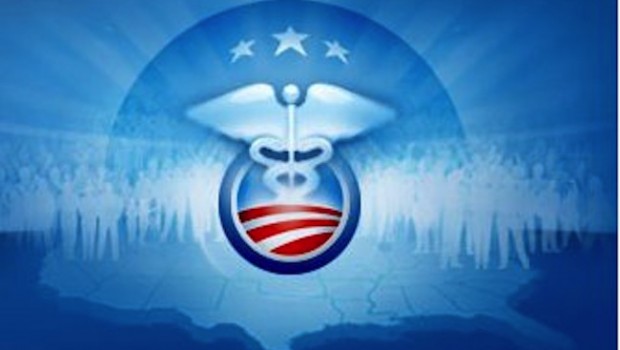
|
| Obama Care |
The Attitude of Big Business. In order to preserve maximum flexibility as long as possible, many important features of the Affordable Care Act (Obamacare) remain unrevealed, and some are perhaps still unsettled. Furthermore, attitudes change with experience. At the formation of the Obamacare idea, the leaders of big business (at the time) were more concerned about foreign competitors than about employee attitudes. The traditional goal of a "level playing field" led them to favor an employer mandate to provide employee healthcare. It probably was presented to them that they could only have their desires by agreeing to a universal individual mandate for everybody. Although it was uncertain whether the employees would agree, universal was the price to be paid, and they paid it. Whether new leadership supports this compromise or not, it is generally assumed that big business feels obliged to support Pete Stark's universal mandate until it is tested. Only time will tell whether businesses will withdraw their support in the face of events, but fragile beginnings certainly do not assure permanent support. Since it was the withdrawal of this group's support which destroyed the Clinton plan in 1994, a significant issue hangs in the balance. Therefore, when conflicts were discovered with the ERISA laws under which big business works, the inclusion of big businesses in the framework of the Affordable Care Act was postponed for a year. How it will emerge next year or whether the ACA can survive for a year without major business inclusion, both remain to be seen.
The Rising Voice of the Uninsured. A financial recession usually increases the number of health uninsured, but at present unemployment is slowly falling. However, decades of scientific medical advances are not only extending longevity but reducing non-fatal illness among the young and uninsured. Although it is unclear whether youthful perceptions match the actual changes in their morbidity, young healthy people who rebel at paying health insurance premiums may actually increase in number substantially during the coming decade. Although overall inflation has been moderate, discomfort from competing costs of college debts and items such as gasoline have escalated. When the Affordable Care Act is fully implemented, youthful perception may make the first serious test of its usefulness. Those among them who actually get sick may get an opportunity to sample Medicaid and report their experiences to their friends. To some extent, this will be a race between efforts to improve Medicaid in order to forestall complaints, and the tendency of young people to try to get their way by pounding the table with their shoe. If successfully managed, it could promote some badly needed improvements in Medicaid. Handled poorly, however, it could bring the program down.
Cost of the Program. The fact must be squarely faced that insurance almost always increases costs. That is true of all casualty insurance, whether auto, homeowners, or maritime. Correctly applied, it can indeed redistribute costs, but insurance imposes extra administrative expenses, and it produces "moral hazard", so total costs are increased by insurance. Moral hazard is a term of art, signifying that nobody spends someone else's money as carefully as his own. Actuaries calculate the extra cost imposed by present American forms of health insurance to be at least 30% of the total service, and arguments can be made it will be so much more, that level historical costs cannot conceal the appreciably higher premium level. Longevity is improved by reducing the number of brushes with life-threatening illnesses in a lifetime; costs go up because prices go up.
Universal coverage now introduces its own uniquely unwelcome issue, that eliminating non-insurance market benchmarks for medical prices also eliminates the cost guidance they formerly provided. Crippled though it may have been, the partial cash market did set benchmarks, if not prices, which insurers then had to match -- and those benchmarks will possibly soon be seriously diminished. That development will be welcome to those who wish to receive higher prices, but cause dismay among those who have to pay for them. The result is predicted to lead to price controls, which will, in turn, provoke shortages, possibly demonstrations or worse. Matters may not follow that path, but it is hard to see why not. As to any reduced overhead like marketing costs, employer-basing has already reduced them to a small opportunity for streamlining. In the past, a resort to price controls has almost invariably led to shortages. Even in 2013, there have been shortages of cancer drugs, an almost unheard-of event in the past century.
To put it mildly, rationed healthcare is politically disadvantageous for those who attempt to enforce it. The most conservative projections now suggest that Obamacare will increase healthcare costs by 22%. Since the following proposals would by contrast almost surely reduce costs by a conservative 30%, it is not impertinent to suggest that no matter remains closed while a 50% overall cost swing remains credible. That would be particularly true when it concerns 17% of gross domestic product (GDP) during a recession. In fact, no one has even contemplated what it would mean to inject 5% of American GDP back into the world economy, especially by the mechanism of releasing a paralyzed medical system.

|
| Patient Participation |
Patient Participation in Claims Costs, Generally Speaking. For the insurance industry, this is an old story. Industry survival has depended on success in answering it effectively. In health insurance, the traditional approaches have mainly been 20% co-pay and about $500 annual deductible. The first means 20% of all benefits cost, the second means the first $500 of benefit costs in a year. These figures evolved out of countless negotiations between labor and management, or within legislatures, are now accepted as traditional, and are accepted by the public. These figures also represent how much each side thinks it can afford since they see themselves as ultimately paying the bill. Until recently, however, patient participation at such small levels has not reached a point where it significantly influences patient behavior, which is set by entirely different forces and is now the main long-term cause of healthcare cost inflation. As mentioned above, business negotiators seldom pay much heed to imposed costs, just so long as their major competitors must pay the same costs; in fact, that is one of the flaws in our corporate system. However, governments as third-party payers enjoy no such luxury, and most of the complaining about healthcare cost inflation has originated with governments. Consequently, businesses not infrequently drag governments to higher cost levels, and this must be recognized as a reality of entitlement programs. Furthermore, attempts at raising patient cash contributions have always had political rather than economic origins, usually loudly characterizing any cost constraints at all as crippling the intent of insurance, making false promises, and depriving the poor of humane treatment. If patient contribution ever reaches 50% of costs, the program will likely be called a failure (Insurance exchanges please take note.).
However, it would appear incentives cannot affect overall patient behavior very much until patient payments to reach a much higher point, and we may well see some experiments to test what that level may be. (As it is argued here, this dilemma need not be completely dispositive.) More recently, steadily rising healthcare costs have actually led to employer increases in co-pays and deductibles, and the Obama administration has been giving signs of yielding to the behavior modification argument. However, these approaches cannot be called a success until they seriously reduce long-term healthcare cost inflation, and that remains a doubtful outcome.
In fact, no desperately sick patient should ever be expected to pay much attention to costs. The restraint of partial cash payment should be reserved for lesser conditions, and even provider discipline should be reserved for what are provably individual provider decisions, whether at the institutional level or the professional one. There are certainly broad areas where no patient cost restraint whatever can be justified, and program design should recognize that premise. Nevertheless, much more could be done with patient participation in costs than is done at present.
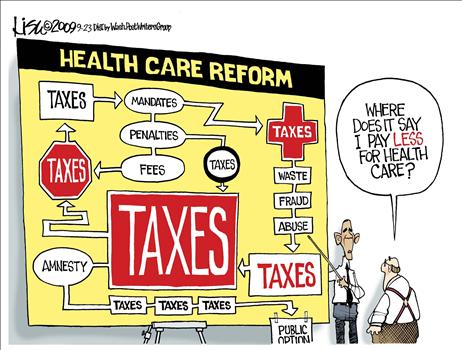
|
| Cost Restraint |
Targets for Cost Restraint Requiring Two Distinctive Approaches. There are two factors in overall medical costs: the item price, and item volume. Above a certain level of sickness severity, only item prices can be legitimately constrained, not the volume of service. Before any of that happens, of course, all published prices should be audited and forced to conform to standard cost-to-price ratios, because cost-shifted indirect costs are so prevalent. For minor conditions and illnesses, volume control on the patient remains legitimate, particularly for conditions where patients are usually responsible for inciting them. Patient cost-sharing is, therefore, a legitimate out-patient approach. Officials given the right to set such boundaries will almost surely be assailed as having a conflict of interest, or untrained for the decisions; it is an unpleasant role, attractive only to unpleasant people.
The healthcare market segments itself into two quite different approaches and successful administration consists of accurately distinguishing the two. As soon as the patient enters a hospital, his control of cost creation is taken away along with his clothes. Therefore, payment by diagnosis is a sensible approach for inpatients and could be even more effective if the diagnosis codes were revised to include greater stratification by the additional use of laboratory and other billing sources as confirmatory evidence. An argument can be made that fee for service to a helpless patient operates without cost resistance. But having removed incentives for abuse, the laboratory data becomes even stronger evidence of underlying diagnostic distinctions. Since Obamacare has apparently not fully examined such distinctions, there remains hope it can be persuaded to see the codes need expansion. At present, DRG codes are very crude and rely heavily on errors on the high side canceling out errors on the low side. Furthermore, they are derived from (ICD), the International Classification of Disease, which identifies individual diseases only if they are common, responding to the needs of medical records librarians who complained that usage did not justify the effort of coding every case. This combination of short cuts and errors is too crude for the advanced use now planned for them and would benefit from substituting the coding system called SNOMED3. A case can be made for both lumping and splitting; perhaps two codes are required, a crude one derived by computer-lumping precise ones of the same average cost -- rather than by similar etiology. As matters now stand, teaching hospitals have no way to assert a need for greater reimbursement for greater case complexity, specialty hospitals are able to select inexpensive cases within expensive categories, and rural hospitals are left without satellite cash cows.
However, this is tinkering around the edges of volume measurement. Much greater savings are immediately possible from attention to prices, through billing for direct and indirect costs separately, recognizing indirect costs as the present main locus of cost-shifting. Some serious thought should be given to the growing shift of profitability to the outpatient area, with inpatient care transformed into a loss-leader. As that is increasingly true, it becomes wiser to shift attention to the prices of outpatient and emergency room services. Going all the way to Health Savings Accounts would be ideal because it enlists patient incentives to the side of prices restraint. HSA also comes inherently segmented, between outpatient and inpatient hospital. Beyond segmenting price and utilization controls, however, consideration should also be given to segmenting health insurance itself, to match natural cost segmentations. Prison inmates, persons mentally impaired, and illegal immigrants account for nearly 30 million persons, and require specific ministrations, not patchwork exceptions to what the rest of the population requires.
Critical Number for Retirement Planning

|
| Retirement Plan |
There is scarcely any need to list the uncertainties of planning for retirement. To make a precise number, you would have to know how long you expect to live, how much you need to spend, how much cash flow is assured, how much your stock portfolio will be worth, what the rate of inflation will be, and so forth, and so forth. When you get done listing all the things you have to know, the general tendency is to assume the task is impossible. It's hard, but it isn't impossible if you know a single number: the average growth rate you need to achieve, if you are going to be in exactly the same financial position on your 100th birthday, as you are today. In my own case, the answer is 1.5%. I have arranged my own affairs in such a way that if my stock portfolio maintains a 1.5% growth rate until I reach my 100th birthday, it should be worth the same as it is today, on that happy occasion in the future. So, having the magic number of 1.5%, let's work with it. By the way, that's net, net -- net of inflation , net of taxes.
Inflation is supposed to be targeted by the Federal Reserve at 2% per year. It wouldn't be wise to count on that, but taken at face value, I can still break even if the nominal portfolio growth rate averages 3.5%, a conservative figure net of taxes. Remember however, you have to pay taxes on any taxable investment expenses. If you sell appreciated stock to have cash for portfolio re-balancing, you probably must pay capital gains taxes, if you take a lot of dividend income you will have to pay standard income taxes on it, if you get a new investment advisor who charges a lot you will probably have to pay him extra for his alleged expertise. In other words, if you get careless in your investment choices, you could find it will require an increased average growth rate, possibly one that is impossible to achieve. But that's your problem, which in my case is 1.5% plus actual inflation, plus investment carelessness about advisors and taxes. Or personal carelessness about housing costs, travel, fancy automobiles, or fancy friends. it means I could achieve a more likely growth rate of 4.5% a year, keep it up until I'm a hundred, and still be approximately where I am today. It seems achievable.
In fact, as you grow older it is less important to preserve every bit of your assets for the inheritance tax bite on the day you happen to die; particularly since inheritance taxes can go as high as 50%, and you can tell yourself you are spending fifty-cent dollars. Estate tax issues are not today's topic, however. For retirement planning, you could take the ancient advice to "spend your last dollar on the day you die." To entertain this illusion for a moment, you can see how much extra you could afford to spend, by dividing your assets by your life expectancy. You can consider that your safety net, but many people would have to consider it a reality, so this is the rough calculation. If you can't afford to retire on that amount, you probably can't afford to retire. This last calculation gets pretty inaccurate unless you are within five, or at most ten, years of retirement.
So all you need for scaring yourself, or sinking back into complacency, is to calculate that growth factor. Please remember the assumptions you made, in compiling it. Essentially, you total up a year's expenses and a year's income; and subtract to determine how much you are saving, or drawing down your reserves. It seems best to list all of the expenses and income on scratch paper, since at first you will want to go over the whole list to see if the year you picked was truly representative. The first step is to purify the list of one-time or odd-ball expenses and income. The second step is to pick out the expenses which are truly frivolous, which you would quickly eliminate in an emergency of some sort; what are the core expenses, what is truly frivolous, and what is desirable but expendable in a pinch. On the income side, there are pensions and annuities which assure you of cash flow, no matter what. There may be a job you plan to quit, or a pension which won't start for a few years. These are the tools you can use, but the main thing is to get that number, the amount could easily be saving, or the amount you must draw down your assets. Notice that we are essentially ignoring how much your assets happen to be, disregarding whether they happen to be a lucky high number, or an ominously small one. Your goal is to see how much you are either adding to them or subtracting from them; the purpose is to try to project where that will go in the future. In addition, you might also project the gain in your portfolio, but it would require several years to be certain about that, and for now we can get along without it.
Now, project that net gain (or loss) to your hundredth birthday. You may live longer than that, but it isn't likely; and you might live less than that, but you won't care if there is money left over for your estate. You might use a computer program to do it, but computers work by a process of "iteration", which means doing the same calculation, over and over again. For this simple purpose, it will suffice to do it with a pencil and paper, because the chances are good that you can project some future events which will interrupt the smooth flow of estimating one year's income from investment, and adding it to the running total. You soon get to 100, even using the crudest arithmetic, and you soon arrive at the net annual gain or loss in your portfolio at age 100, assuming the present rate of growth. If you do this for a few years, your projection will get more and more precise. You now take this number and re-calculate it with a differing growth rate of the portfolio. Start with 6%, and calculate up and down, 8%, then 4%, then 10%, then 2%, then 12%, etc. You vary the growth rate in a systematic way, and watch to see what growth rate of your portfolio will leave you at age 100, with exactly what you have, today. That's the magic number you want to get, the gross break-even growth rate. If it's a positive number, it tells you what growth you have to achieve in your portfolio, and if it's a negative number, it tells you how much you could afford to squander, you lucky person, over and above your present standard of living.
But now you have to see what could upset your applecart, like inflation. Our Federal Reserve has an announced target of 2% inflation, per year. If that happens, which I rather doubt, I need to add 2% to my 1.5%, getting a "real" target of 3.5% growth in my portfolio per year. That's an approximation of how much my portfolio has to grow, just to stay where it is. In my opinion it's achievable, but events may prove otherwise. Investments which promise less than 3.5% are for me not likely to seem safe, they are losers. Investments which pay more than 3.5% are likely to generate funds I cannot live to spend, so they will only generate inheritance costs approaching 50%. So in that happy case, I could consider giving some away, to my heirs, or charities, or whatnot. On the other hand, some young fellow who is projected to need a portfolio growth of 20%, had better consider getting an extra job, or cutting down his expenses--because the history of investments shows that 20% is either totally unachievable, or else involves so much risk that you better not gamble on it.
There's one other thing you can do if you are old, or sick. You can divide what you have by the number of years in your life expectancy, and spend it down. The goal is to spend the last dollar on the last day of your life. I hope everyone understands how unlikely you are to pull that stunt off, but sometimes it has to be considered. Somewhat more realistic is to adjust your life expectancy in this calculation, from 100 down to whatever age seems more likely. And maybe you have to reduce your lifestyle. Otherwise, your best salvation is not from an investment advisor, but from a social worker.
Try it out. Estimate your required net portfolio growth rate, and then add in "what if". What if the stock market collapses, what if inflation goes to 25%, what if social security gets reduced or increased, what if you suddenly acquire a new dependent. The older you are, and the longer you accumulate your own personal financial data, the more accurate the calculation will be. But at any age and in almost any financial circumstances, fixing your attention on that single number will be a North Star, to navigate by.
Higher-cost Health Insurance is What's Mandatory
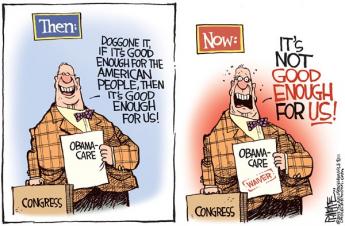
|
| Obamacare |
Millions of people were unexpectedly canceled by health insurers at the onset of the Obama Insurance Exchanges. The President repeatedly told the public under Obamacare they could keep their old plans if they wished, even after notices to the contrary were mailed out. Insurance spokesmen firmly responded that the terms of the law required they could not keep the old plans for a single day. This promise was reinforced by the original section 1251 but later amended in confusing ways. The public had been told nothing like that during a three-year opportunity to be open about it; in their view, it was sprung on them. Maybe they had even been lied to; more likely, someone objected, causing revision that could be interpreted in several ways. In any event, postponement of the large-employer plans made it moot for the customer but not for the voters. To quell the uproar, the President quickly delayed the cancellations for a year, then extended the suspension, and soon provoking alarmed announcements from the insurance industry that such insurance would lose money. It suddenly became a question whether he could make the insurance companies take them back, and some said they wouldn't, even for just one year. It all sounds like an uproar on the other side of the curtain. The irresistible conclusion emerges there is more to this arrangement than is revealed, with further surprises to be feared. After all, the old rates had been set by the insurers, so something extra must have been added by someone else, but possibly it triggered some clause in the risk corridor provisions. Long accustomed to caveat emptor from salesmen, the public will have trouble getting over the assumption that insurers had been promised more expensive products to sell, in return for doing something of value for the Obama administration we haven't yet learned about.
In a world long accustomed to government anti-trust constraints, that higher prices with less competition could be mandated by law was almost too good for insurance companies to imagine. But now, after the deal is suddenly "postponed", any other industry groups who may have negotiated secret accords, are warned of the price: they must expect to absorb some costs whenever this President is forced to abandon his side of a bargain. The National Journal recently quoted an interview with an insurance lobbyist that large amounts of insurance money helped finance Tea Party meetings, suggesting internal dissension within the industry.
In any event, the canceled policies were almost entirely individual policies in the end, and the ultimate goal is speculative. A different way of expressing the thought is, a large collection of individual policies can more easily resist pressures to cross-subsidize other favored clients. One thing is almost uniformly true of persons who hold individual (as opposed to group) policies: they pay for health coverage with after-tax dollars and therefore are out of pocket by 20-30% extra for equivalent insurance. Many of them may well resist higher-priced products for that reason. Eliminating individual policies would cost the government considerable tax money and indirectly raise premiums. There must be some other motive for animosity toward individual policies, but we will have to wait to find out what it is. It may be just as simple as reducing the visible cost gap between the old system and a new one.
The Meaning of Freedom

|
During the last campaign, when I was a candidate making an appearance at every meeting of any sort in my district, I frequently asked myself what Tea Party speakers were driving at when they spoke of "freedom". As I gazed over the crowd, I had trouble making out any ignorant red-necks, as President Obama was urging his followers to see as the enemy. They were mostly small business people, and they were at least as well educated as their opponents. I've heard Democratic partisans denounce the Tea Party as being so poorly educated they didn't even believe in Evolution. But I didn't hear a word about that, either.
As these things were going through my head, my eyes swept over the room, trying to make out what the common characteristics might be. True, there were scarcely any people who looked as though they had gone to Ivy League universities, but that is true of almost all crowds you mix with, and anyway I would say most Ivy Leaguers avoid anything having to do with politics, of any variety, on either side. But there definitely was something characteristic about Libertarian crowds. Small businessmen and women were there in abundance. Housewives and farmers were numerous. Older, more conservative people. But all of them dressed alike, which is something I attribute to everybody's clothes coming from China, no matter what their station in life. When you are in Europe, the nationalities seem to blend together for much the same reason.
And then it occurred to me. Almost all of these people worked for themselves, to some degree, or at least all of them had enough freedom to come to meetings when they please, wherever they please. Trying this idea out on some passing strangers, it seemed to resonate. One man, in particular, was vehement about not being able to stand an employment situation in an office, on a schedule, with a boss. When you talk to doctors, they generally express a wish to be solo practitioners or members of a small on-call group. That is true even if they work for a hospital or a group practice; the freedom to be an independent actor was why they went into Medicine, or Law, or started their own business. Most of them acknowledged they made less money that way, but they were willing to do so, in order to be "free". Lots of them are employed people, but that's the one feature they dislike about it.
In Democratic groups, however, many of them work for the government -- the ultimate indignity. And those who don't are happy to commute with regular hours, endure the eight hours cooped together, get home in time to release the baby sitter. But even these people prize the weekend highly. To them, it's the time they are really alive and enjoying what America is all about, wouldn't think of using that precious time at a political meeting.
So one group thinks of the weekend as their time of freedom, while the other group wants to have all of its time left to its own decision. The two groups aren't all that different, except the Libertarians act out their principles, acknowledge a somewhat lower income as an acceptable price to pay for it, and glory in the company of other like-minded Freedom fighters. There's surely more to the political differences than this, but Freedom from having a boss is definitely a big part of it.
Yard Signs
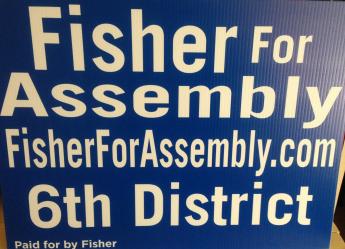
|
| Yard Signs |
For two weeks before election day, I had two "Fisher for Assembly" yard signs outside the entrance to my office, flapping back and forth in the wind. That's in the center of our little town, and the signs were stuck in the ground of what I assume is public property. If not, it is my rented property. One morning, I came to work and found they were gone. Perhaps it was Hallowe'en kids on a prank, perhaps the trash collectors swept them up. But the nice fellow with a beard who sits on a park bench next to the place, said, "No, it was some woman. She said it was against the law to put up signs in the business district, and he didn't argue with her. Nobody I asked had heard of any such law, so I have to assume she was an overzealous supporter of my opponents. In elections, this sort of partisanship has been known to get much worse than taking down an opponent's signs.
Anyway, my older daughter had been appointed campaign manager,, and she was very brisk about yard signs. Yes, indeed. Yard signs are very effective. How many do you have? The answer was five since at fifty dollars apiece, they seemed pretty pricey for what little good they did. No, no, they do a lot of good, so get fifty more immediately, and I'll help you place them. Well, that took a little pleading and arm-twisting, but the next day we had them. And, after church on Sunday (after Meeting on the First Day, as Quakers would say), we went off on a wild sign-placing ride. She drove, while I attached the wire stands to them. We were looking for signs that had been put up by other Republicans.
There are several reasons for putting your signs with those of your friends, in clusters. In the first place, this is one of the functions of a political party. There have been many previous elections, and the people who will give permission have long since been identified. The permission is only good for members of his party, however, since if you are an opponent you are likely to be confronted by ladies who say it is against the law. And the good places to put signs have long since been identified, usually at places where passing cars must slow down for a stop light. But how can anybody read your sign as they whiz by? They can't, which is why repetition is the thing. The same sign, with the same distinctive design, is finally read by someone who has seen it before but could only see the color pattern the first time. Putting a funny jingle on five successive signs was a very good idea once used extensively by Burma Shave. But it's expensive, and although everyone recognized a Burma Shave jingle, I have to admit that I never met anyone who actually used Burma Shave.
In the final outcome, I got 19,000 votes. Since I can scarcely imagine shaking 19,000 hands, that's pretty gratifying. Unfortunately, in this election, it would have been useful to have 750 more.
Minimum Wage Fangdoodle
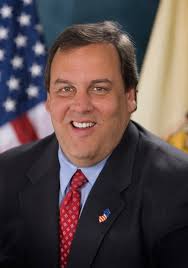
|
| Governor Chris Christie |
The November 2013 elections have been widely accepted to be a spectacular win for New Jersey Governor Chris Christie, suddenly making him a presidential front-runner for 2016. The only other significant election was a close win in the Virginia gubernatorial race for a fund-raising crony of Bill Clinton over the Attorney General who started the Supreme Court Case over Obamacare. In the view of the news media, there were only two elections in this off-year -- a landslide in New Jersey, and a dead heat in Virginia, for Governor.
Well, as a matter of fact, there was also an election in New Jersey for all of the members of the legislature, which means that I was running against the Democratic majority leader in the 6th Legislative District. I got 19,000 votes, but I needed more to win. At least in my family, it was a big event, particularly since no one else in New Jersey contributed a dime to my campaign, and while Governor Christie may have whispered a few encouraging words to me, there was no evidence of his assistance. But you can forget about that, too, because this election was really about the minimum wage.
The first inkling I got that something was up was receiving a sample ballot, three days before the election, where there was a referendum question about the minimum wage that no one had told me about, although it could scarcely have been a secret to get it on the ballot. And secondly, on election day there was scarcely any evidence of campaigning for Democrat candidates except for a few yard signs, but literally, dozens of campaign workers poured into the subway stations, handing out great volumes of campaign literature about the minimum wage. Even that went past me unnoticed, because who in the world would vote for a proposal which would increase unemployment during a severe recession? When I expressed the same sentiment to my Democratic friends, I was surprised to discover they all knew about it in advance. In retrospect, that was a fairly good indication that the Internet had selectively urged support of this proposition to the party faithful, but had not said one word in campaigning for it. It won endorsement by a heavy margin, as things soon turned out. What's worse, what had been endorsed by referendum had been to amend the constitution to this effect, automatically indexing it to the cost of living. It's going to be pretty hard to reverse that since all constitutions have been written to make it very hard to amend them.
p> In the week after the election, I notice that several other states have been considering raising the minimum wage. An article appeared on the editorial page of the New York Times arguing that research showed there was no evidence that raising the minimum wage caused unemployment, and a few days later, Paul Krugman had a learned column on the Times editorial page to the effect that smart people all knew there was no reason to expect unemployment from raising the minimum wage, and only the hopelessly ignorant rubes would imagine there was reason to think so. Having spent some time with editorial writers, it seemed pretty evident to me that there was a nationally coordinated effort to convert this into a truism, accepted so widely it would be futile to argue against it. When it is also possible to see the existence of a campaign to impose a maximum wage (and not merely in Switzerland, where it was defeated on a ballot), the trajectory of a rising minimum wage meeting a falling maximum wage easily led to conjectures that what was really afoot was a campaign to take wages out of the marketplace. Or was that really the goal?
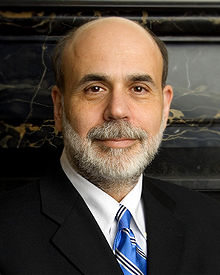
|
| Ben Bernanke |
For months, the Federal Reserve Chairman has been emphasizing that the Fed must obey two mandates: to maintain price stability and to minimize unemployment. Meanwhile, the dirty little secret among economists has been that unemployment is the main obstacle to inflation in the face of a massive enlargement of the money supply. Unemployment is currently at 7.1% and falling, while the Fed has lifted the veil of "transparency" to reveal it made a promise in double-speak to start selling some of the bonds it issued to combat the recession when unemployment reaches 6.5%. As time has gone on, Mr. Bernanke has seemed to back away from that promise. He is not so sure that unemployment is a good measure of unemployment, other measures may be a better measure of what we are driving at. He never meant to start selling bonds when unemployment reached 6.5%, he only meant that he might reduce the number he planned to buy. He never meant to make a promise, he only was being transparent about the current thinking of the Board. And anyway, Janet Yellen will take over his job in a month, so you can't very well bind your successor to do anything at all. What's this tap-dancing all about?
Well, it simply won't do, to suggest that the Federal Reserve isn't as independent of politics as it pretends to be. But everyone noticed that the stock market had a bad fainting spell when he suggested a few months ago that the Board had been discussing the matter; just imagine what it would do if he actually made a promise to act, let alone actually taking an action. By itself, such an announcement would probably send interest rates on a rise toward normal levels. The stock market mostly anticipates the future, so it would jump ahead of whatever action was taken. Since the United States is now the largest debtor on earth, a rise of interest rates would immediately add huge amounts to the current deficit and the projected national debt. The stock market would almost surely drop, possibly severely, in response to such commotion in the debt markets. And the national economy would certainly feel the deflationary effect of such activity in the financial markets, sending markets even lower. Fear of such a reaction would surely persist longer than the real need for monetary easing, making the resultant inflation even worse than it had to be.
 Is it possible the Obama Administration prefers a little extra unemployment, to risking a stock market crash before a coming election? 
|
| Minimum Wage Uproar |
In an era of desperate experimentation with the simultaneous solutions of several problems at once, perhaps the best conservative response to this paper is to seek ways to relax its inflexibility. The political process, particularly the amendment of state constitutions, is a lengthy and cumbersome impediment to agile management of the economy. It is fairly unlikely that a secret springing of a referendum trap can be repeated. The greater risk is that we will know what should be done, but become unable to do it quickly.
Meanwhile, the politicians are designing things and politicians like things simple. The Republican solution is to pass a minimum wage, but keep its benefit slightly below the entry-level wage; they get credit for passing it, but it has almost no applicability. The Democrat approach is to make a big noise about passing a meaningless bill, promising they will make it up with off the balance sheet entitlements, like health care and college tuition. Either way, usually nothing much happens after the election is over.
Running for the Assembly, Only in Philadelpia
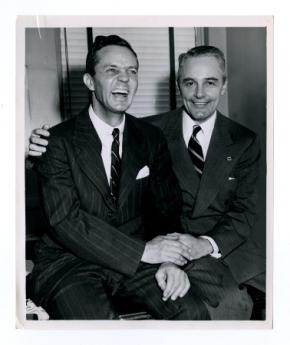
|
| Joseph Clark and Richardson Dilworth |
When I had to confess my defeat (by 5%) at a local club in Philadelphia that I belong to, I had to tell the group why I had been running for the Assembly. Finally, one friend with a puzzled look asked, "I never heard of running for election to the Assembly. I always thought membership was inherited."
Another friend had to tell him that it wasn't that Assembly, with dancing and all, it was the political one in New Jersey.
Only in Philadelphia, could you imagine such a conversation.
| Posted by: Paul.Freedman | Jan 12, 2013 9:09 PM |
50 Blogs
Ruminations About the Children's Education Fund (3)
 By selecting children for scholarships by lottery, it emerges that different schools make big differences.
By selecting children for scholarships by lottery, it emerges that different schools make big differences.
U.S. Army Corps of Engineers in the Delaware Valley
 The Delaware division of the Corps of Engineers is dwindling away. The engineers don't know nuttin', but they say on the street, Jimmy Carter did it.
The Delaware division of the Corps of Engineers is dwindling away. The engineers don't know nuttin', but they say on the street, Jimmy Carter did it.
Wistar Institute, Spelled With an "A"
 The Wistar Institute is properly pronounced "Wister", but in fact it's all the same family. Its fame in biomedical research makes that quite irrelevant.
The Wistar Institute is properly pronounced "Wister", but in fact it's all the same family. Its fame in biomedical research makes that quite irrelevant.
Musical Theatre at the 11th Hour
 There are 1200 theatrical companies in Philadelphia, but only one devoted to musicals. Does that say something about the audiences, the unions, or the musicians?
There are 1200 theatrical companies in Philadelphia, but only one devoted to musicals. Does that say something about the audiences, the unions, or the musicians?
Wizards of the Wissahickon
 The Kelpius Society of Philadelphia is "Dedicated to the study and restoration of the 1694 settlement of the 'Hermits of the Wissahickon' and their goals of community, peace, and brotherhood."
The Kelpius Society of Philadelphia is "Dedicated to the study and restoration of the 1694 settlement of the 'Hermits of the Wissahickon' and their goals of community, peace, and brotherhood."
John Marshall Decides Three Cases
 Marbury v Madison (1803), Martin v Hunter's Lessee (1816), and McCullough v Maryland (1819) -- these three cases were the ones where John Marshall changed judicial history. Taught in law school as case law, they are more accurately moments of national history.
Marbury v Madison (1803), Martin v Hunter's Lessee (1816), and McCullough v Maryland (1819) -- these three cases were the ones where John Marshall changed judicial history. Taught in law school as case law, they are more accurately moments of national history.
"They Don't Make That, Anymore"
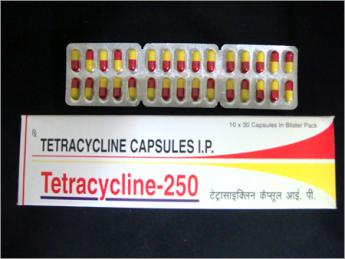 Pharmaceutical drugs seem to follow a trajectory of fifty years, from new and expensive, to cheap, old and eliminated.
Pharmaceutical drugs seem to follow a trajectory of fifty years, from new and expensive, to cheap, old and eliminated.
Mexican Immigration and NAFTA
 NAFTA was a brilliant innovation by Poppy Bush, but it was perhaps a little too sophisticated.
NAFTA was a brilliant innovation by Poppy Bush, but it was perhaps a little too sophisticated.
More, or Fewer, Raisins in the Pudding
 The primary sources of history are supposed to be factual. Tertiary history is mostly an interpretation of many primary bits.
The primary sources of history are supposed to be factual. Tertiary history is mostly an interpretation of many primary bits.
Museum of the American Revolution
 The old Visitors Center at Third and Chestnut has been vacant for more than a decade. Its new occupant is going to be a Museum dedicated to the causes and sacrifices of the American Revolution.
The old Visitors Center at Third and Chestnut has been vacant for more than a decade. Its new occupant is going to be a Museum dedicated to the causes and sacrifices of the American Revolution.
Peggy Shippen and Benedict Arnold: Fallen Idols
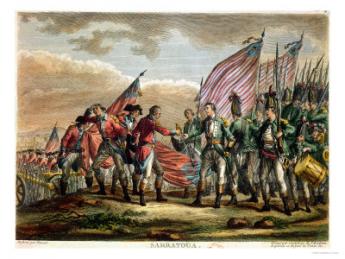 The hero of the Battle of Saratoga married the Queen of Philadelphia society, but then betrayed the country.
The hero of the Battle of Saratoga married the Queen of Philadelphia society, but then betrayed the country.
Implicit Powers of the Federal Government
 The Constitution strictly limited the number of federal powers, but did not define their boundaries. Intending to be flexible, it opened a permanent loophole.
The Constitution strictly limited the number of federal powers, but did not define their boundaries. Intending to be flexible, it opened a permanent loophole.
National Debt, Presidential Hat Tricks, Shale Gas and Argentina
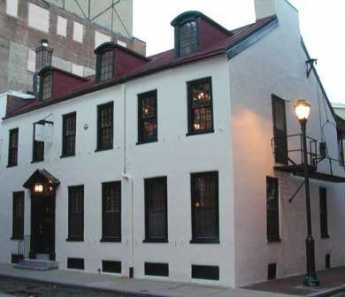 The Franklin Inn Club discusses Obama's maneuvers in the context of what might have been a better approach.
The Franklin Inn Club discusses Obama's maneuvers in the context of what might have been a better approach.
Sources of Revolutionary Populism
 A major source of growing populism among the aristocratic founding fathers was the aging of rebel boys into Revolutionary Veterans.
A major source of growing populism among the aristocratic founding fathers was the aging of rebel boys into Revolutionary Veterans.
Stretching Out Your Retirement Savings
 "Don't spend principal" is pretty good advice, except as retirement income starts to run low.
"Don't spend principal" is pretty good advice, except as retirement income starts to run low.
Why Jefferson Hated Banks and Hamilton Loved Them

Bretton Woods
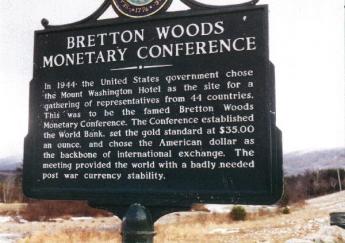 The Bretton Woods conference in 1944 was very simple. The U.S. dollar alone was convertible into gold, but all other currencies were convertible into U.S. dollars. To prevent Fort Knox from being completely depleted of gold, the convertibility of dollars into gold was also soon discontinued. Effectively, all money everywhere was thus just a computer notation, controlled by the U.S.government. Temporarily, the dollar became a reserve currency, supplementing gold. Effectively, we were testing whether we needed a metallic standard at all.
The Bretton Woods conference in 1944 was very simple. The U.S. dollar alone was convertible into gold, but all other currencies were convertible into U.S. dollars. To prevent Fort Knox from being completely depleted of gold, the convertibility of dollars into gold was also soon discontinued. Effectively, all money everywhere was thus just a computer notation, controlled by the U.S.government. Temporarily, the dollar became a reserve currency, supplementing gold. Effectively, we were testing whether we needed a metallic standard at all.
Bernanke's QE3: A New Titanic, or A New Bretton Woods?
 Ben Bernanke is crossing Niagara Falls on a tightrope.
Ben Bernanke is crossing Niagara Falls on a tightrope.
Federal Reserve Power Play
 Evidently, the Federal Reserve feels it never has to restore those bonds it holds to the private sector. The bond market may not stand for it, so hold your breath.
Evidently, the Federal Reserve feels it never has to restore those bonds it holds to the private sector. The bond market may not stand for it, so hold your breath.
Deficits Don't Matter When Your Party Is In Power
Krugman channels Cheney
The Wissahickon

Main Line: Overbrook to Paoli
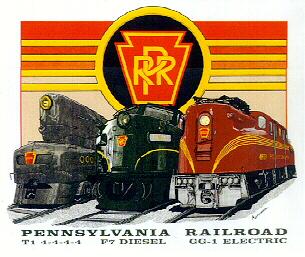 The Main Line was a spur of the Pennsylvania Railroad, connecting Philadelphia to what was the real main line, running north of Philadelphia from New York to Pittsburgh. Times change, the Main Line is a commuter railroad, and there is only one passenger train daily to Pittsburgh. Meanwhile, the real main line is called the Northeast Corridor, Boston to Washington DC.
The Main Line was a spur of the Pennsylvania Railroad, connecting Philadelphia to what was the real main line, running north of Philadelphia from New York to Pittsburgh. Times change, the Main Line is a commuter railroad, and there is only one passenger train daily to Pittsburgh. Meanwhile, the real main line is called the Northeast Corridor, Boston to Washington DC.
Army War College in Carlisle
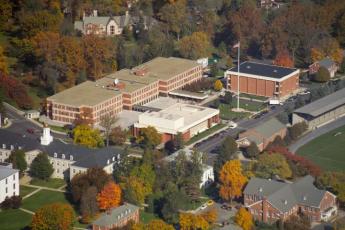 If you have been to Carlisle, PA, you have seen the Army War College, but you may not know much about it.
If you have been to Carlisle, PA, you have seen the Army War College, but you may not know much about it.
Adoption
 Although the Romans frequently adopted children, the practice died out in the 6th century, and only became common a thousand years later. Curiously little has been written about this matter, so speculation is probably unwise.
Although the Romans frequently adopted children, the practice died out in the 6th century, and only became common a thousand years later. Curiously little has been written about this matter, so speculation is probably unwise.
Cyprus Tests the Limits of Paper Money

Ruminations About the Cyprus Crash
 The importance of the Cyprus crash is not so much itself, as its potential consequences for others.
The importance of the Cyprus crash is not so much itself, as its potential consequences for others.
Stress Tests for the European Union
 Ending the Cold War in 1989 may have generated an unexpected obstacle to European unification.
Ending the Cold War in 1989 may have generated an unexpected obstacle to European unification.
Gold Standard Substitutes
 The monetary crisis which continues since 2007 keeps financiers searching for a better monetary system.
The monetary crisis which continues since 2007 keeps financiers searching for a better monetary system.
Proposal for the Parkway
 In 1986 the architect Alvin Holm proposed an amphitheater for the Parkway. It was too soon, but maybe its time is approaching.
In 1986 the architect Alvin Holm proposed an amphitheater for the Parkway. It was too soon, but maybe its time is approaching.
Glen Foerd, Torresdale, and the Feudal Industrial Style
 The owner of the many mansions of Glen Foerd was unabashedly nouveau riche, and like John Roebling, tolerated no threat to the Imperial style of industrial organization.
The owner of the many mansions of Glen Foerd was unabashedly nouveau riche, and like John Roebling, tolerated no threat to the Imperial style of industrial organization.
Gas House, the Real Thing
 Gas Houses have disappeared, and what remains is Leo Durocher's phrase for the St. Louis Cardinals: gashouse gang. But gas houses were a real thing, and one even survives at Glen Foerd, the Foederer estate.
Gas Houses have disappeared, and what remains is Leo Durocher's phrase for the St. Louis Cardinals: gashouse gang. But gas houses were a real thing, and one even survives at Glen Foerd, the Foederer estate.
Societies and Clubs
 Most of us recognize no difference between a Society, and a Club. But essentially, a club must not discriminate in admitting members, but a society can do so. You will have to ask a lawyer to explain that.
Most of us recognize no difference between a Society, and a Club. But essentially, a club must not discriminate in admitting members, but a society can do so. You will have to ask a lawyer to explain that.
George Mason and Triumvirates
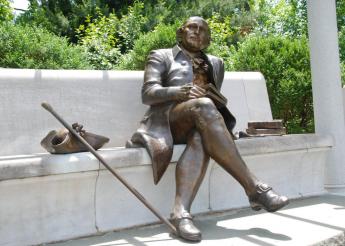
Philadelphia to Savannah: A New View
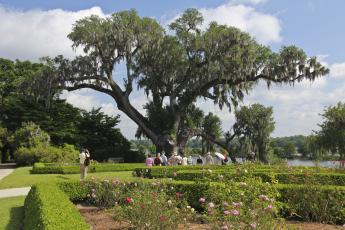 Two members of Right Angle took a vacation trip to Savannah. It seems to be a new world, down there.
Two members of Right Angle took a vacation trip to Savannah. It seems to be a new world, down there.
Barnes Foundation -- Drawing a New Moral
 Inflation makes for a new slant on the saga of the Barnes Foundation.
Inflation makes for a new slant on the saga of the Barnes Foundation.
Taming the Creeks of Olde Philadelphia
 Located between two rivers, with a small mountain separating them, Philadelphia has found its abundant water supply to be a blessing, and a burden.
Located between two rivers, with a small mountain separating them, Philadelphia has found its abundant water supply to be a blessing, and a burden.
Psychiatry: Last Cow in Philadelphia
 Daniel Blain, just about the most famous psychiatrist in America, lived at 20th and Olney, West. Not only was that the place he lived, but he also kept a cow there. And this was within living memory.
Daniel Blain, just about the most famous psychiatrist in America, lived at 20th and Olney, West. Not only was that the place he lived, but he also kept a cow there. And this was within living memory.
Dept. Defense vs. Dept. State
 Differences in manning policy make serious friction when our national interests are abroad.
Differences in manning policy make serious friction when our national interests are abroad.
The Accounting of Natural Capital
 The vice president of an English firm explains how the external costs to the environment should be part of company accounting.
The vice president of an English firm explains how the external costs to the environment should be part of company accounting.
A Doctor's Toast to His Patients
 Every once in a while, the doctor ought to thank his patients.
Every once in a while, the doctor ought to thank his patients.
Hadoop and Big Data in Medicine
.jpg)
Spending Accounts into Savings Accounts for Retirement? Don't Count On It.
 Flexible Spending Accounts, unlike Health Savings Accounts, have a use-it-or-lose-it feature. New regulations now permit FSAs to roll-over $500 per year to later years. Astounding things become possible that were previously impossible if this conversion could be extended to more than a single year.
Flexible Spending Accounts, unlike Health Savings Accounts, have a use-it-or-lose-it feature. New regulations now permit FSAs to roll-over $500 per year to later years. Astounding things become possible that were previously impossible if this conversion could be extended to more than a single year.
Looming Early Issues in Obamacare
 Obamacare is constructed from the regulations issued by the Secretary of Health and Human Services. They respond to the laws passed by Congress which were two thousand pages long. After two years, only the outlines of this program are known. What are the looming issues?
Obamacare is constructed from the regulations issued by the Secretary of Health and Human Services. They respond to the laws passed by Congress which were two thousand pages long. After two years, only the outlines of this program are known. What are the looming issues?
Critical Number for Retirement Planning
 There are a zillion factors involved in answering the common question: how much is enough to retire on. We propose that one number is central to any such analysis, for everybody. And it's reasonably easy to estimate.
There are a zillion factors involved in answering the common question: how much is enough to retire on. We propose that one number is central to any such analysis, for everybody. And it's reasonably easy to estimate.
Higher-cost Health Insurance is What's Mandatory
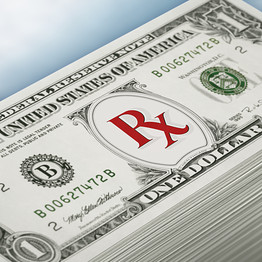 Cancellations of millions of health insurance policies show the Affordable Care Act aimed to mandate a few specific types of policies, and not merely to the uninsured. Without a government subsidy, most plans would cost more. The promise that you can keep your old plan, and keep your doctor, was an empty one.
Cancellations of millions of health insurance policies show the Affordable Care Act aimed to mandate a few specific types of policies, and not merely to the uninsured. Without a government subsidy, most plans would cost more. The promise that you can keep your old plan, and keep your doctor, was an empty one.
The Meaning of Freedom
 To a considerable extent, Libertarians and Tea Partiers are speaking of freedom from an employer when they celebrate American freedom.
To a considerable extent, Libertarians and Tea Partiers are speaking of freedom from an employer when they celebrate American freedom.
Yard Signs
 It is hard to know whether yard signs do any good, but they are part of the election ceremony.
It is hard to know whether yard signs do any good, but they are part of the election ceremony.
Minimum Wage Fangdoodle
 While no one was looking, mandating a minimum wage turned into a contrivance to maintain low-interest rates.
While no one was looking, mandating a minimum wage turned into a contrivance to maintain low-interest rates.
Running for the Assembly, Only in Philadelpia
 Except for Clarke and Dillworth, Philadelphia social leaders haven't had much to do with politics for a century.
Except for Clarke and Dillworth, Philadelphia social leaders haven't had much to do with politics for a century.